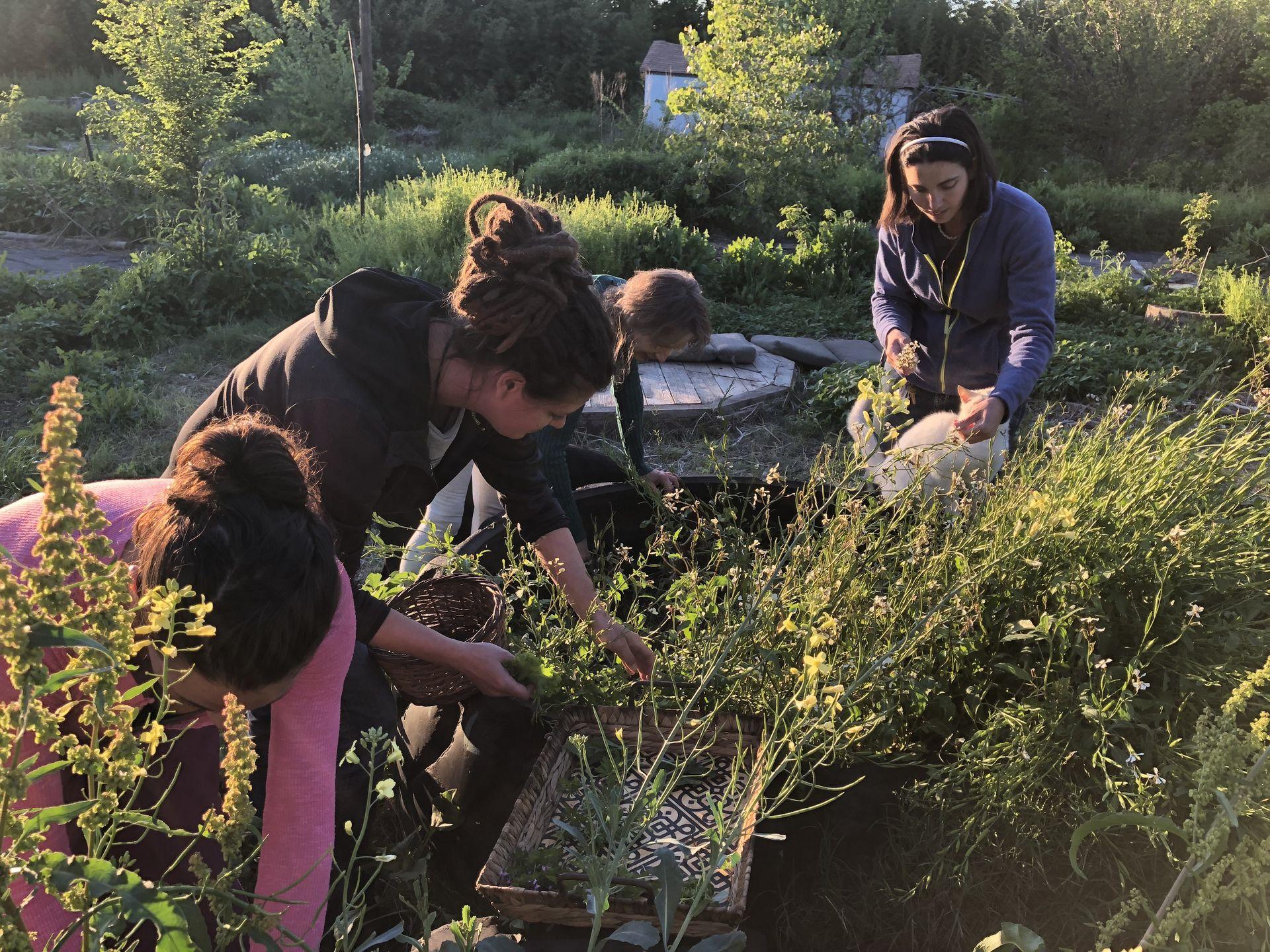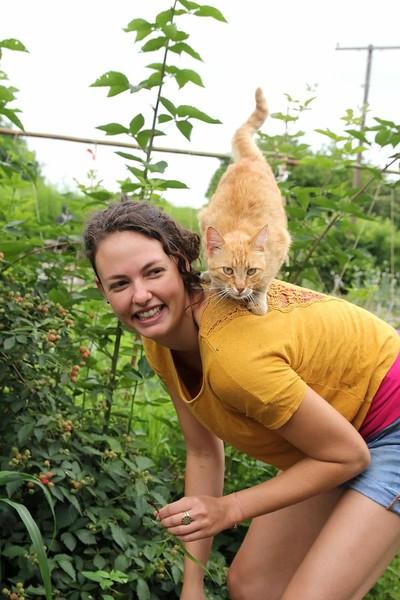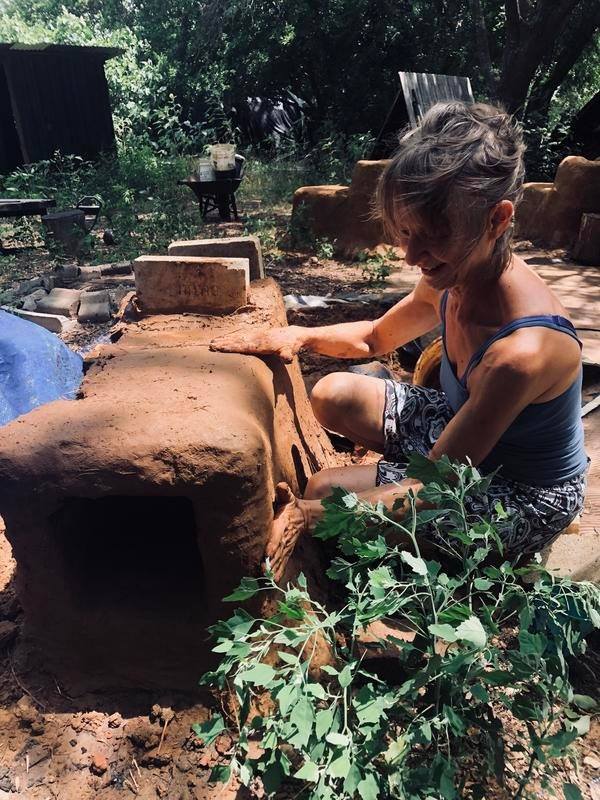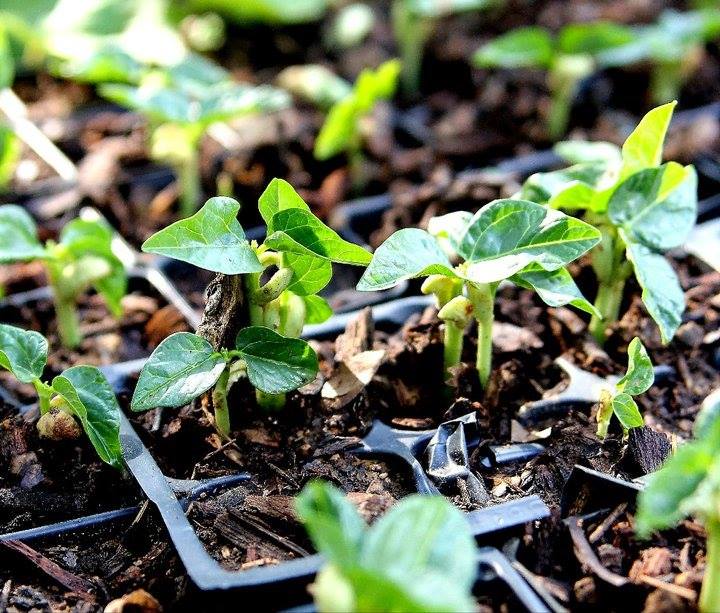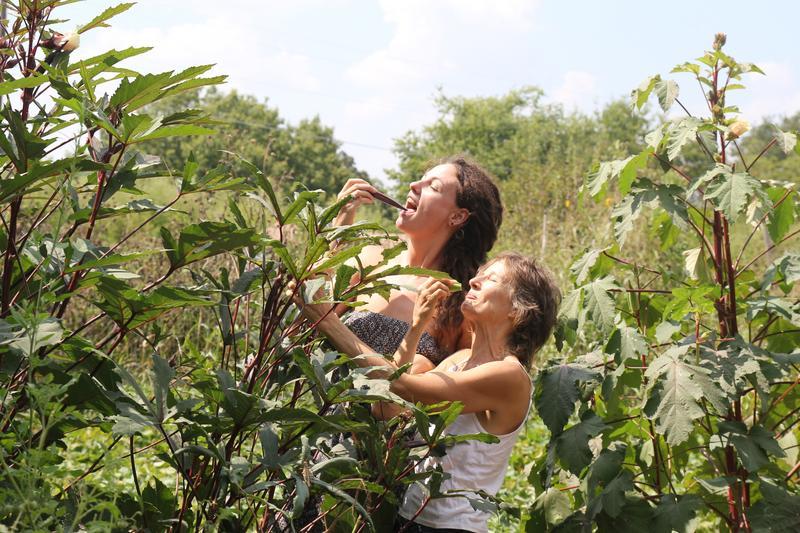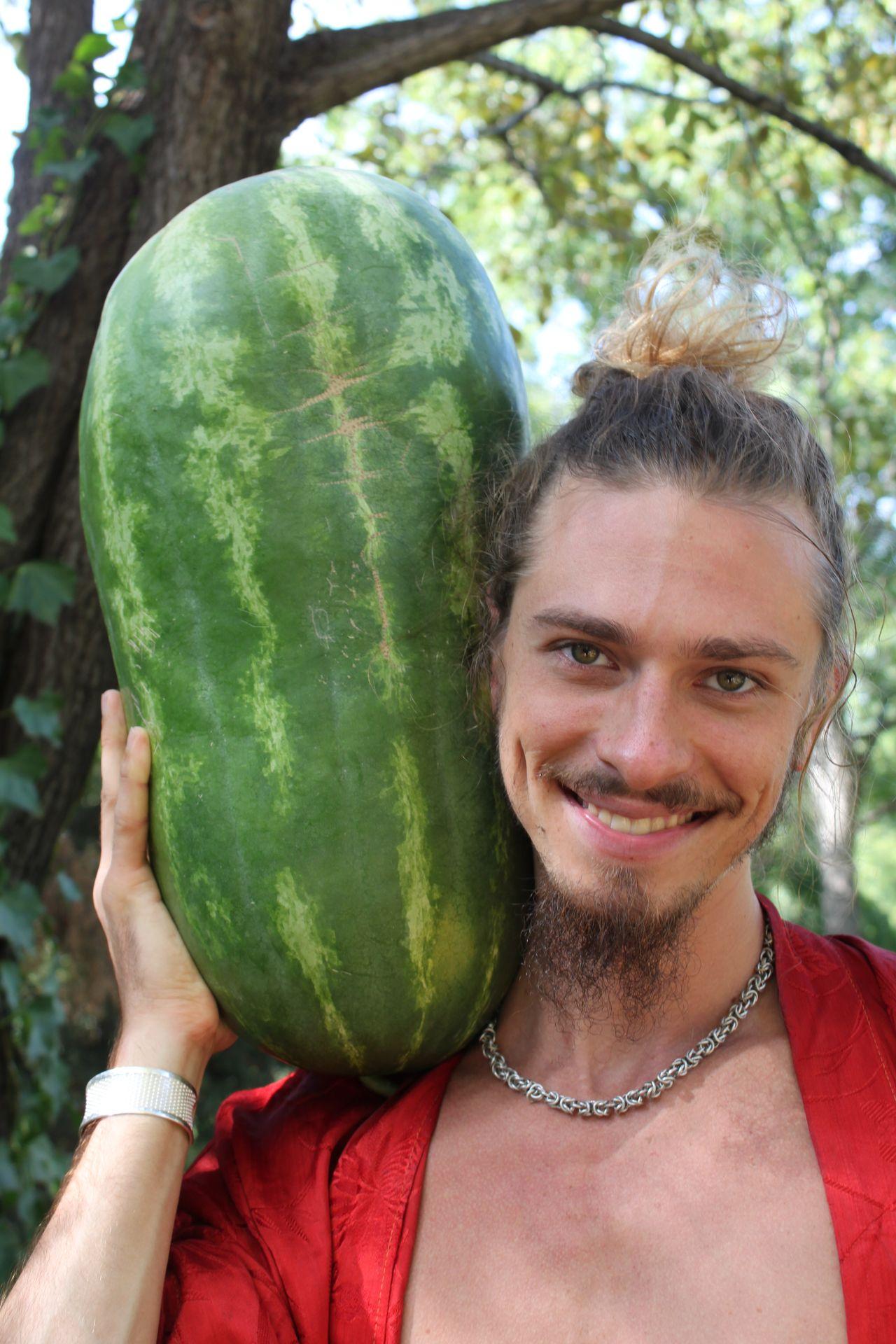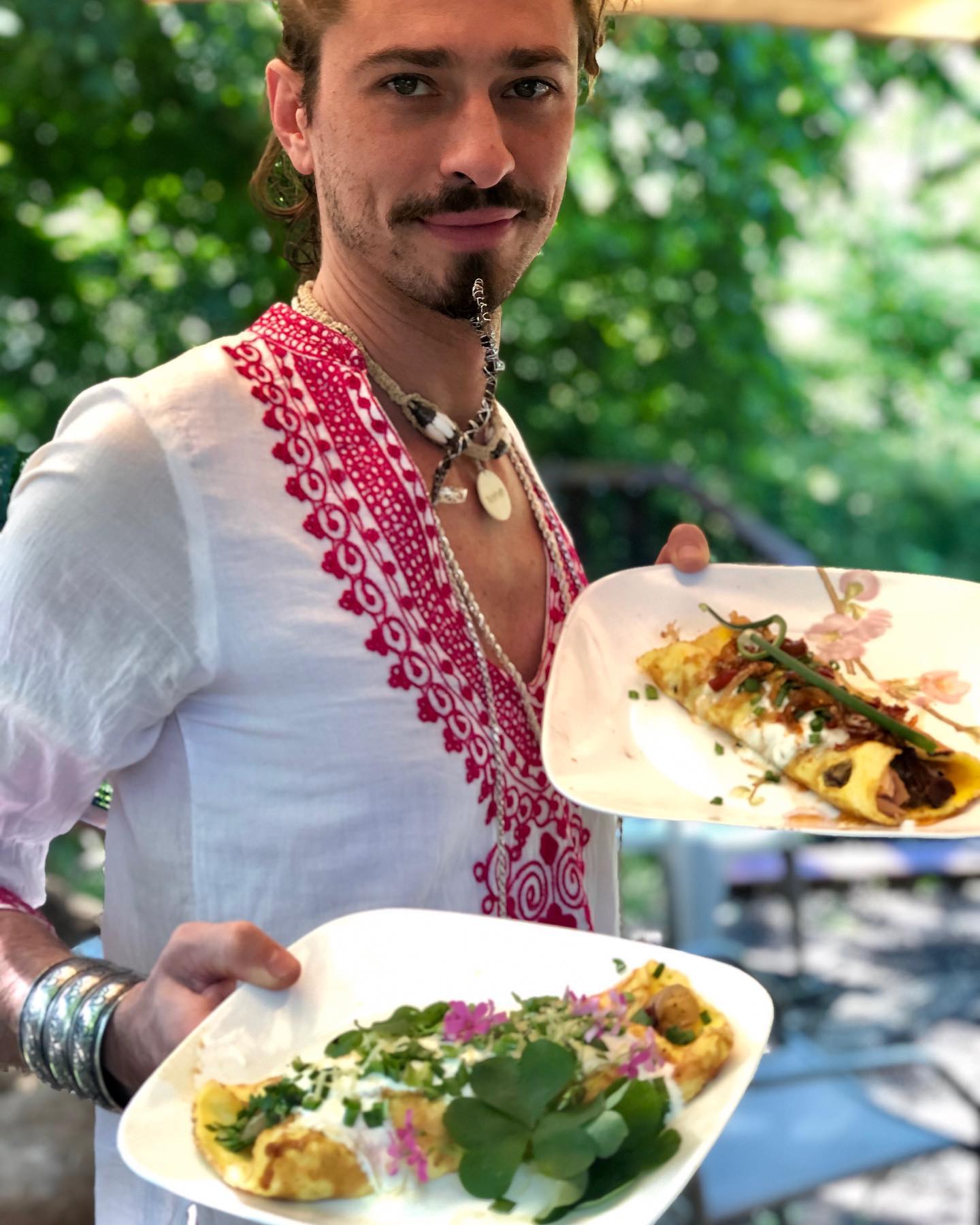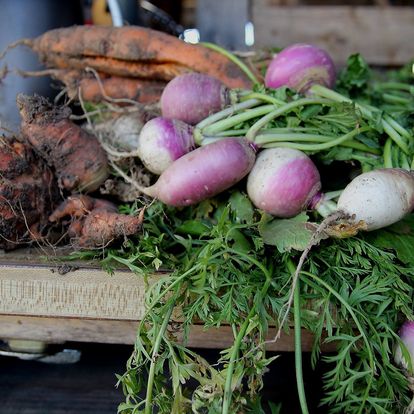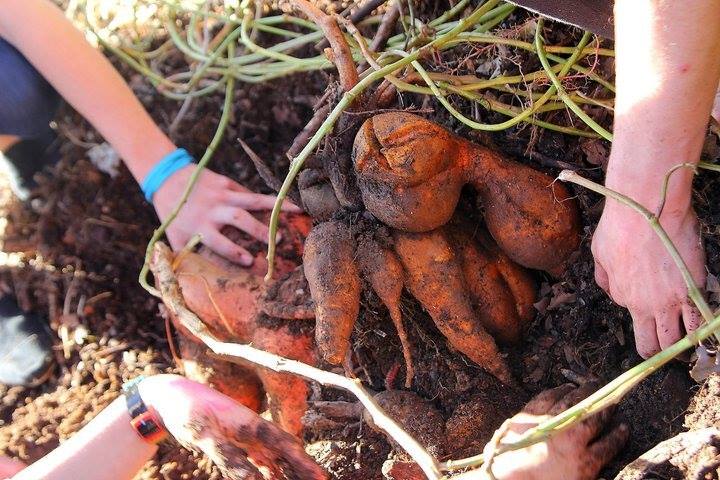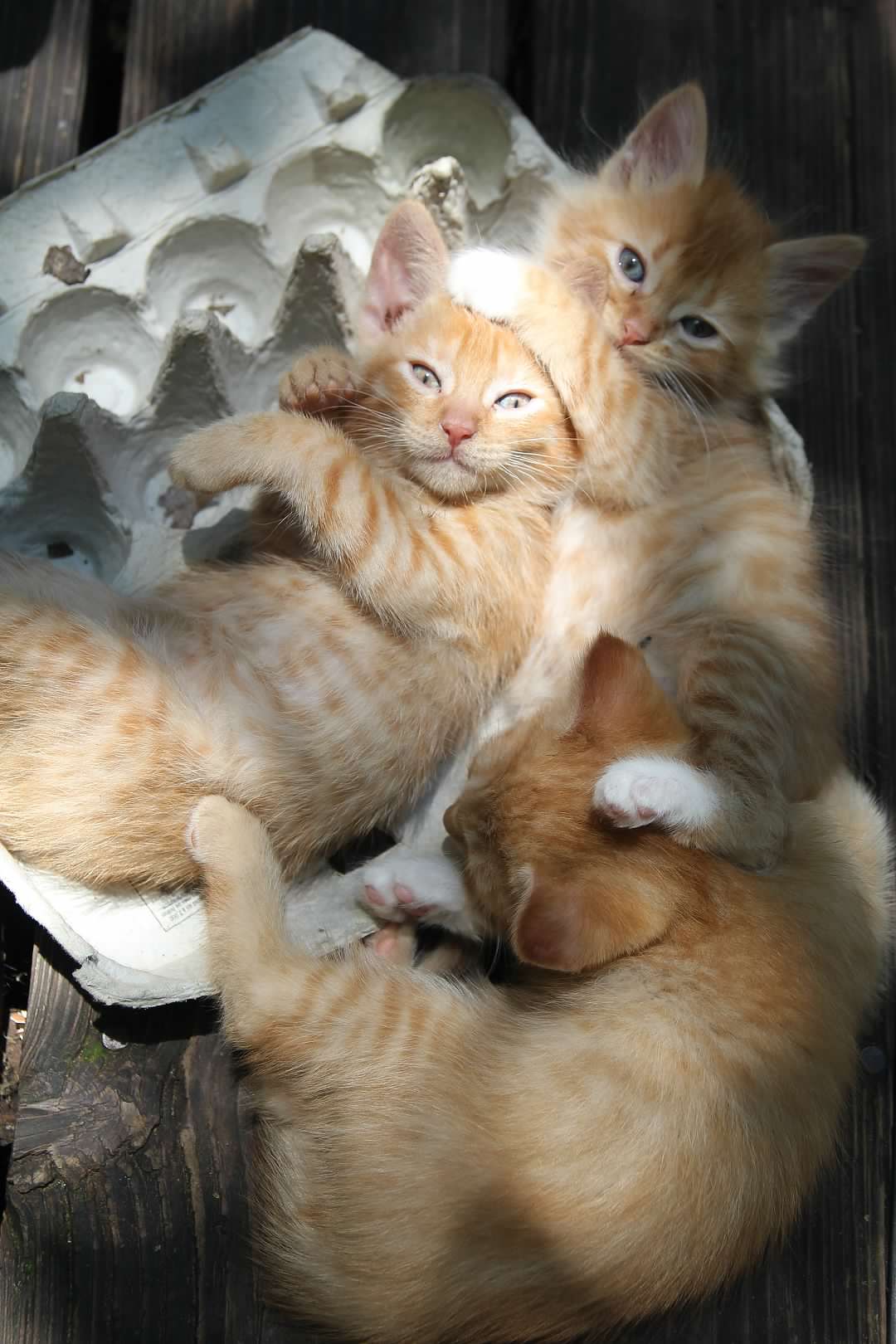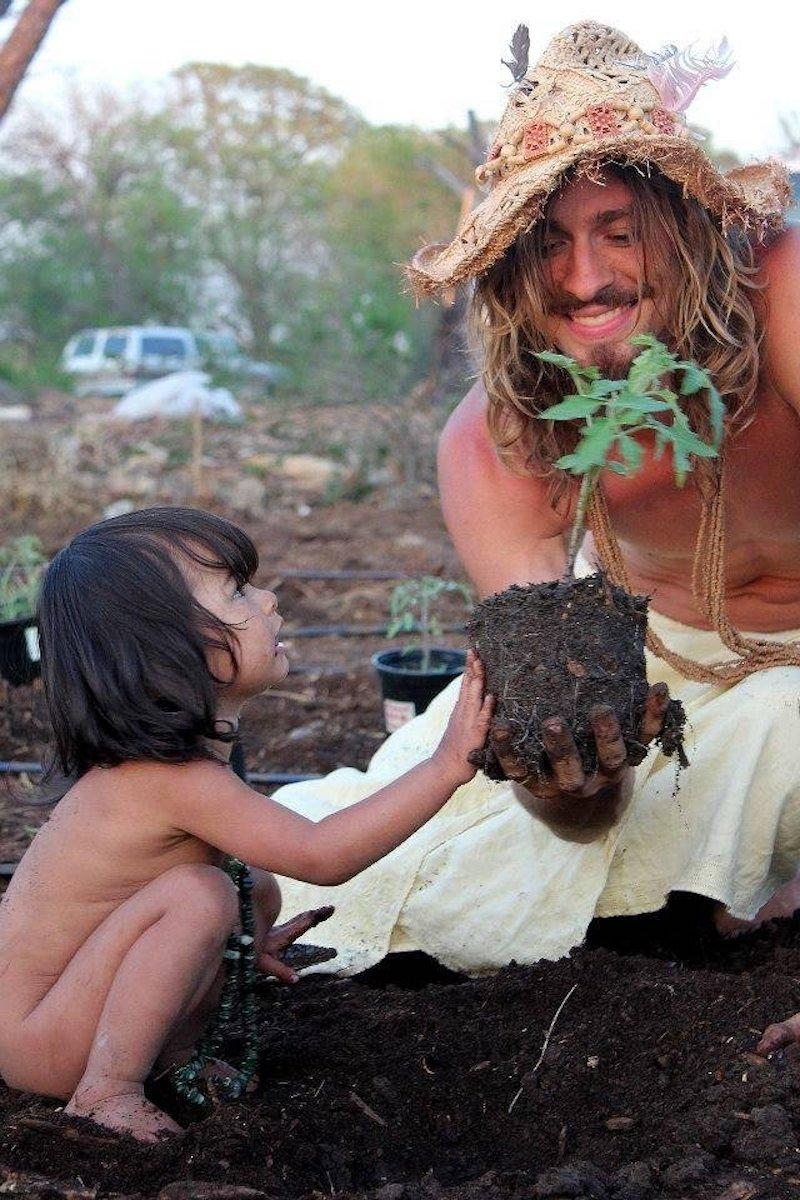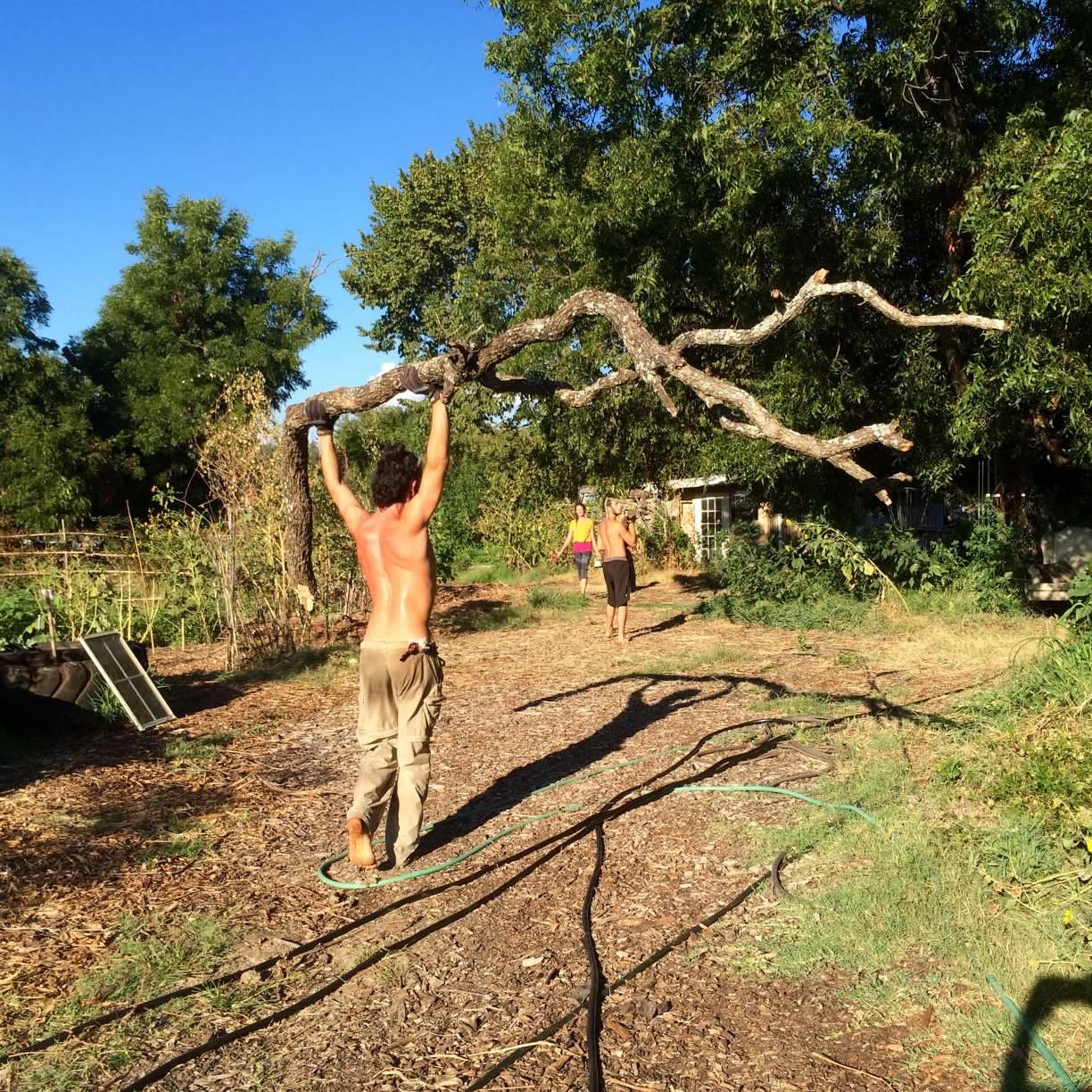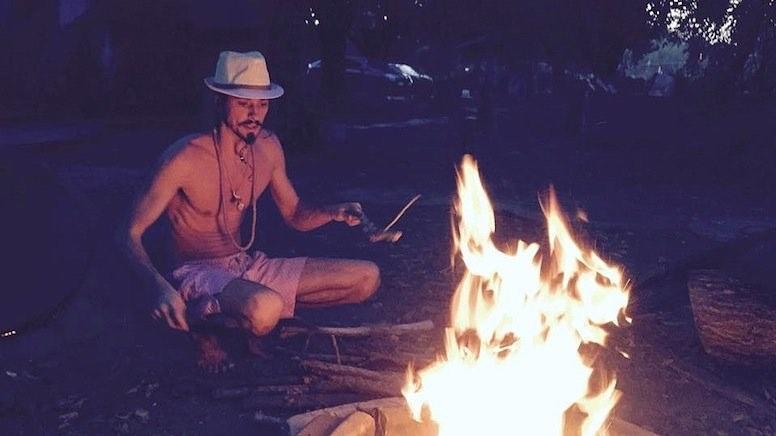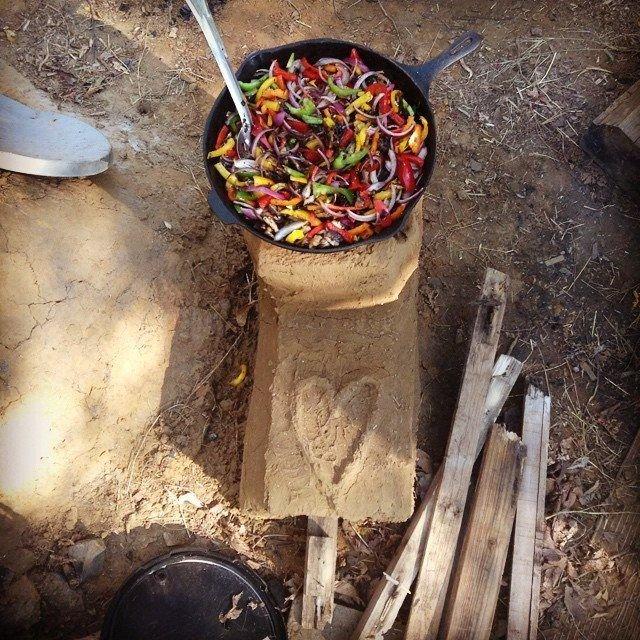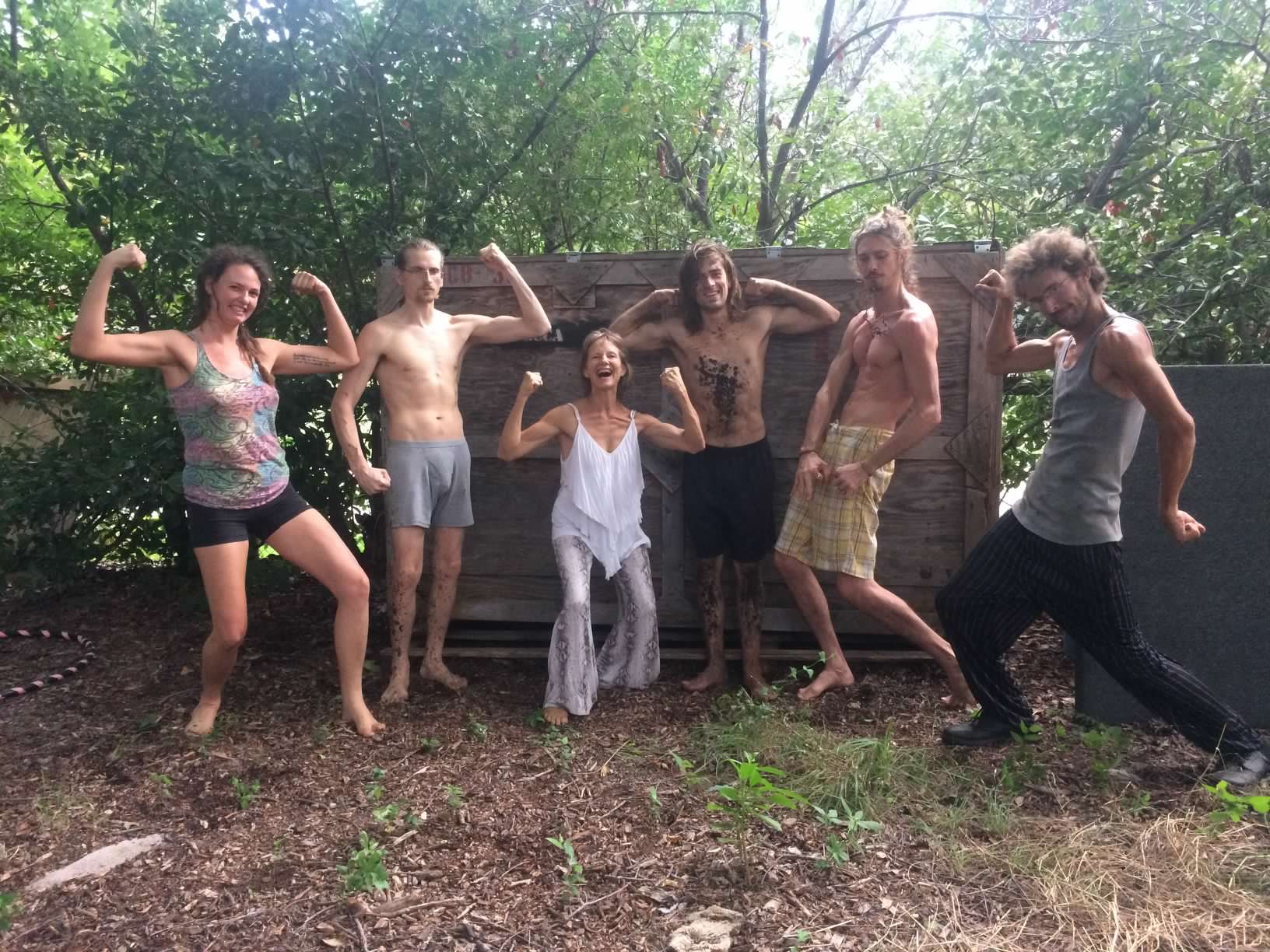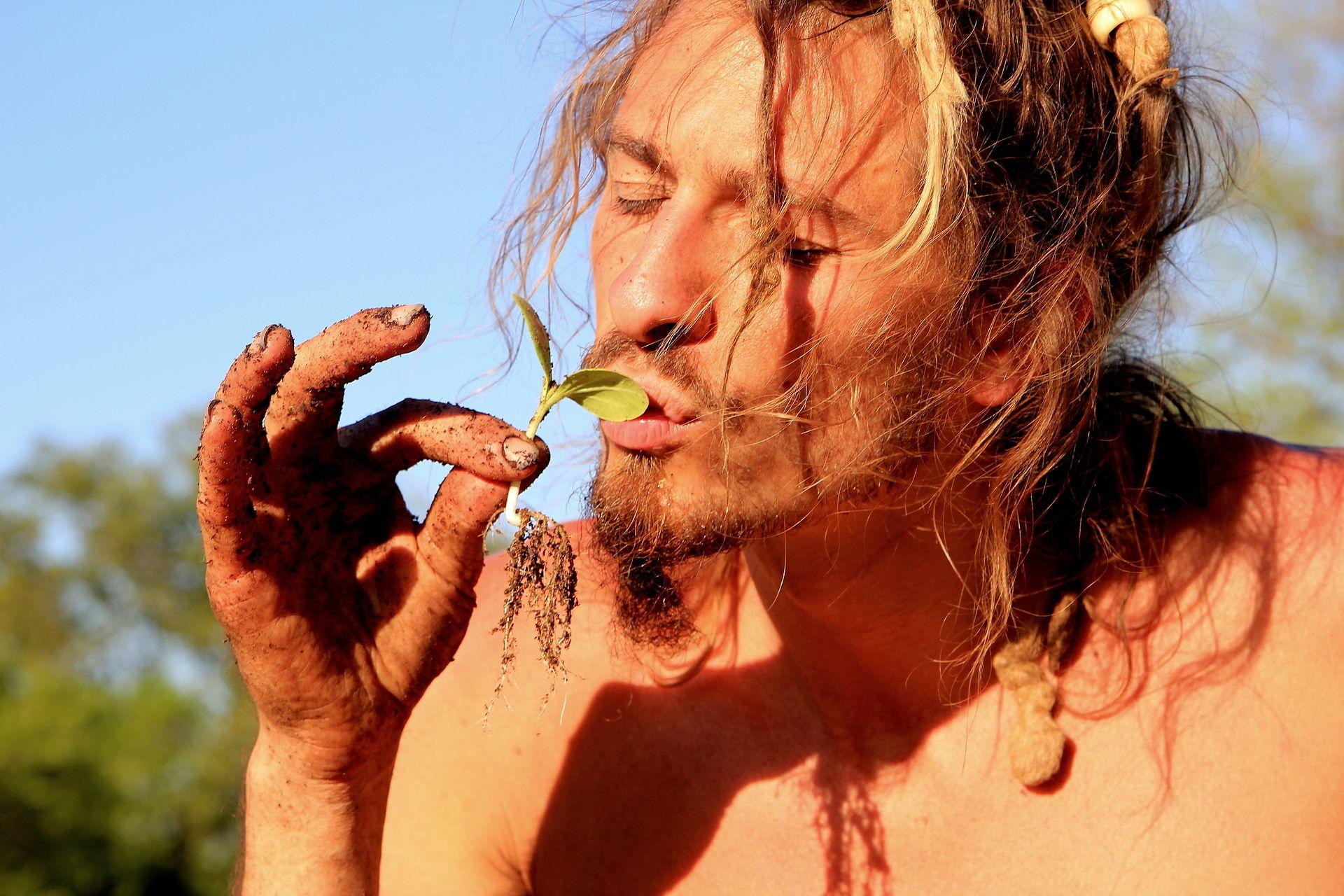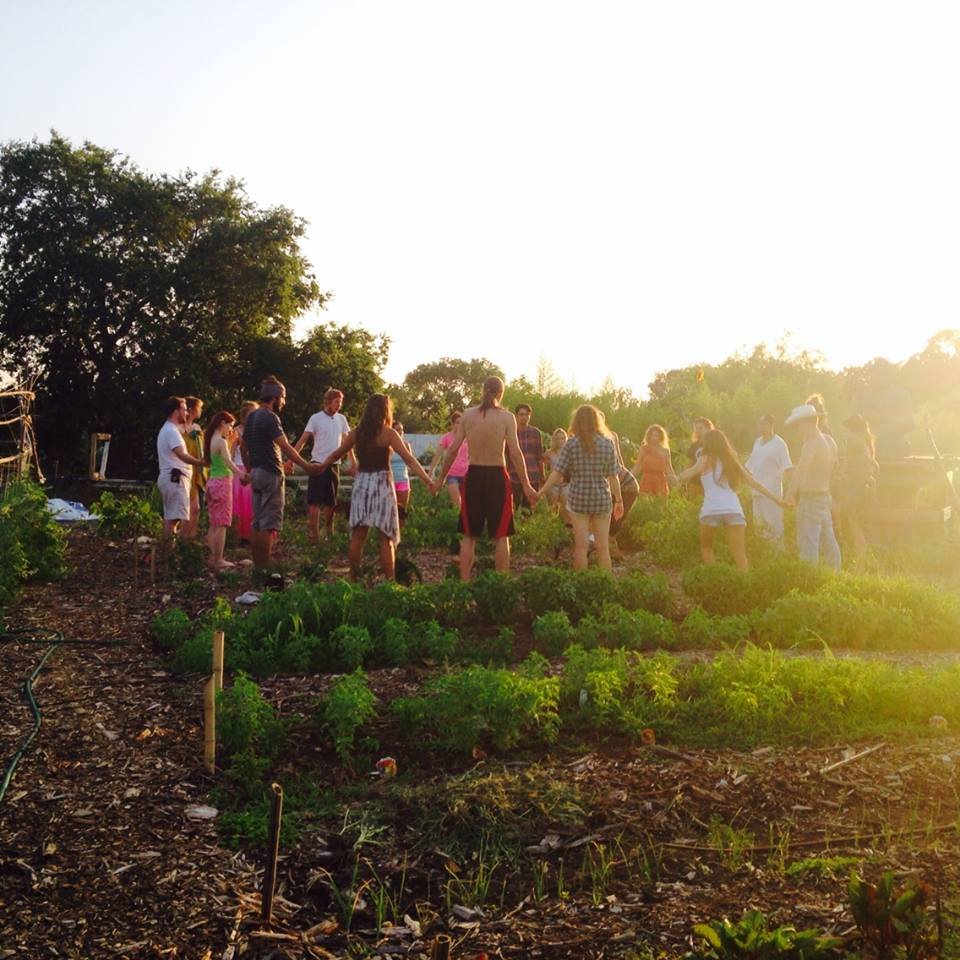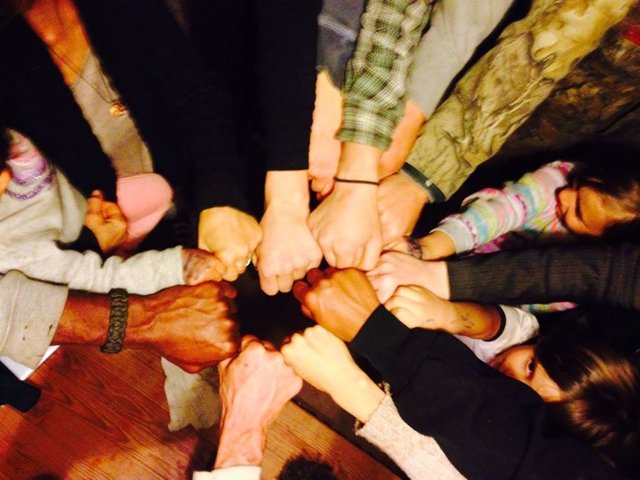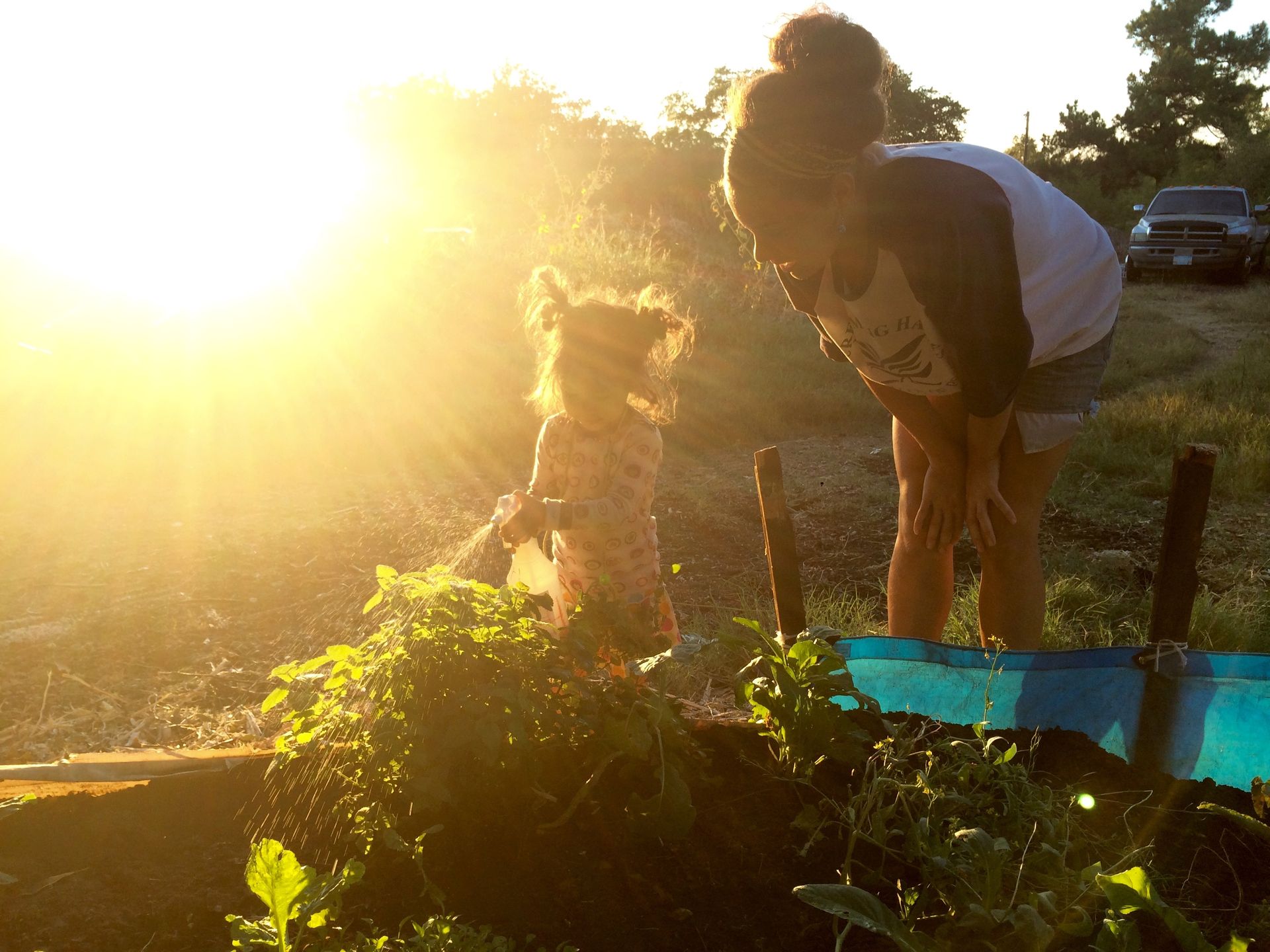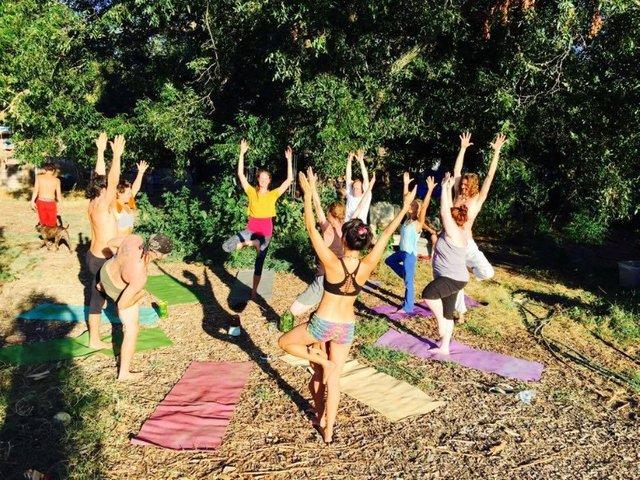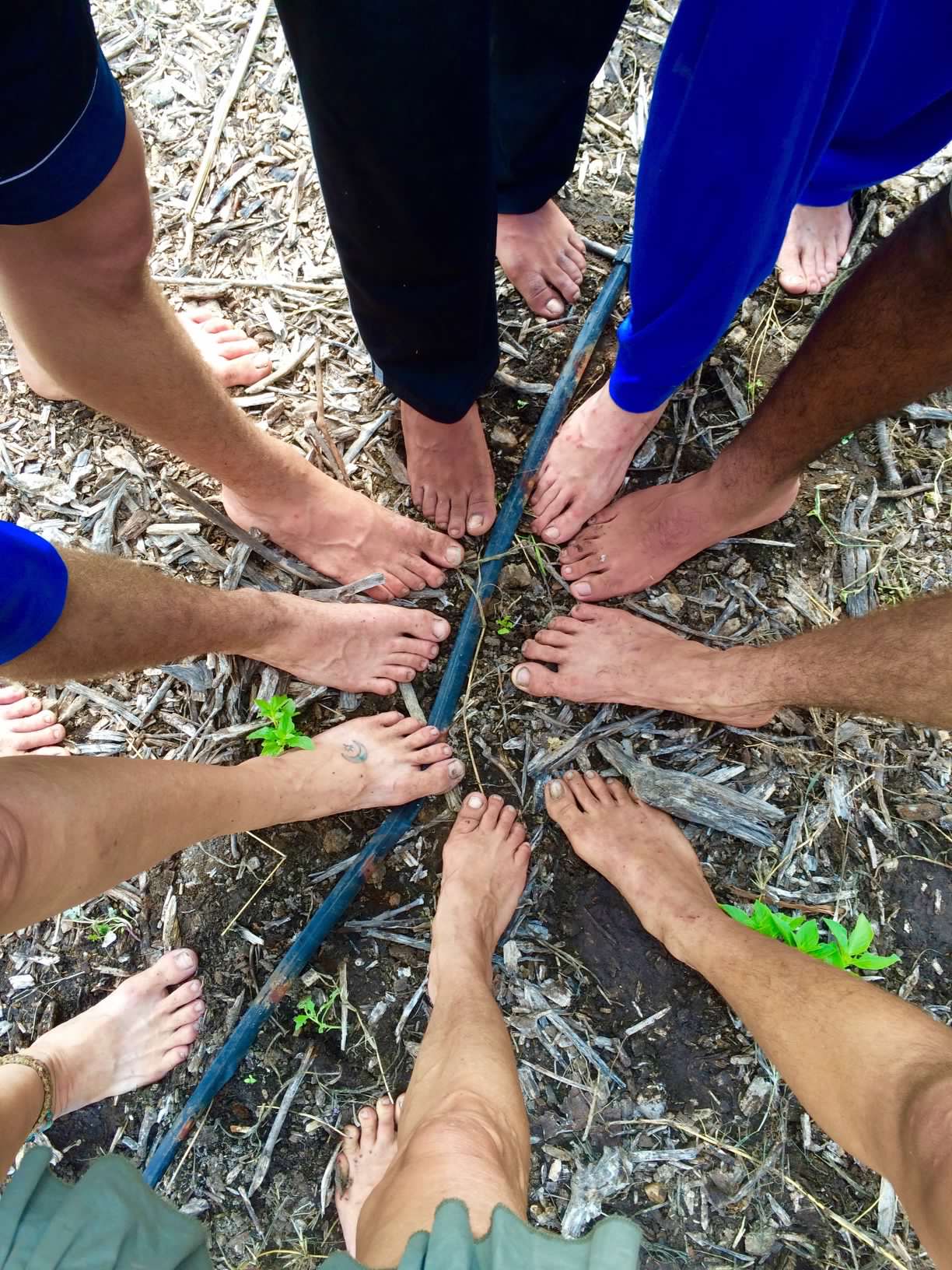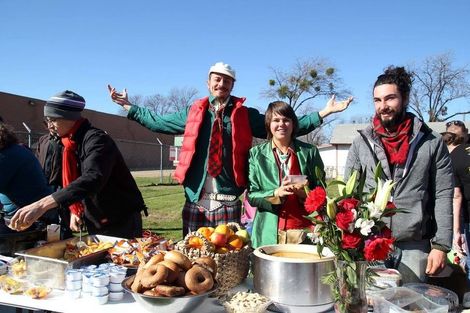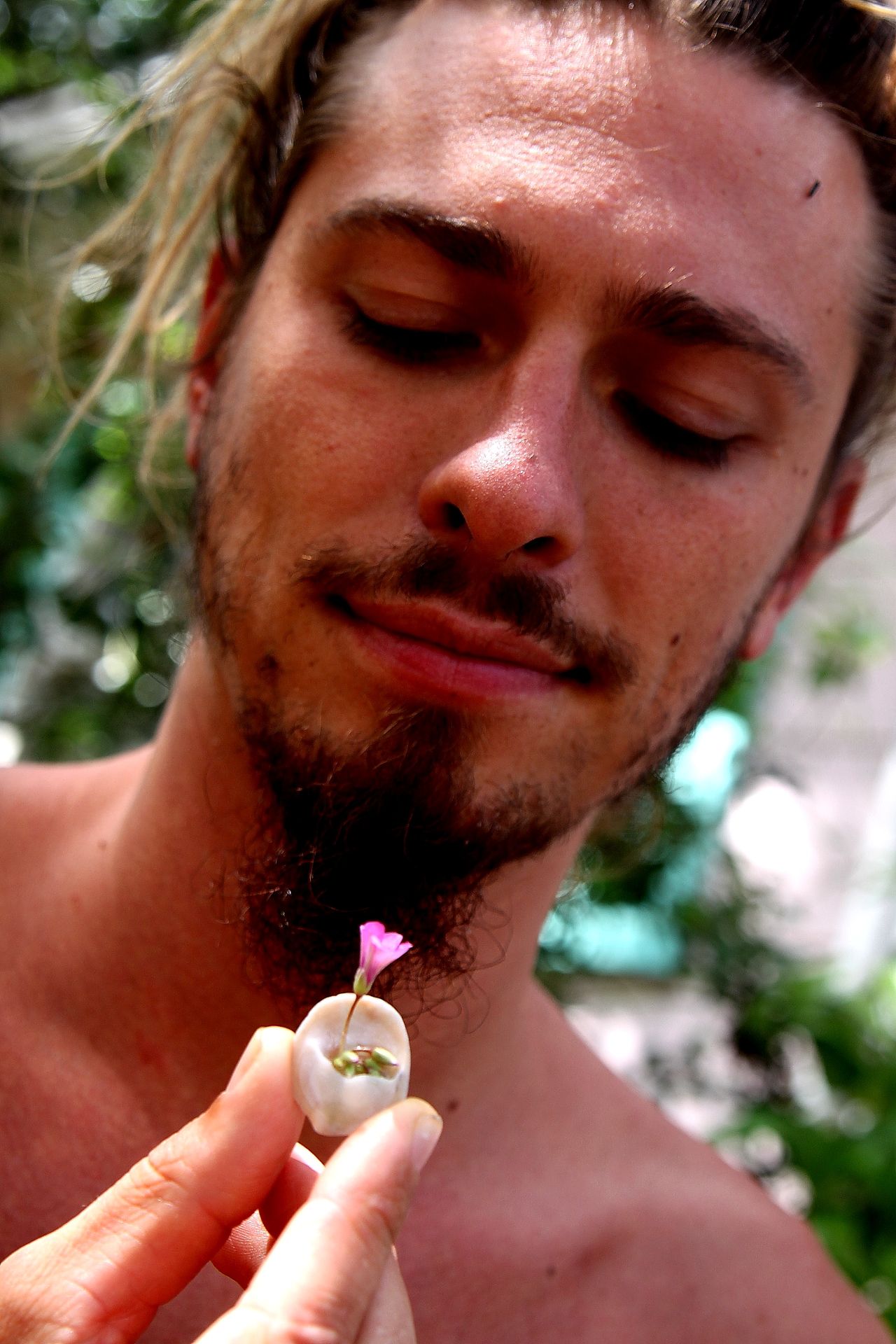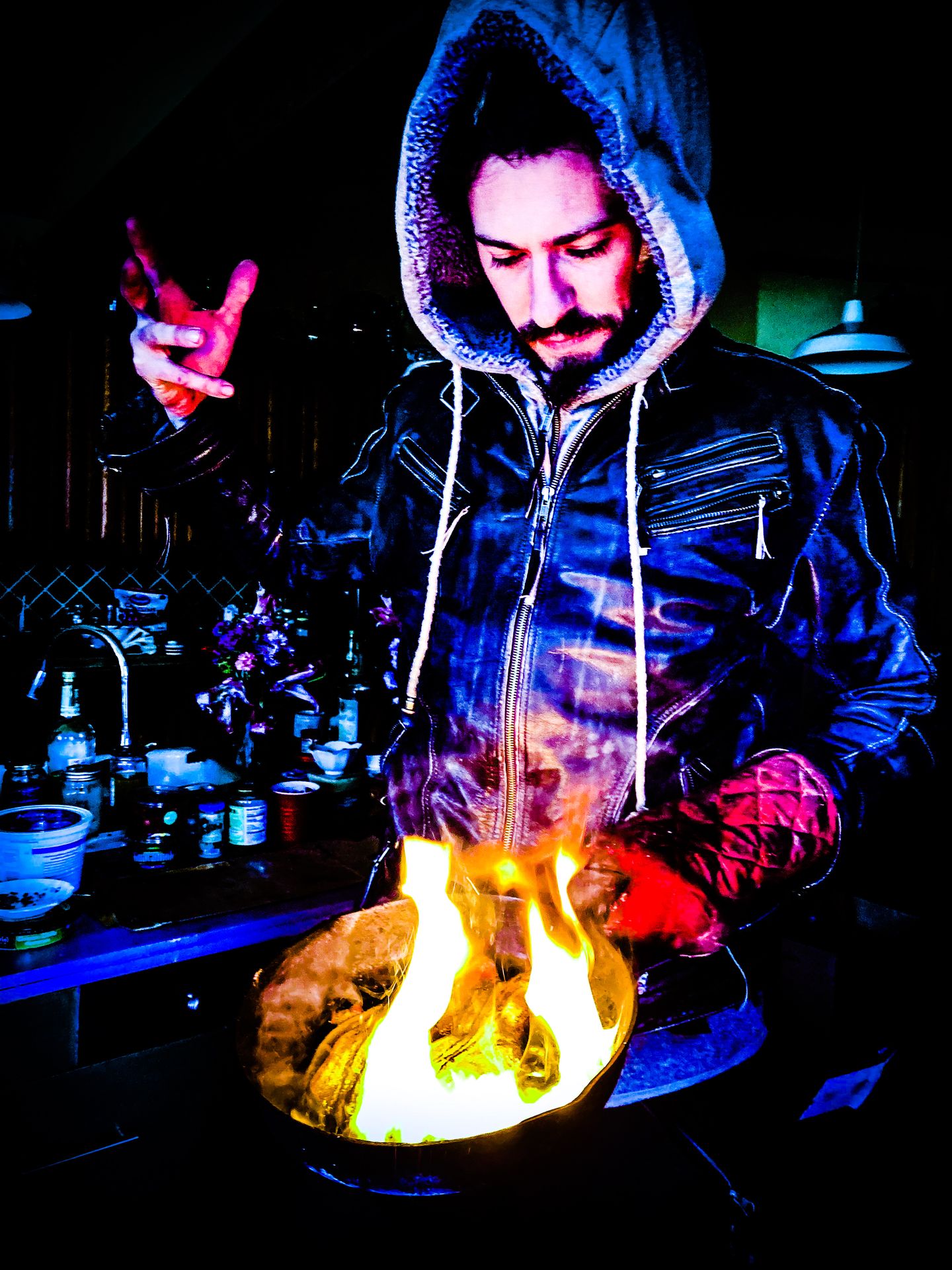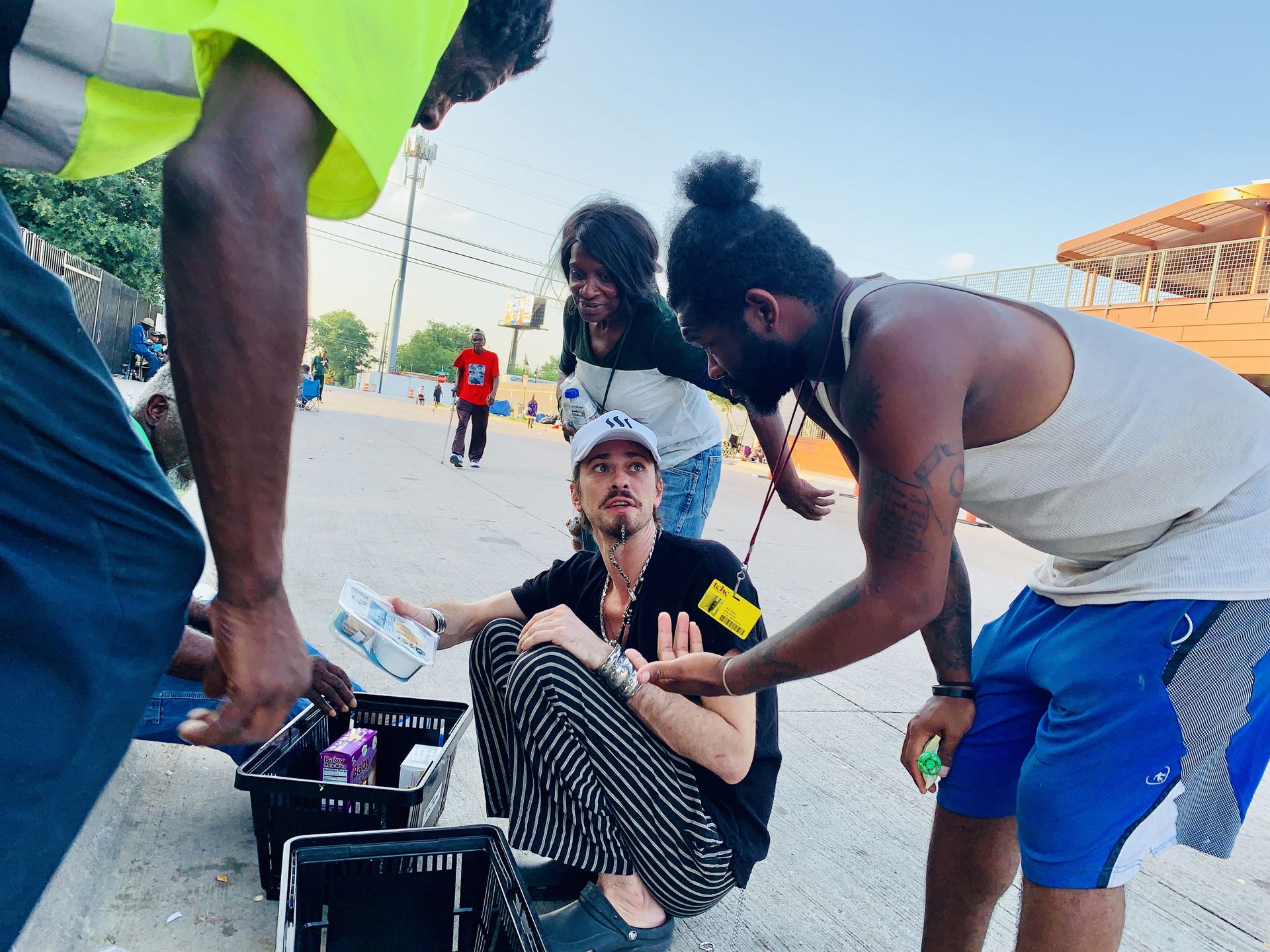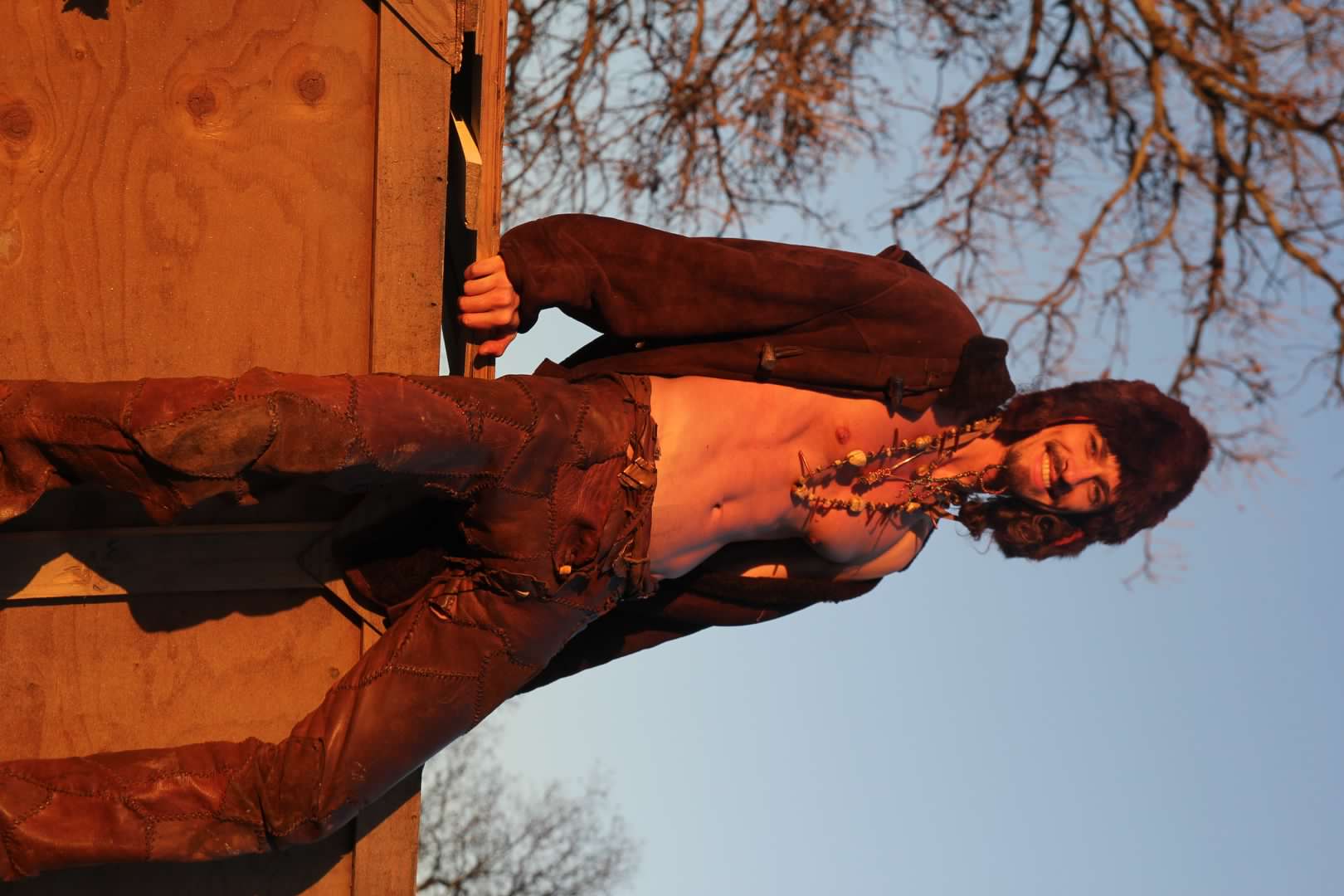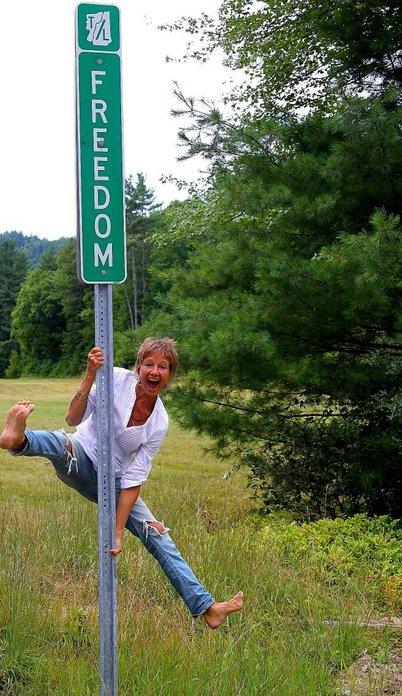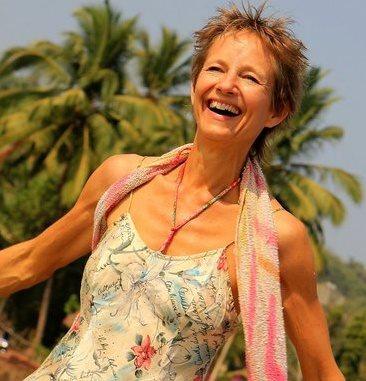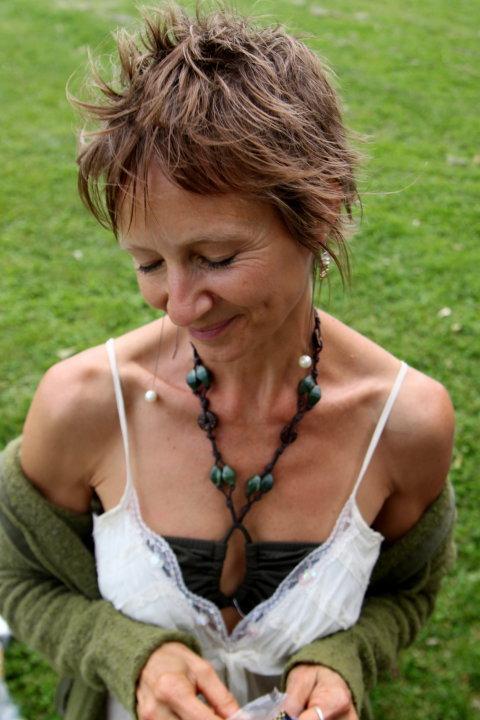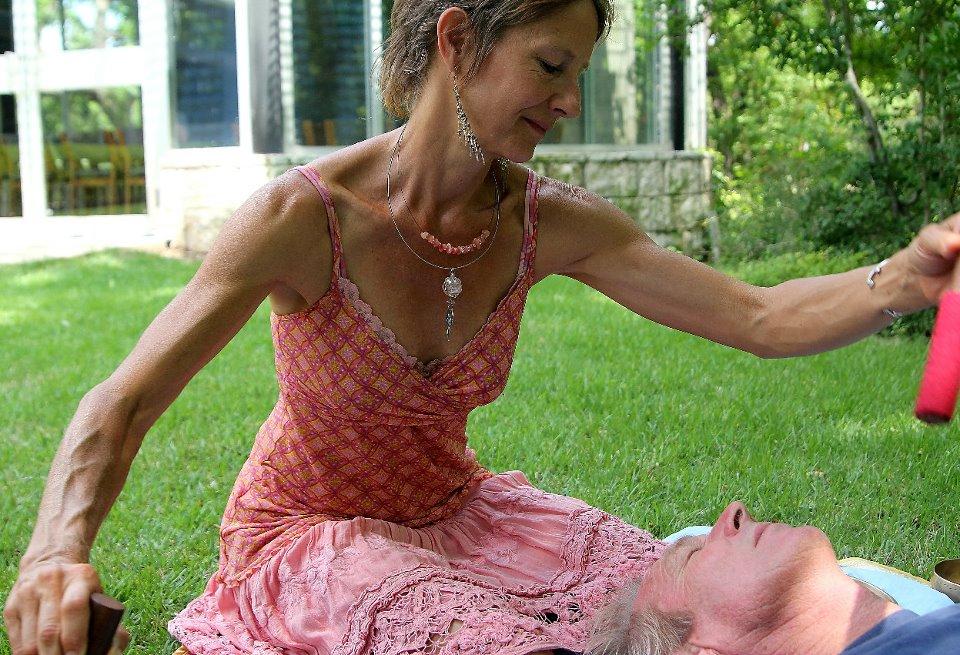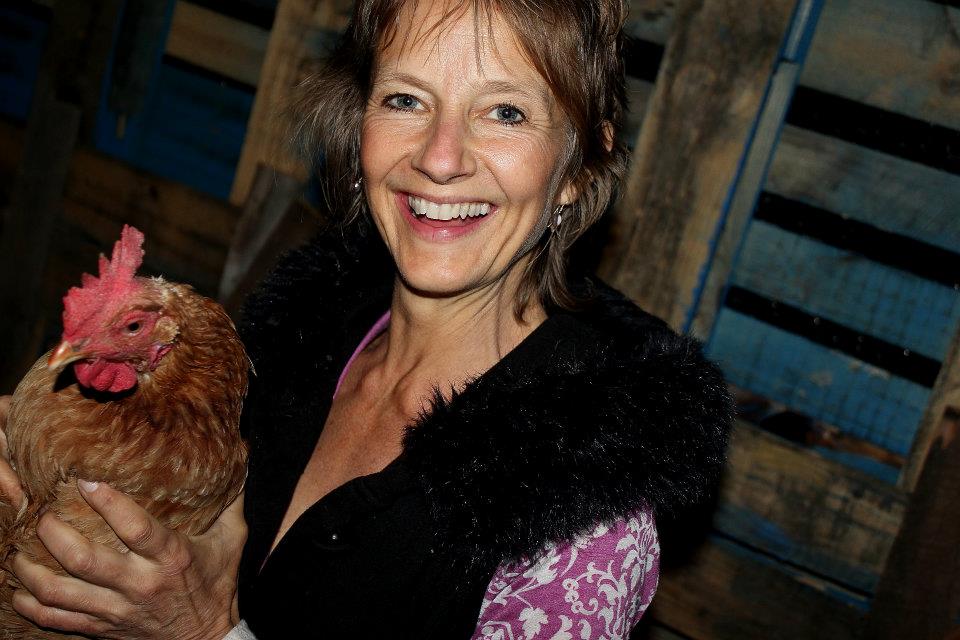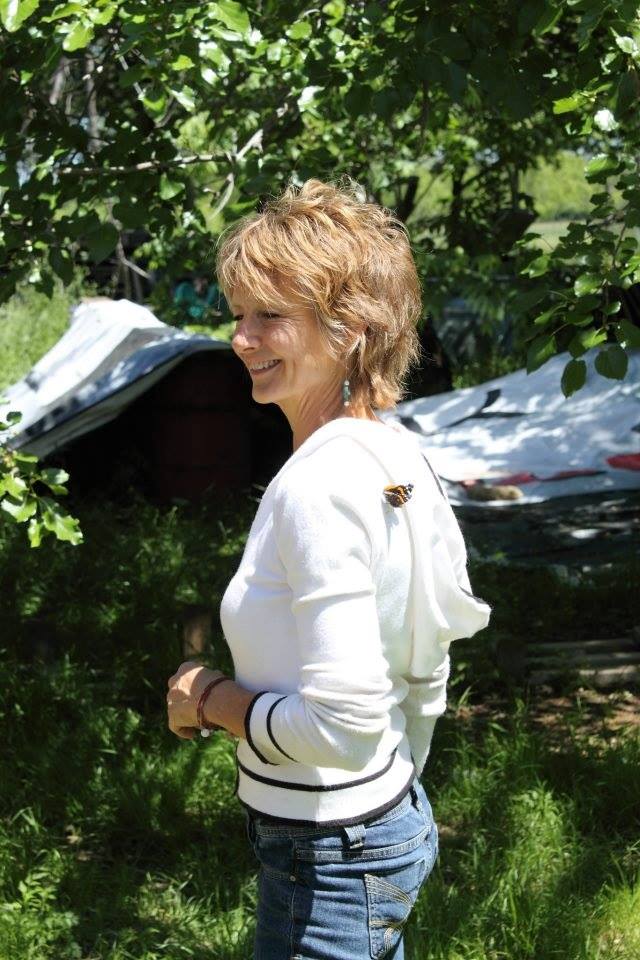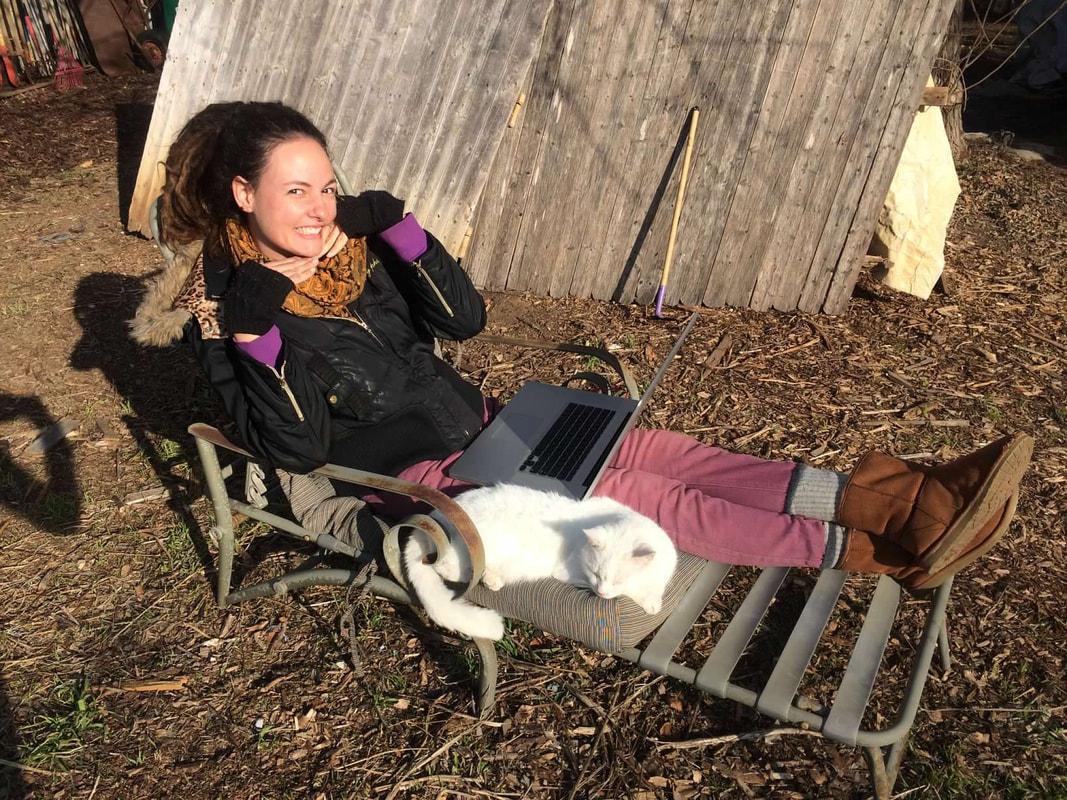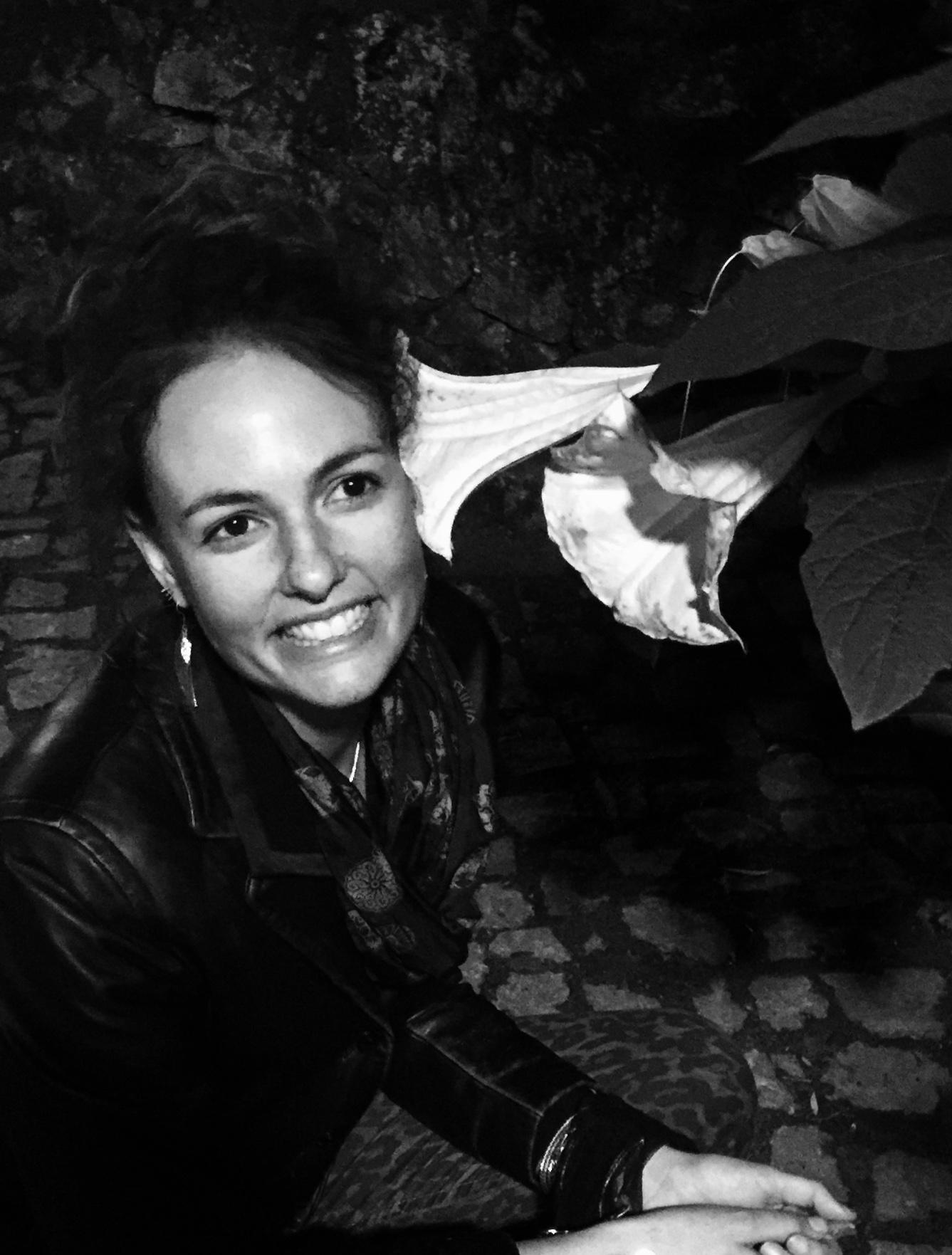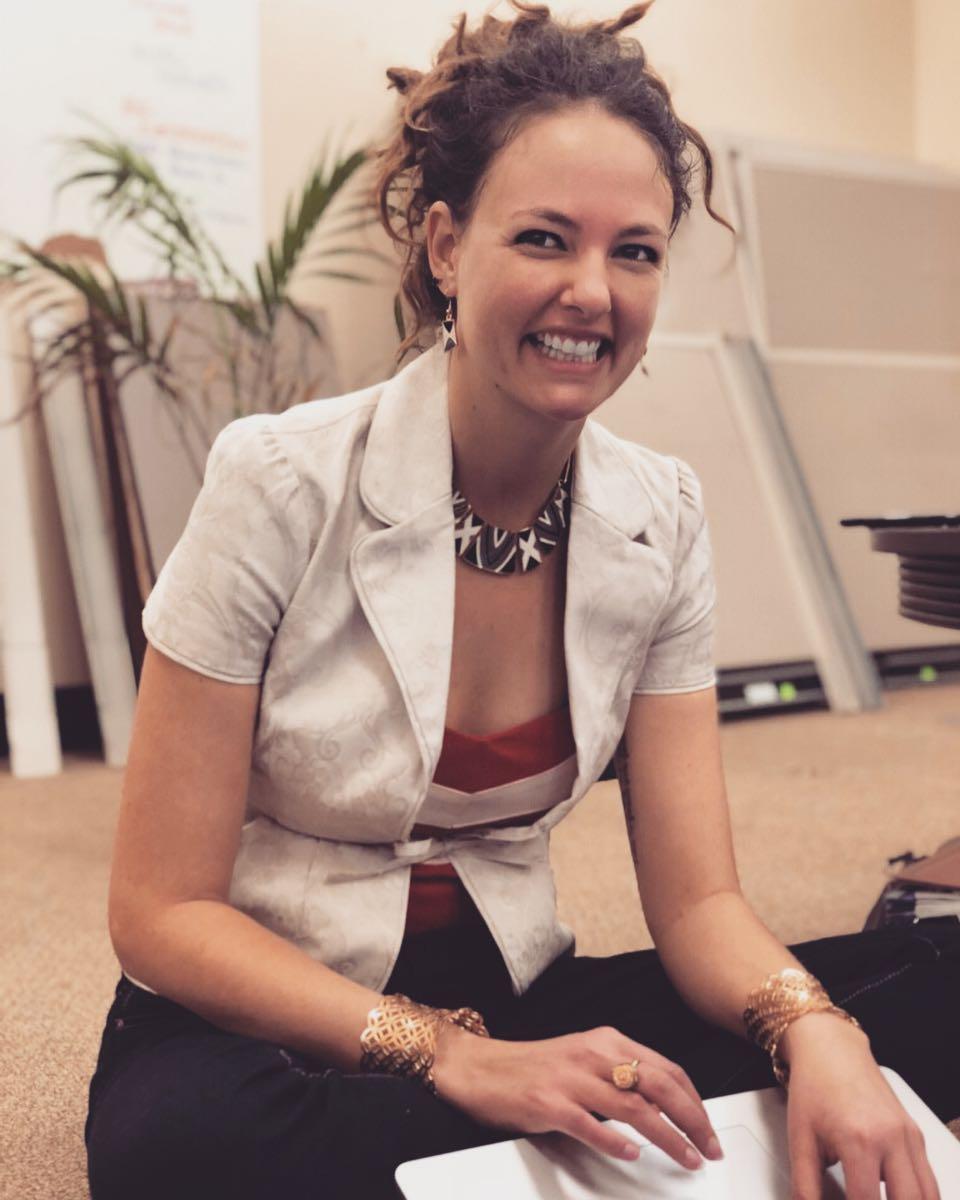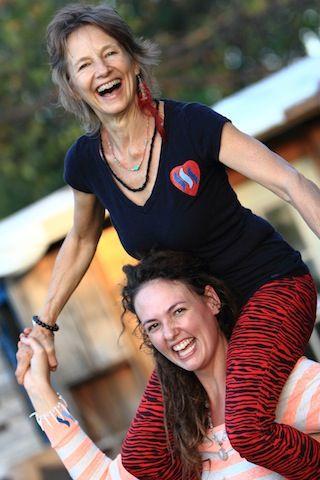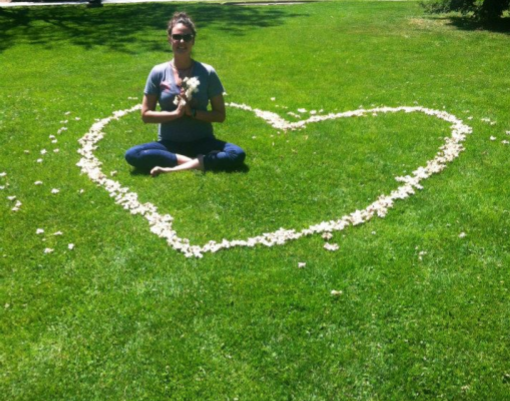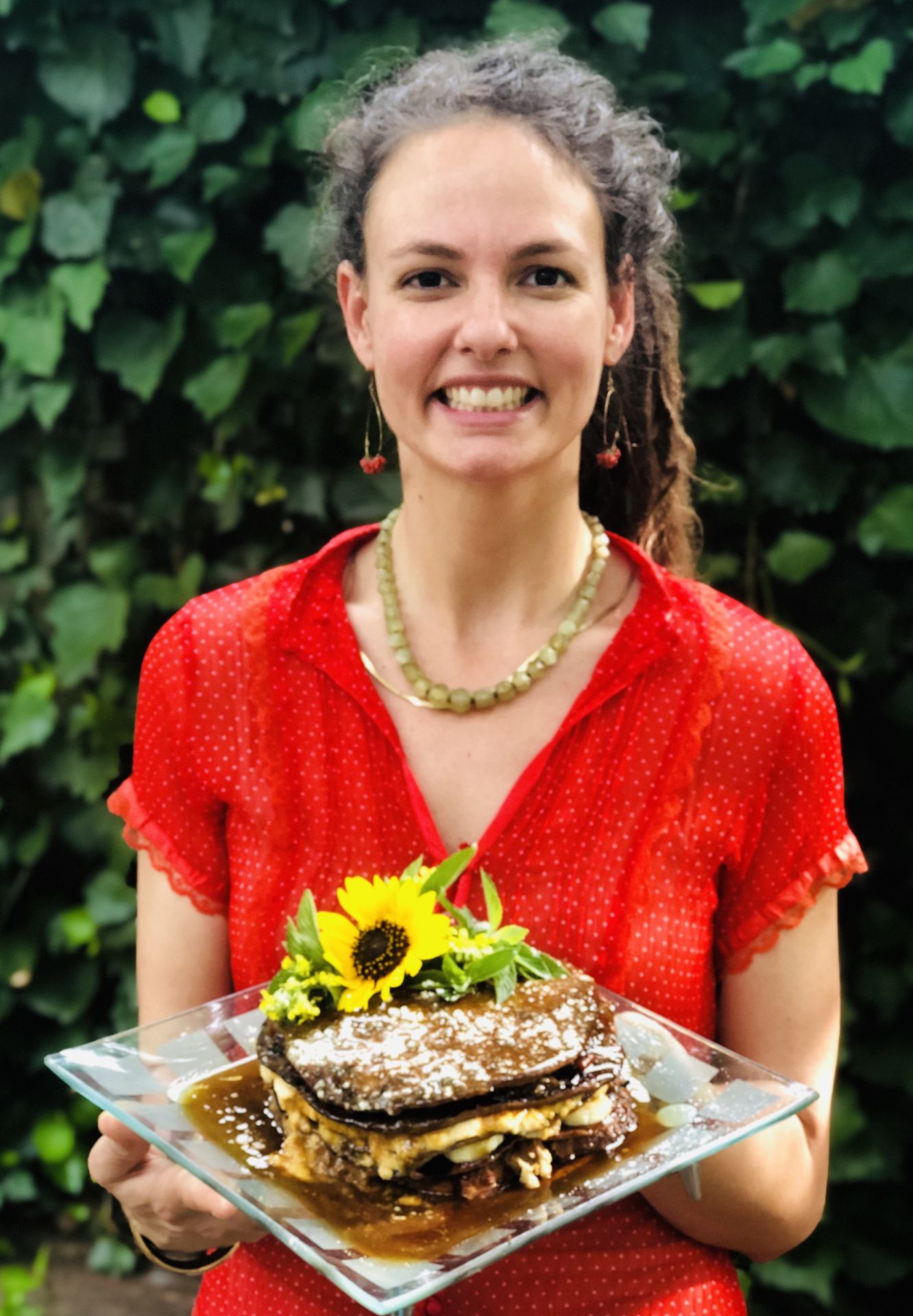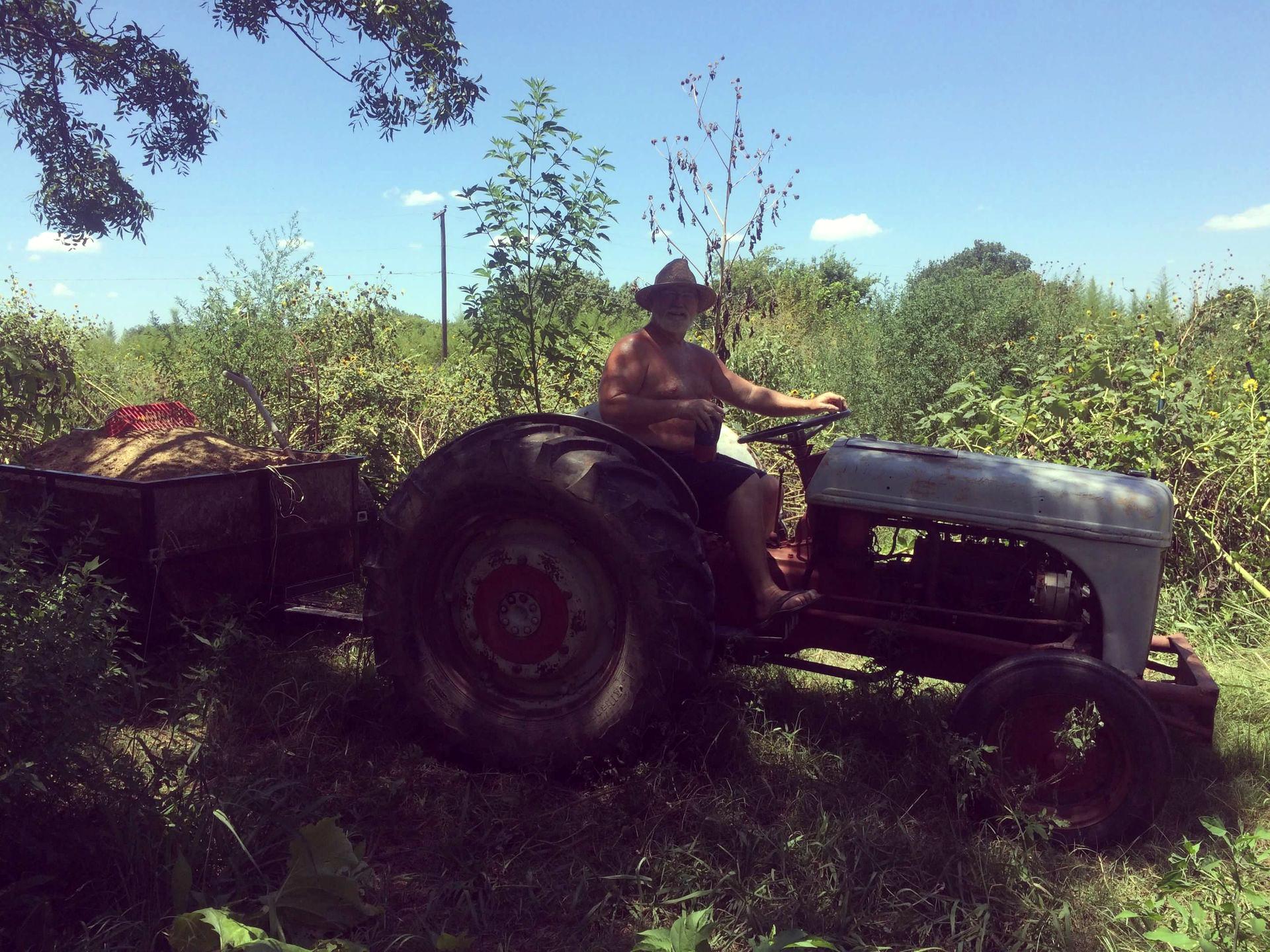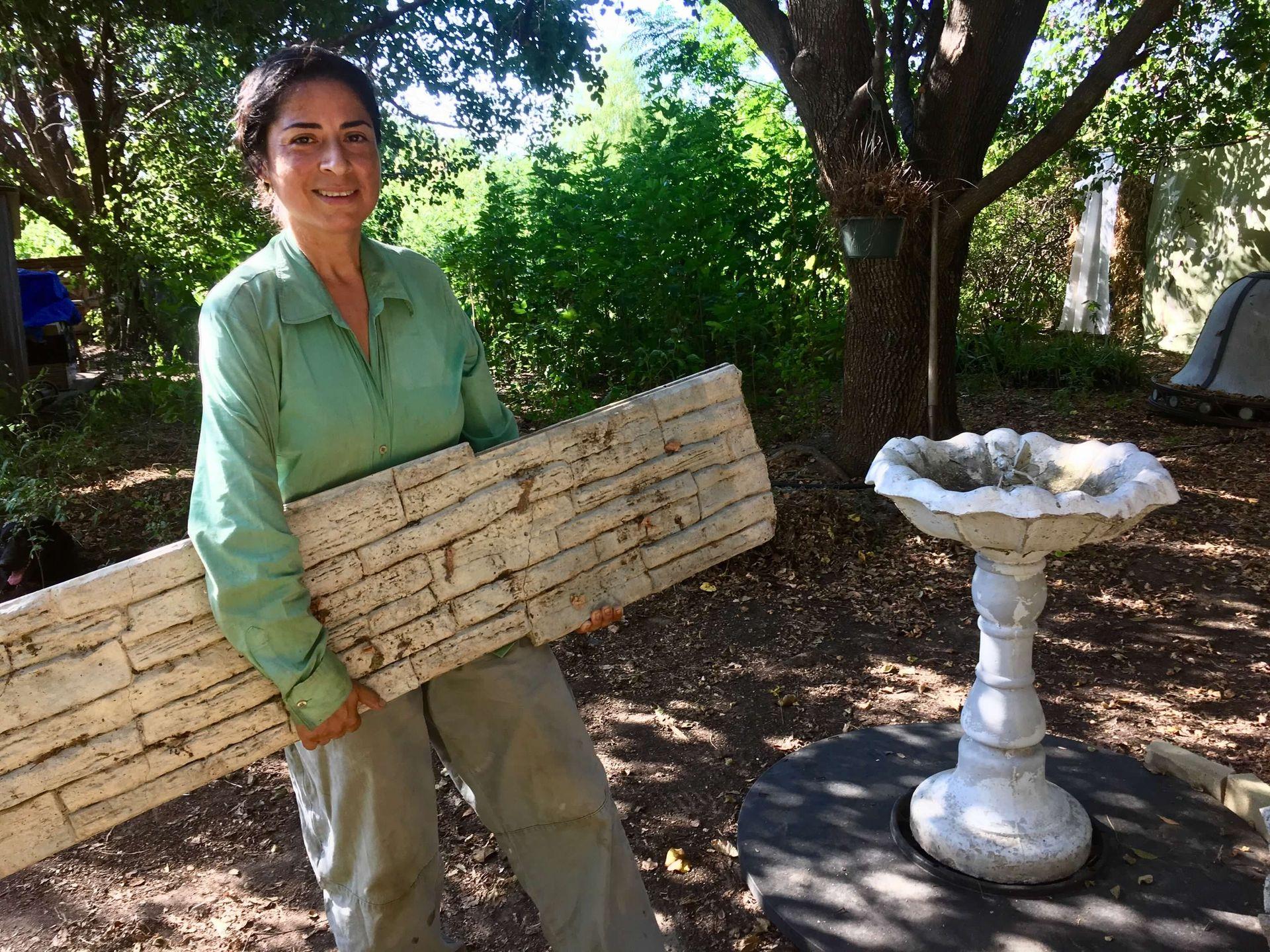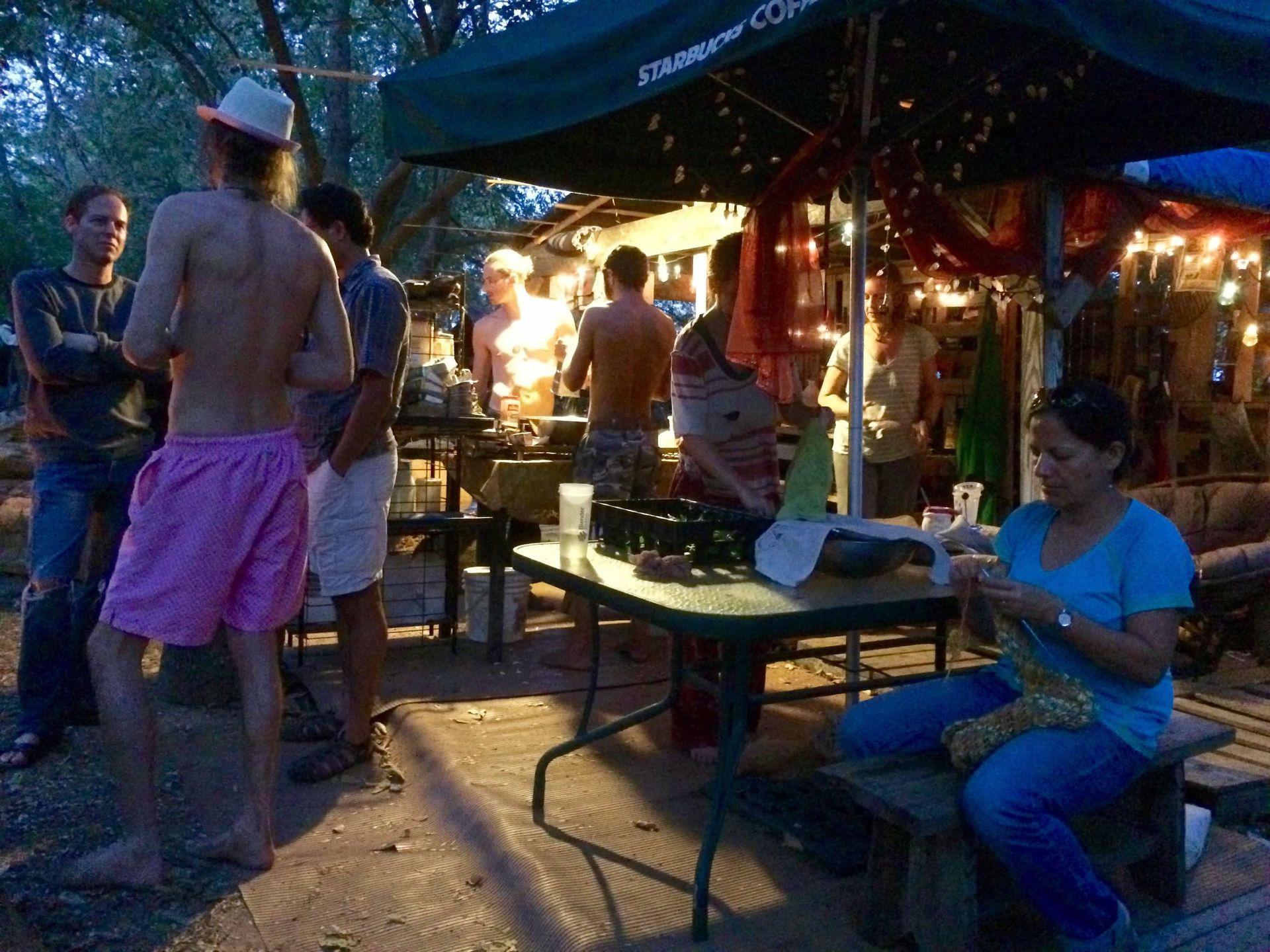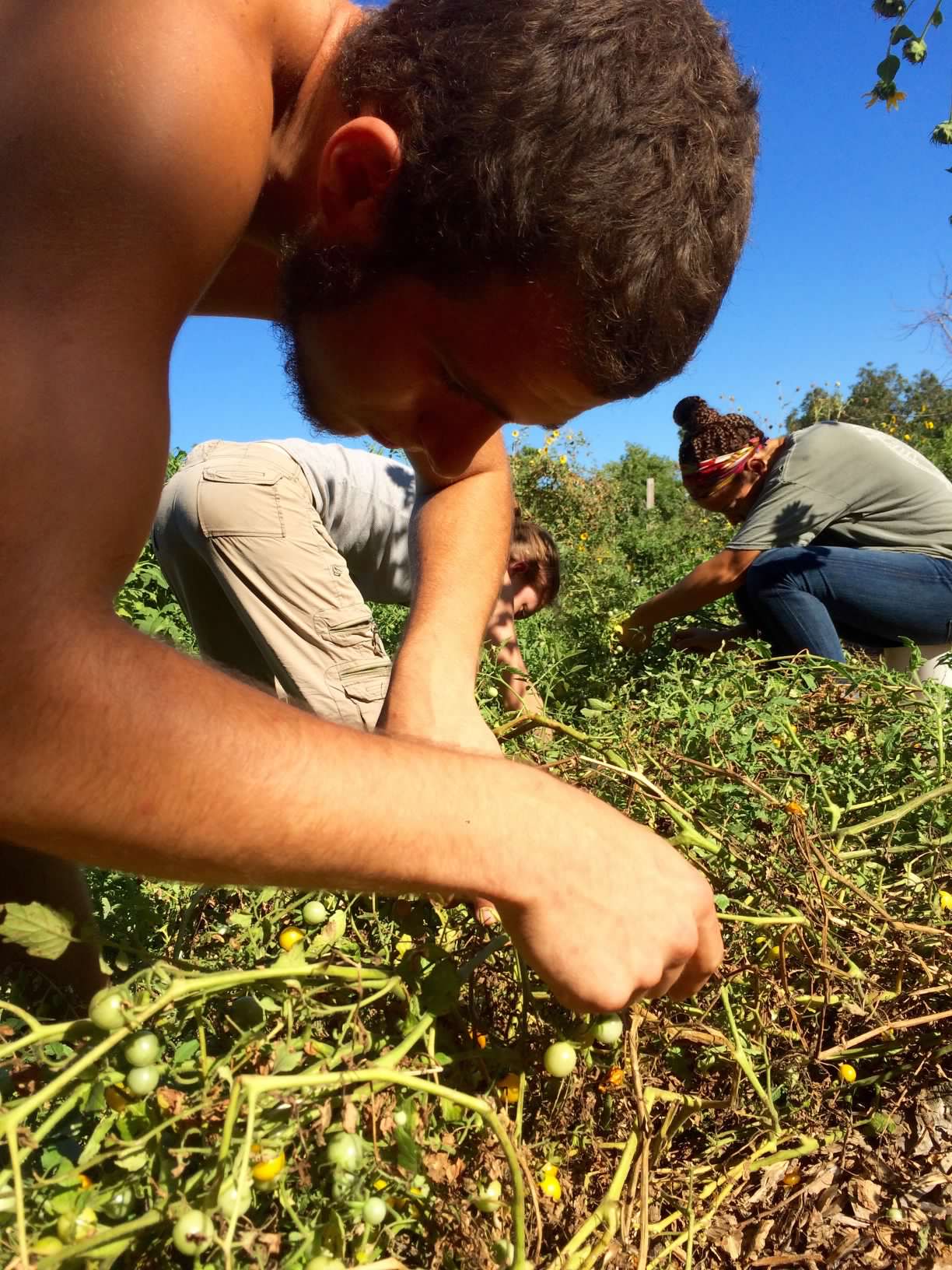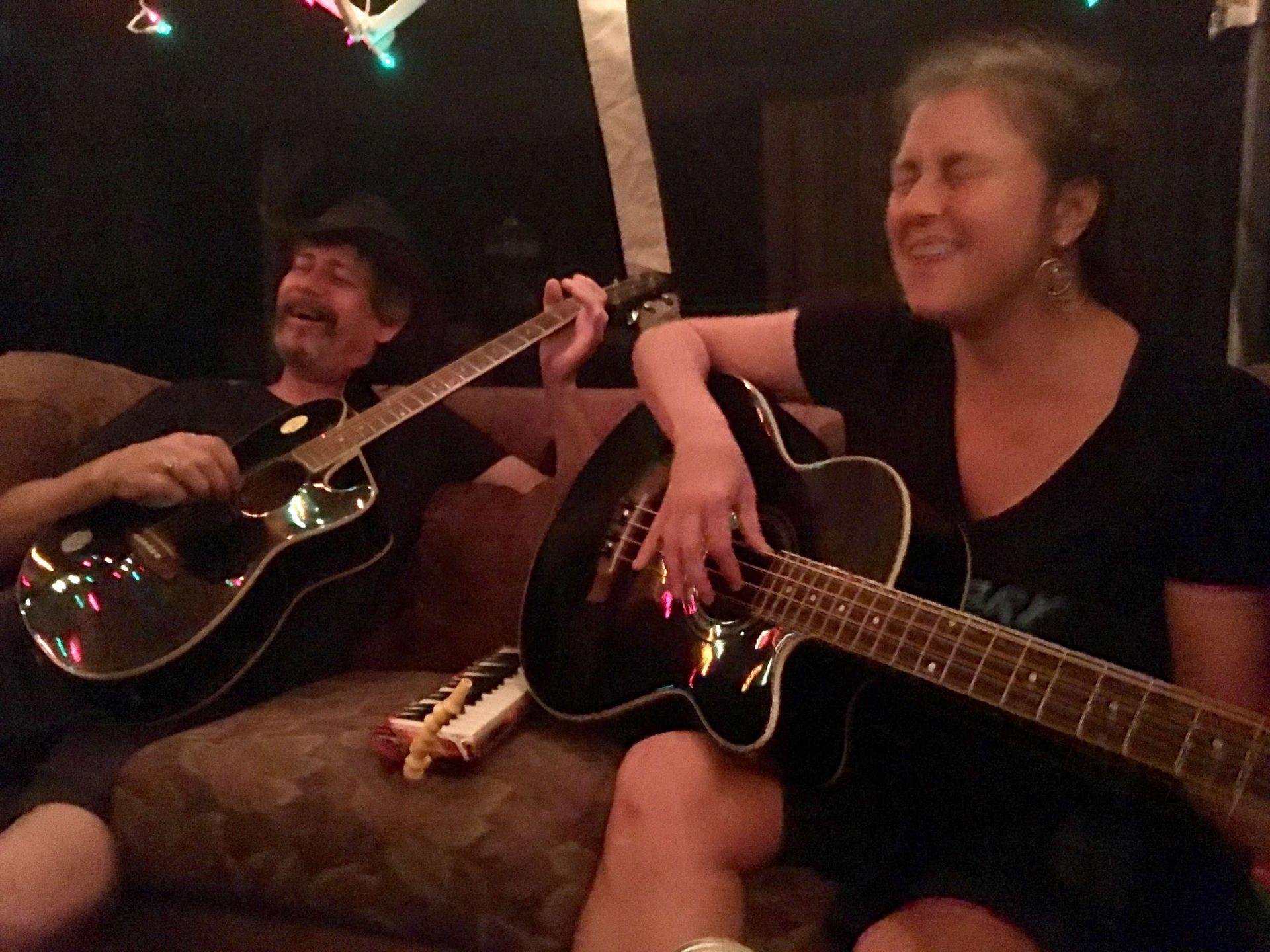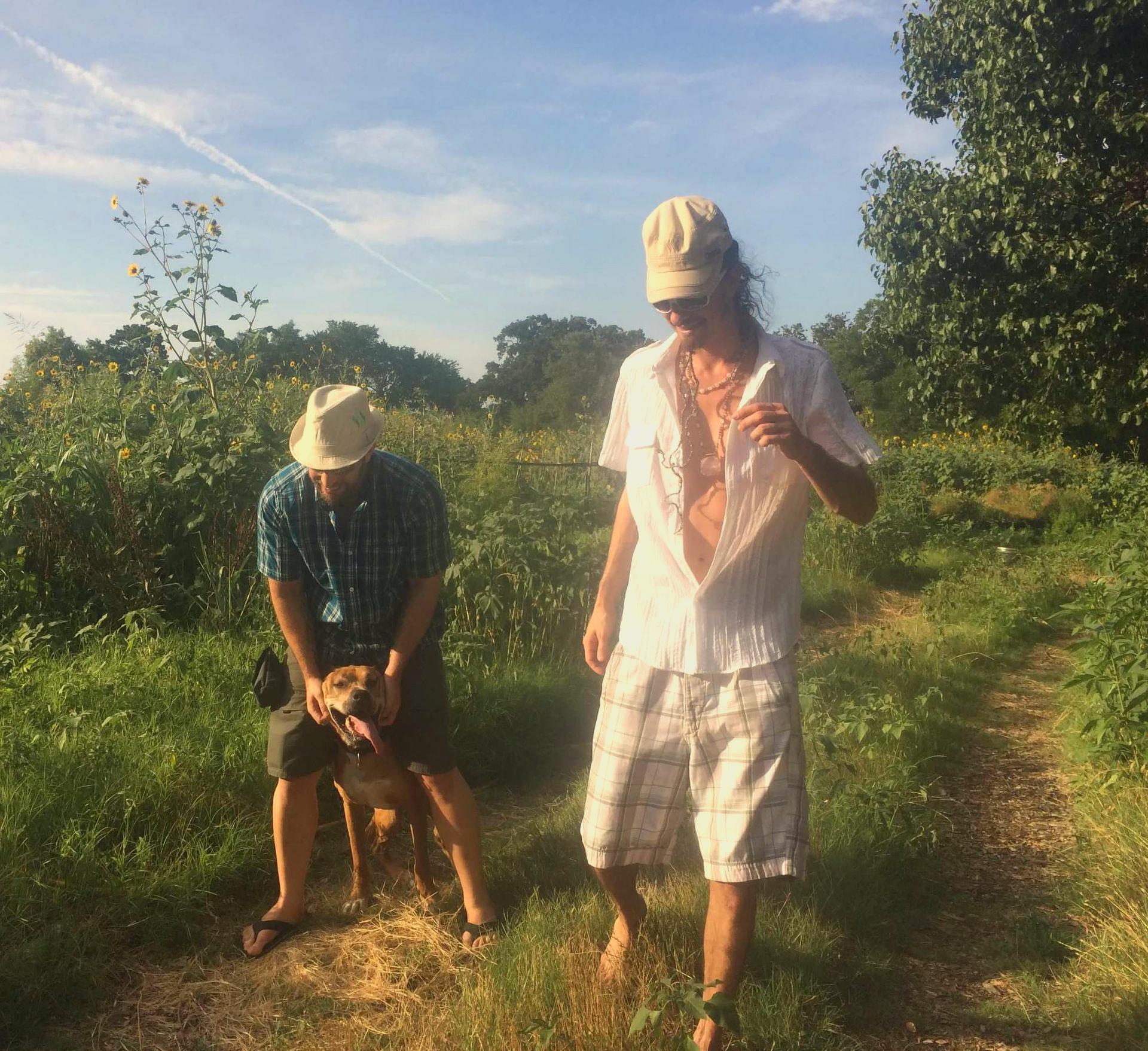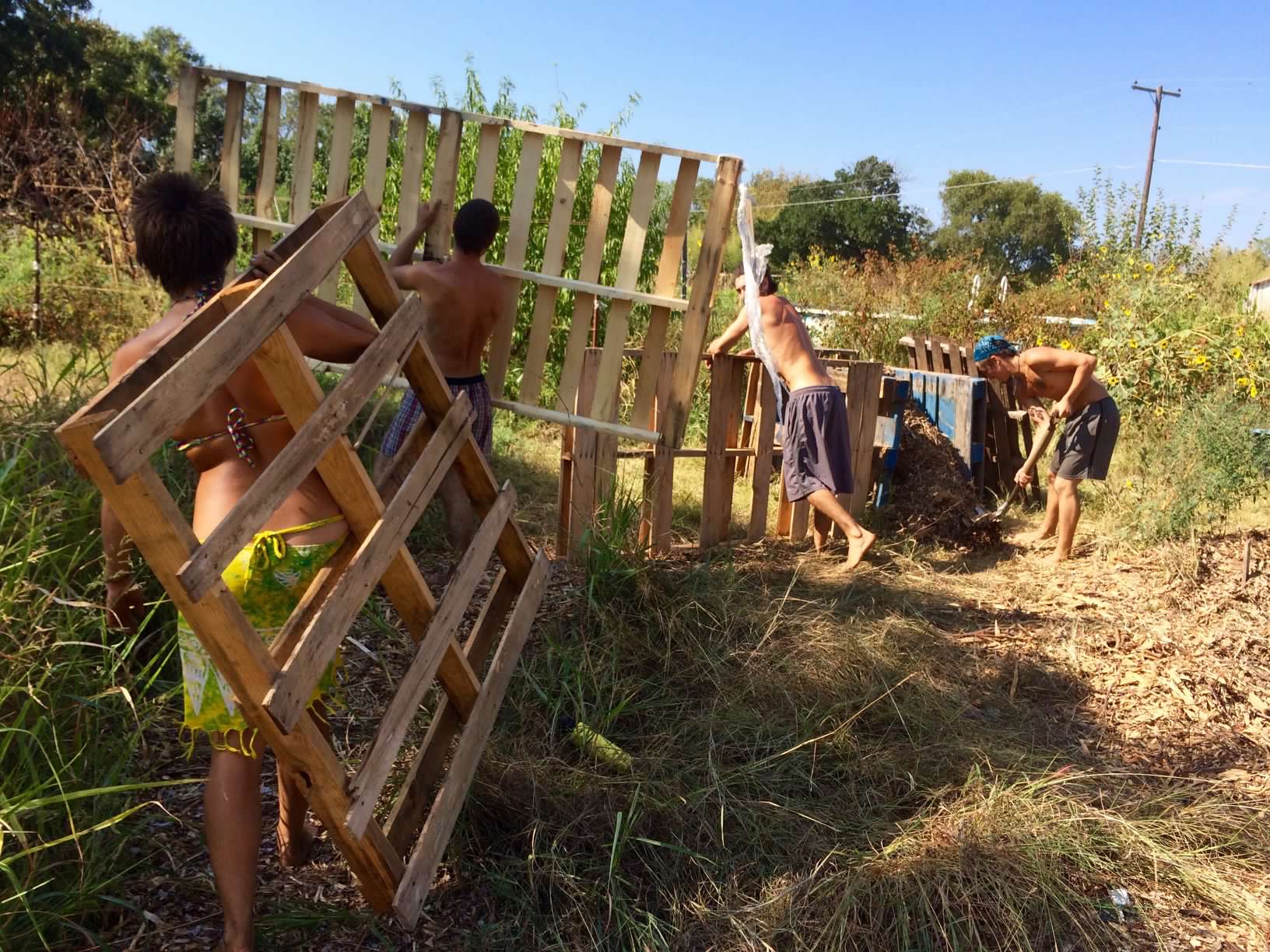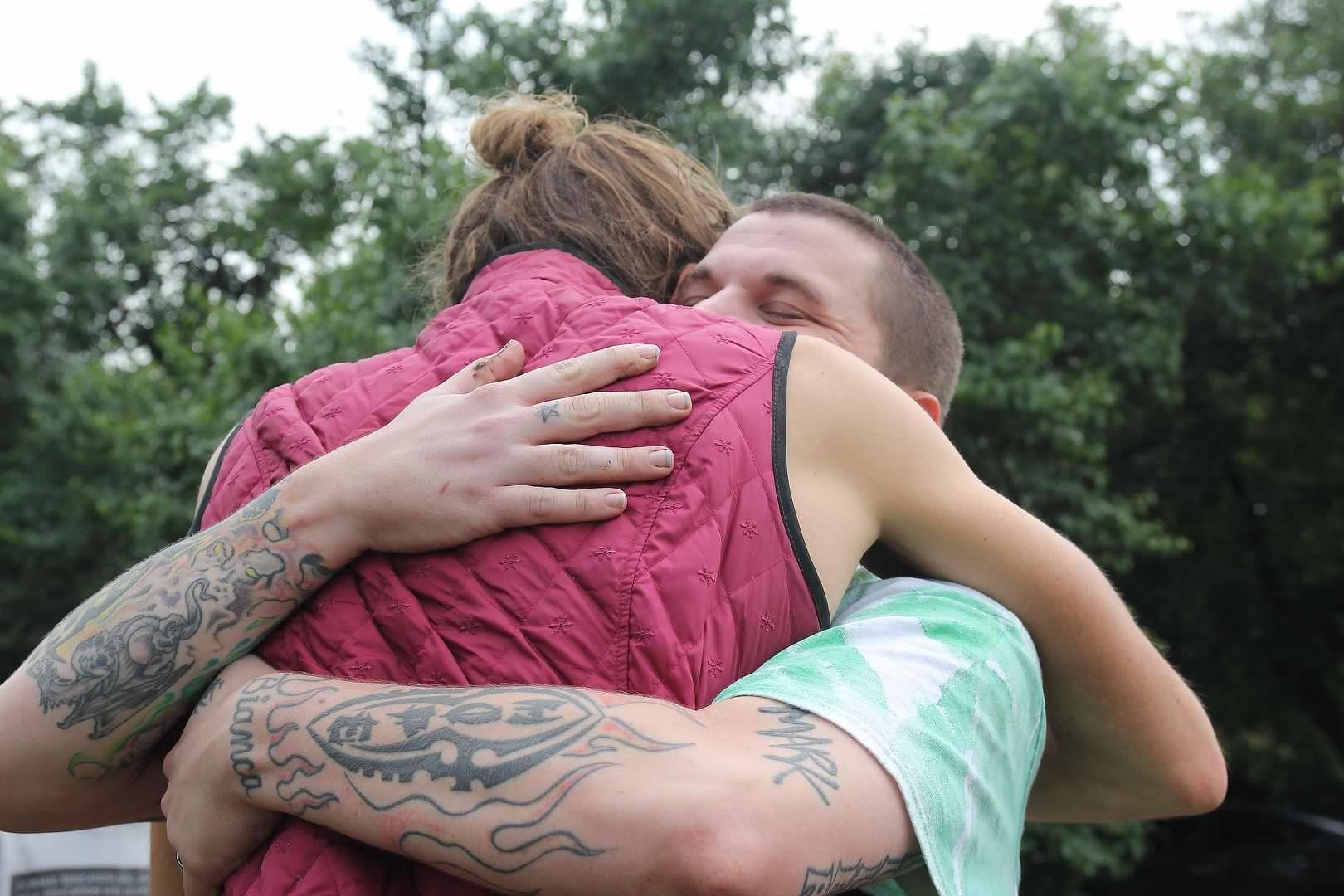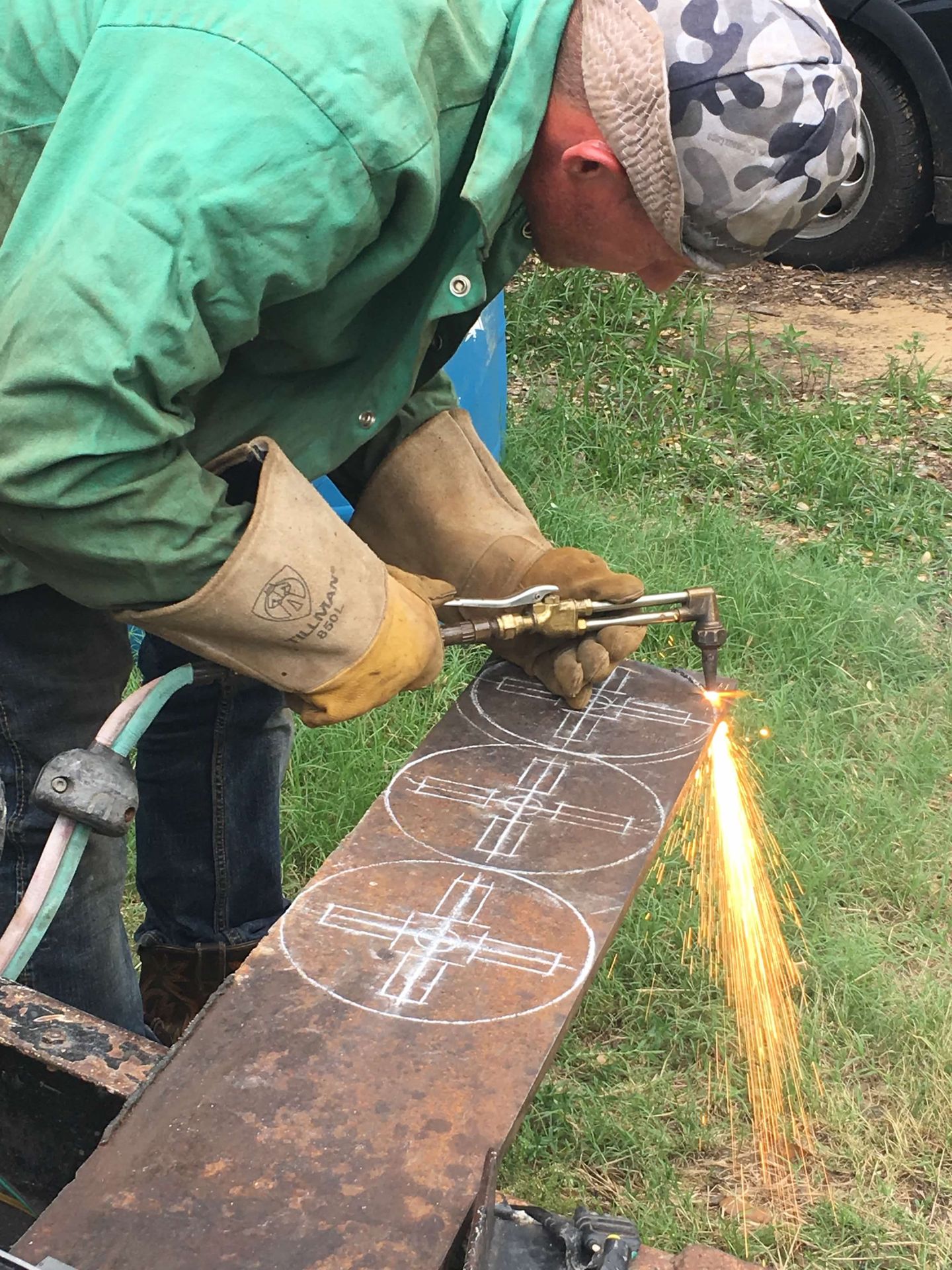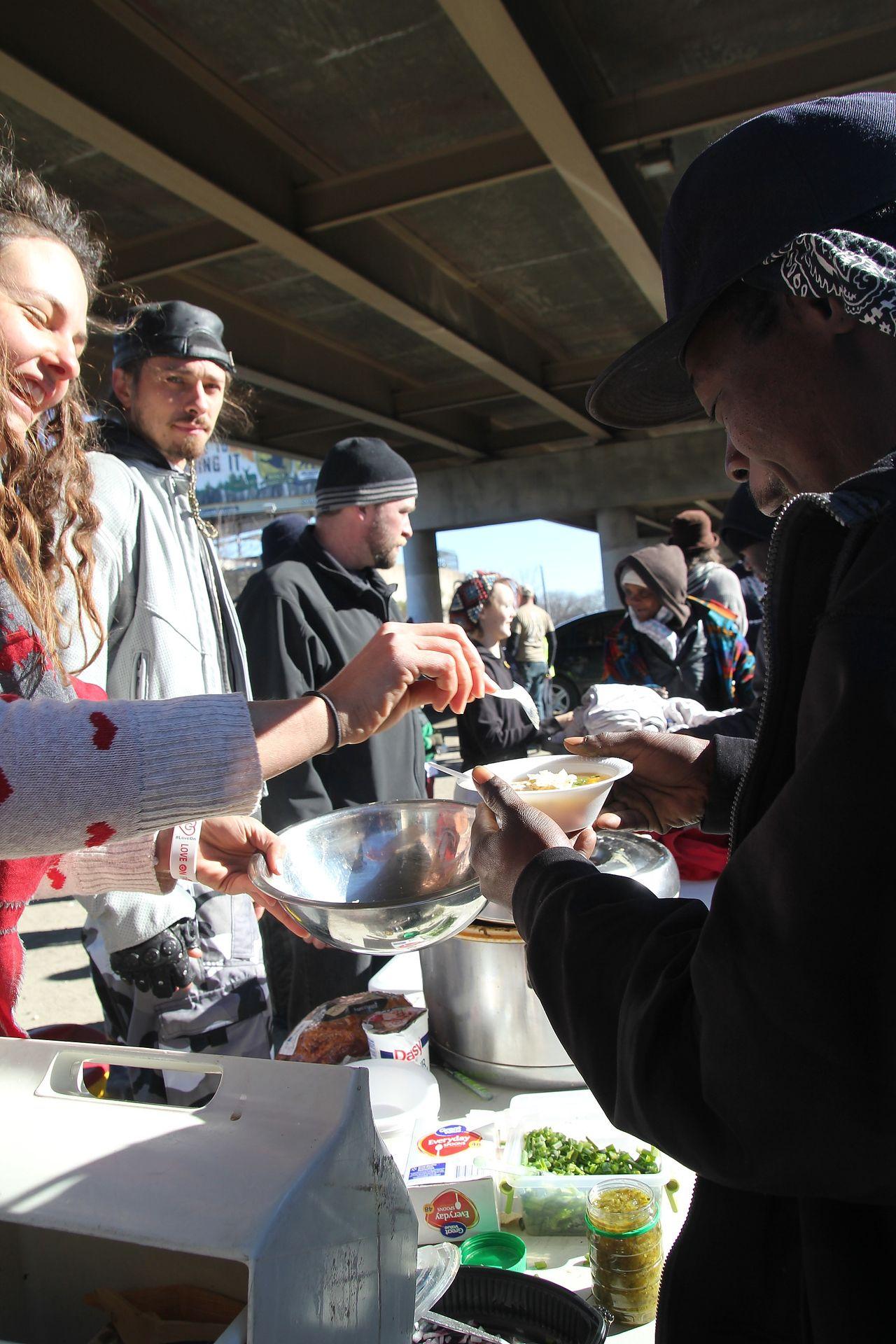Like a beacon of light in
the heart of darkness,
this small, consciousness-based
community is here to support those
who choose to awaken
from the matrix that is all around
as well as engrained deeply within.
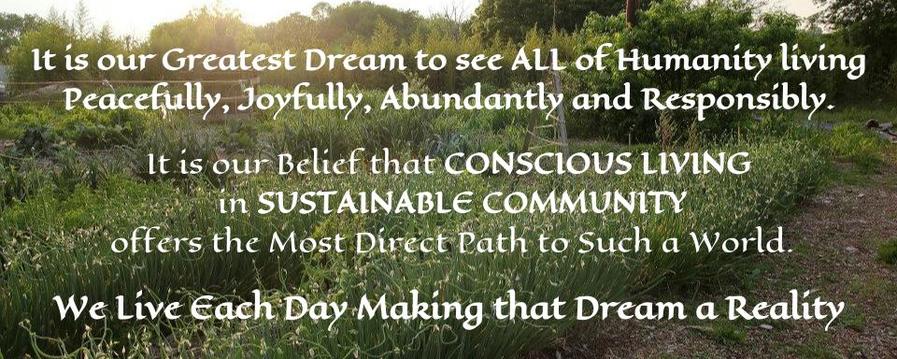
The Garden of Eden eco-village lies in the midst of the of the suburban sprawl of the Dallas-Fort Worth Metroplex, on the border of Arlington and Kennedale. While it is only minutes from the freeway, it feels like another world here!
Upon arriving, one is greeted by fresh country air blooming with the smell of soil and fresh herbs. Mature trees frame the sky, and the eye stretches out over a vast garden that dominates the front section of the 3.5 acre lot.
By day, birds and bugs sing a symphony of chirps, buzzes, and calls. By night, crickets and coyotes sing their night songs, punctuated by the occasional dog barking or feline fray. Roosters from our yard and the next announce dusk and dawn.
Life in the GOE is a beautiful balance of modern technology and a sustainable lifestyle. Computers, electronics, automobiles, and other modern devices are indeed a part of life here, and yet there are also composting toilets, wildcrafted gardens, and other creative implementations that make our day-to-day life more ecologically and energetically sustainable.
~*~ Only responsibility can lead to the Golden Age ~*~
Like a beacon of light in
the heart of darkness,
this small, consciousness-based community is here to support those who choose to awaken from the matrix that is all around as well as engrained deeply within.

The Garden of Eden eco-village lies in the midst of the of the suburban sprawl of the Dallas-Fort Worth Metroplex, on the border of Arlington and Kennedale. While it is only minutes from the freeway, it feels like another world here!
Upon arriving, one is greeted by fresh country air blooming with the smell of soil and fresh herbs. Mature trees frame the sky, and the eye stretches out over a vast garden that dominates the front section of the 3.5 acre lot.
By day, birds and bugs sing a symphony of chirps, buzzes, and calls. By night, crickets and coyotes sing their night songs, punctuated by the occasional dog barking or feline fray. Roosters from our yard and the next announce dusk and dawn.
Life in the GOE is a beautiful balance of modern technology and a sustainable lifestyle. Computers, electronics, automobiles, and other modern devices are indeed a part of life here, and yet there are also composting toilets, wildcrafted gardens, and other creative implementations that make our day-to-day life more ecologically and energetically sustainable.
~*~ Only responsibility can lead to the Golden Age ~*~
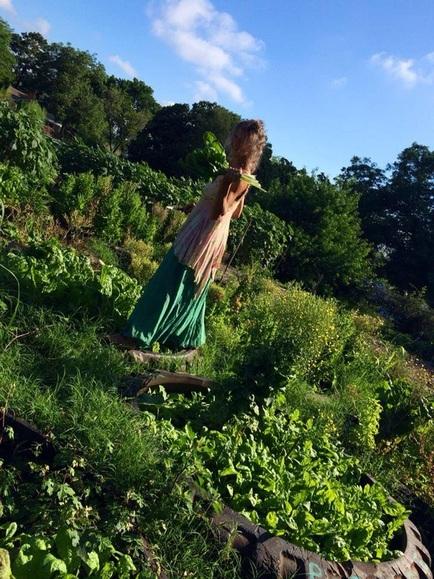
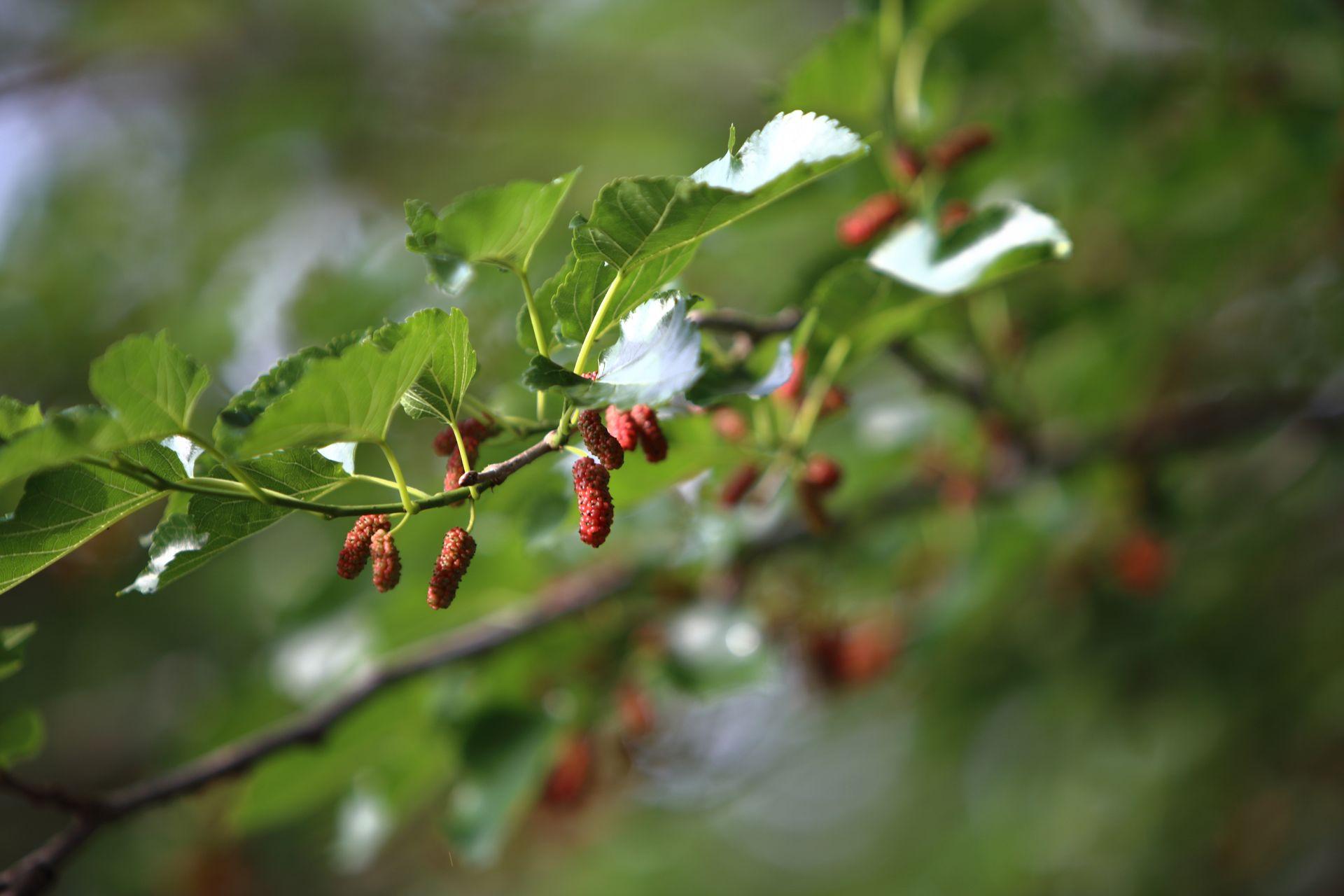
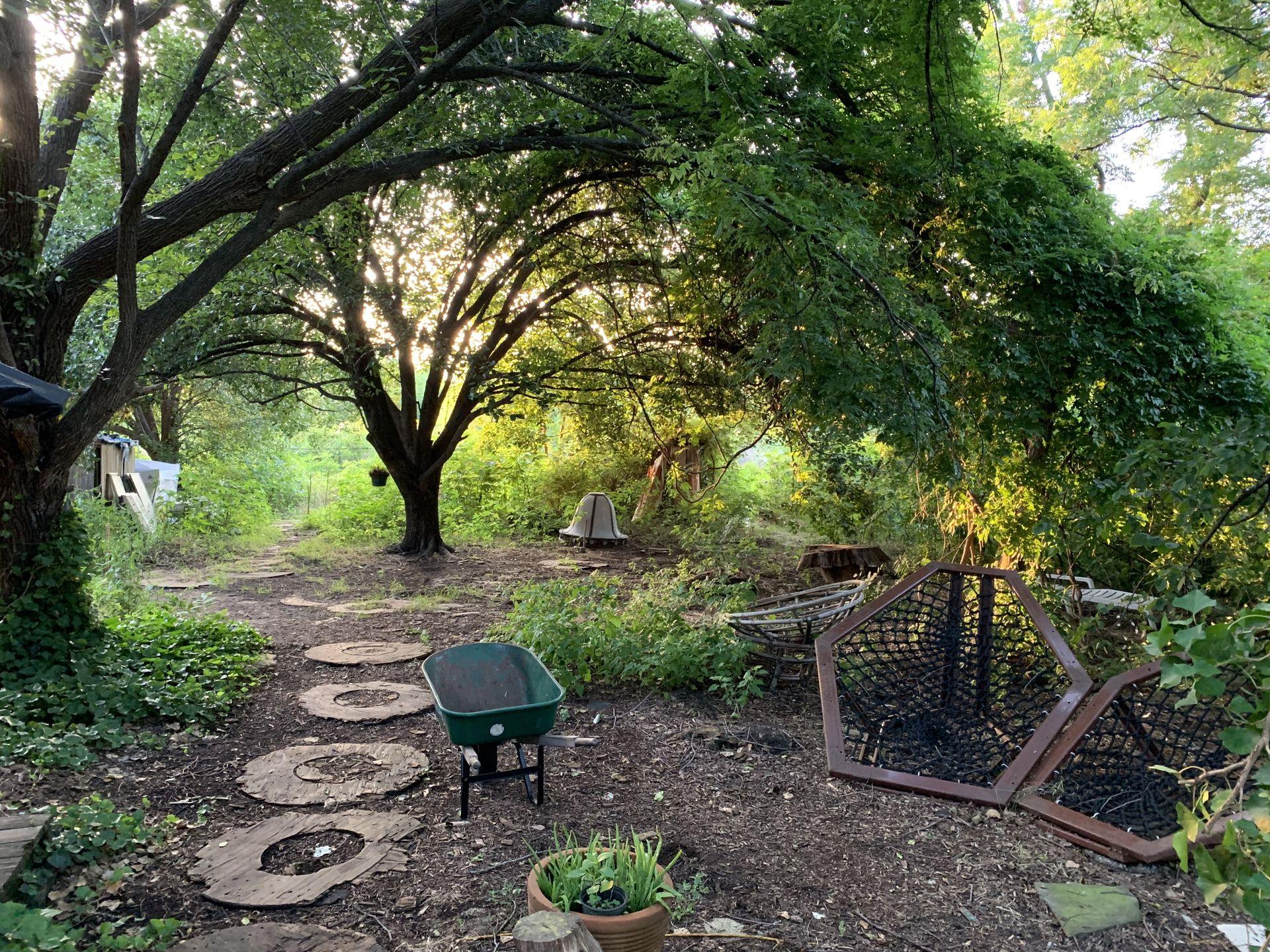
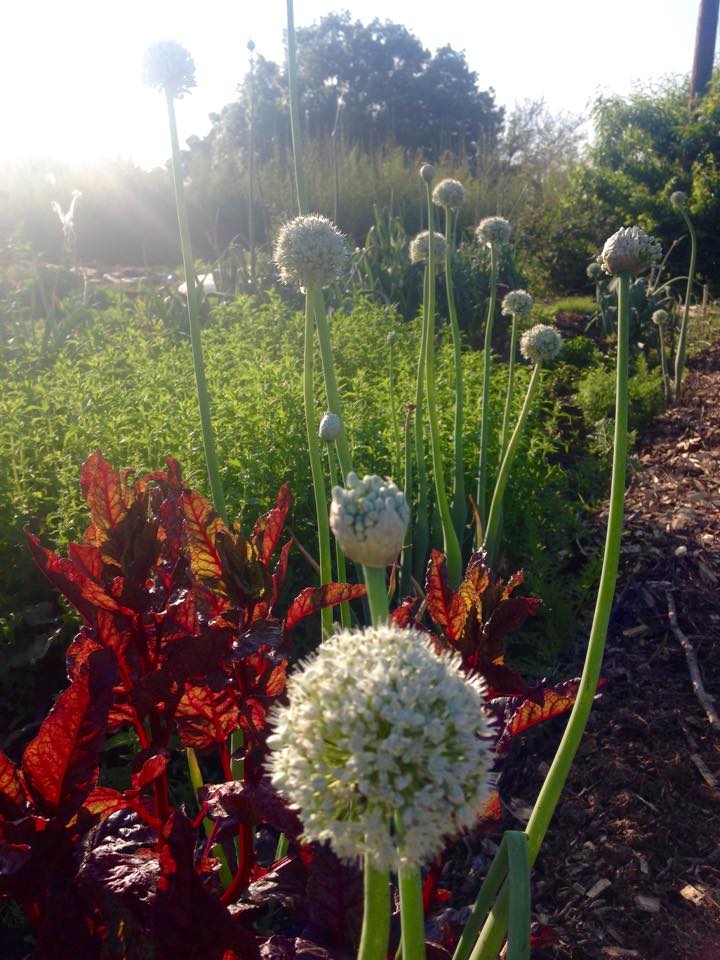
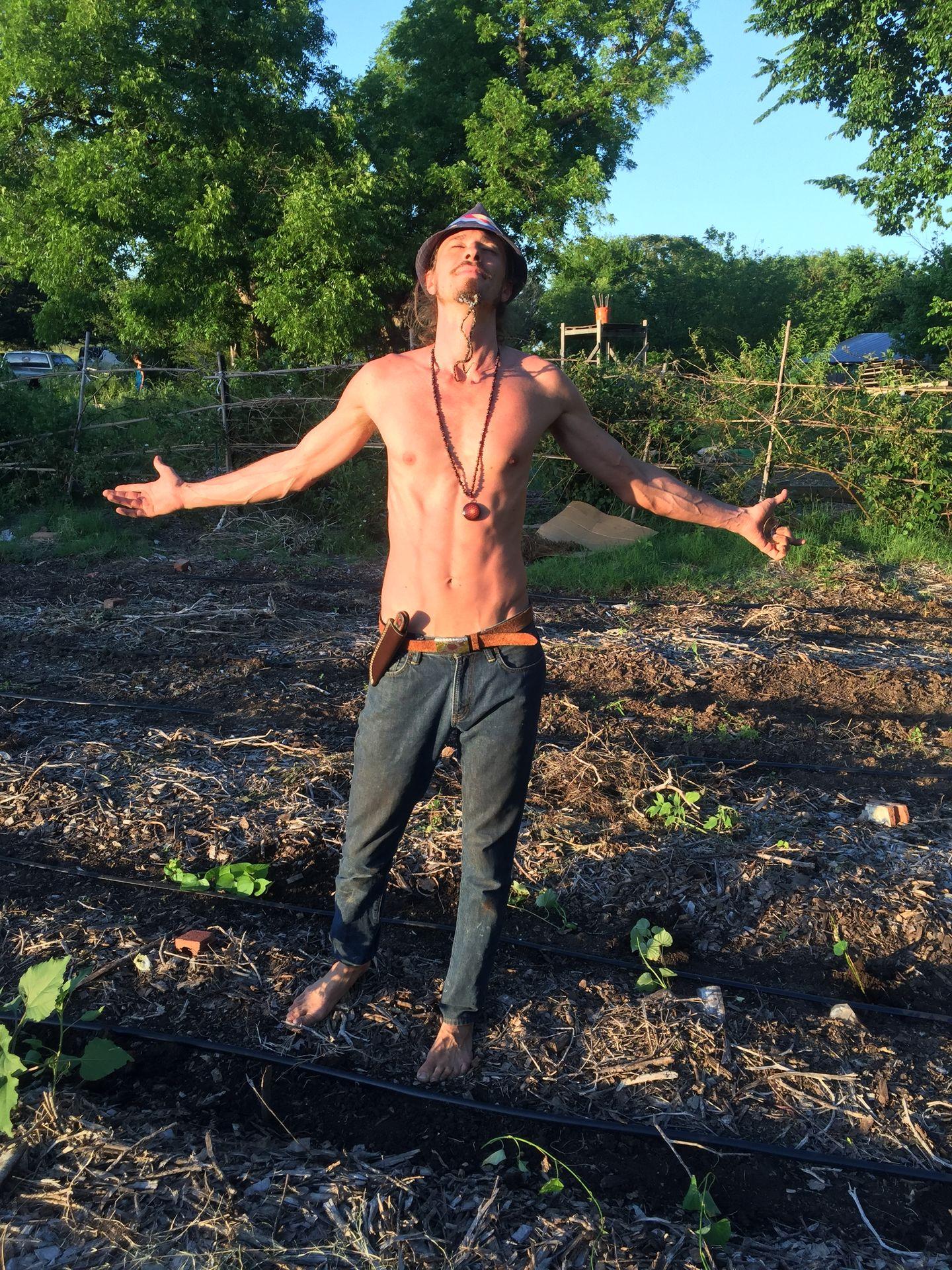
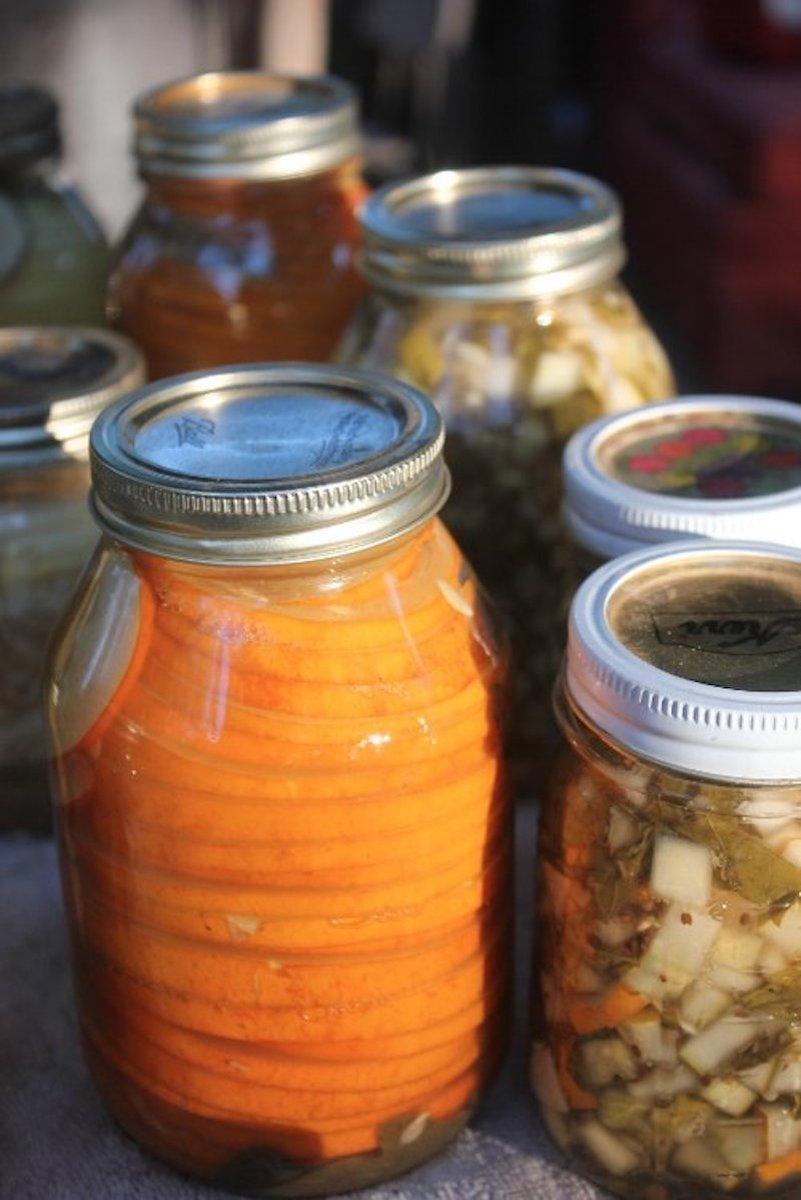
∾⊱⩫ Our Place⩫⊰∾
From its inception as a human habitat, sustainable evolution seems to have been an essential part of the spirit of this place - suggesting that this is perhaps a quality that is intrinsic to the land itself!
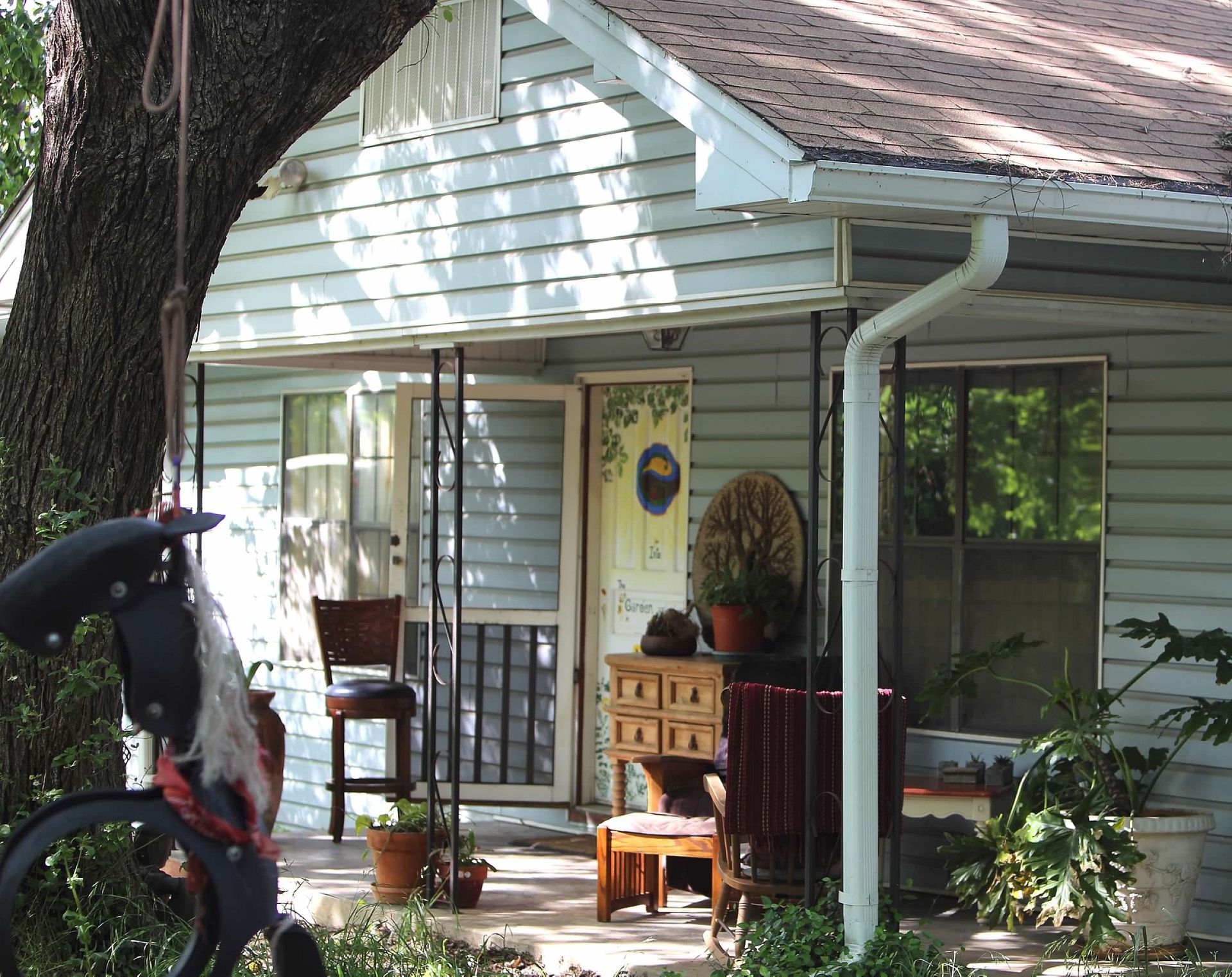

The almost 4,000 square foot main house began as just a small two room home in the 1960s, pieced together from odds and ends of building materials - things that were cheap, free, or in great abundance, like shutters and doors. It has been expanded multiple times by two subsequent owners, each incorporating some odds and ends and leaving little oddities like windows from room to room, and a view of a former exterior wall at the threshold of the attic.
The layout is a bit odd and the light switches are rarely where you would think they should be, yet therein lies the charm that first called to Shellie's heart when she was house shopping for her family decades ago. She says they visited dozens of homes seeking to purchase, but she knew instantly that this one was Her House.
The almost 4,000 square foot main house began as just a small two room home in the 1960s, pieced together from odds and ends of building materials - things that were cheap, free, or in great abundance, like shutters and doors. It has been expanded multiple times by two subsequent owners, each incorporating some odds and ends and leaving little oddities like windows from room to room, and a view of a former exterior wall at the threshold of the attic.
The layout is a bit odd and the light switches are rarely where you would think they should be, yet therein lies the charm that first called to Shellie's heart when she was house shopping for her family decades ago. She says they visited dozens of homes seeking to purchase, but she knew instantly that this one was Her House.
After being the shepherdess to this land for sixteen years and raising her family here, Shellie was so deeply inspired by Quinn's vision, purpose, and dedication to his dream of creating a sustainable eco-village that she generously donated this 3.5 acre plot of land and home to become The Garden of Eden.
Once covered with tidy mowed grass and planted gardens, this place was lovely and artfully crafted by Shellie. Yet as quaint as it was, it was fundamentally unsustainable and even wasteful - as standard American living generally is.
Around 2009, together Quinn and Shellie began composting, thus creating the soil that would someday nurture and grow nutritious organic food. The raised beds in the monster truck tires were the first installment of massive gardens that now stretch out and dapple the entire plot.
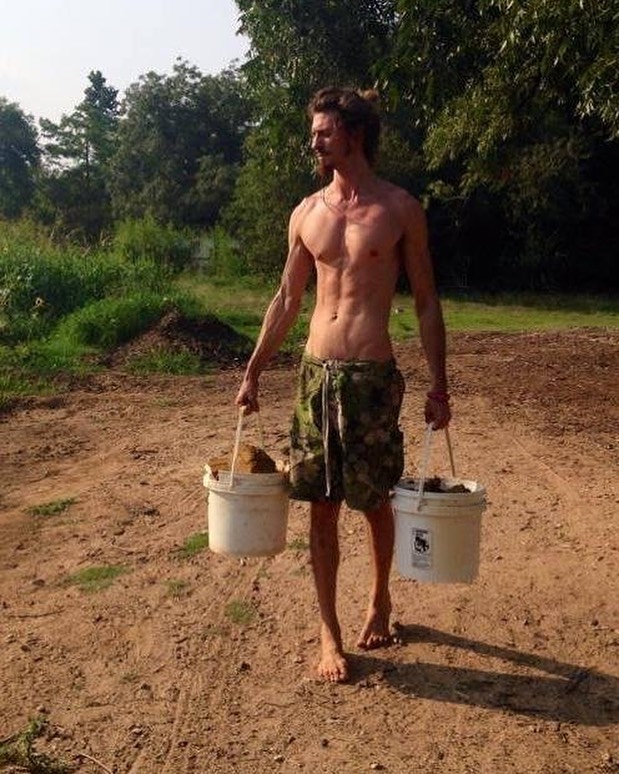
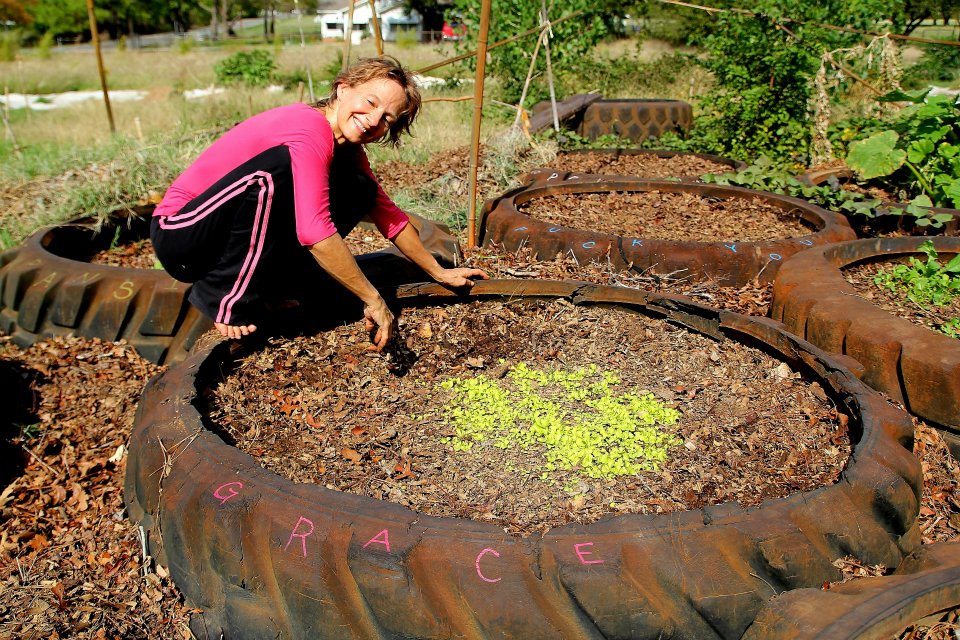
In 2011, additional inhabitants moved in, some staying for several months, and only the cream of the crop making it for a year or more. The land and community have gone through numerous iterations since then!
After being the shepherdess to this land for sixteen years and raising her family here, Shellie was so deeply inspired by Quinn's vision, purpose, and dedication to his dream of creating a sustainable eco-village that she generously donated this 3.5 acre plot of land and home to become The Garden of Eden.
Once covered with tidy mowed grass and planted gardens, this place was lovely and artfully crafted by Shellie. Yet as quaint as it was, it was fundamentally unsustainable and even wasteful - as standard American living generally is.
Around 2009, together Quinn and Shellie began composting, thus creating the soil that would someday nurture and grow nutritious organic food. The raised beds in the monster truck tires were the first installment of massive gardens that now stretch out and dapple the entire plot.


In 2011, additional inhabitants moved in, some staying for several months, and only the cream of the crop making it for a year or more. The land and community have gone through numerous iterations since then!
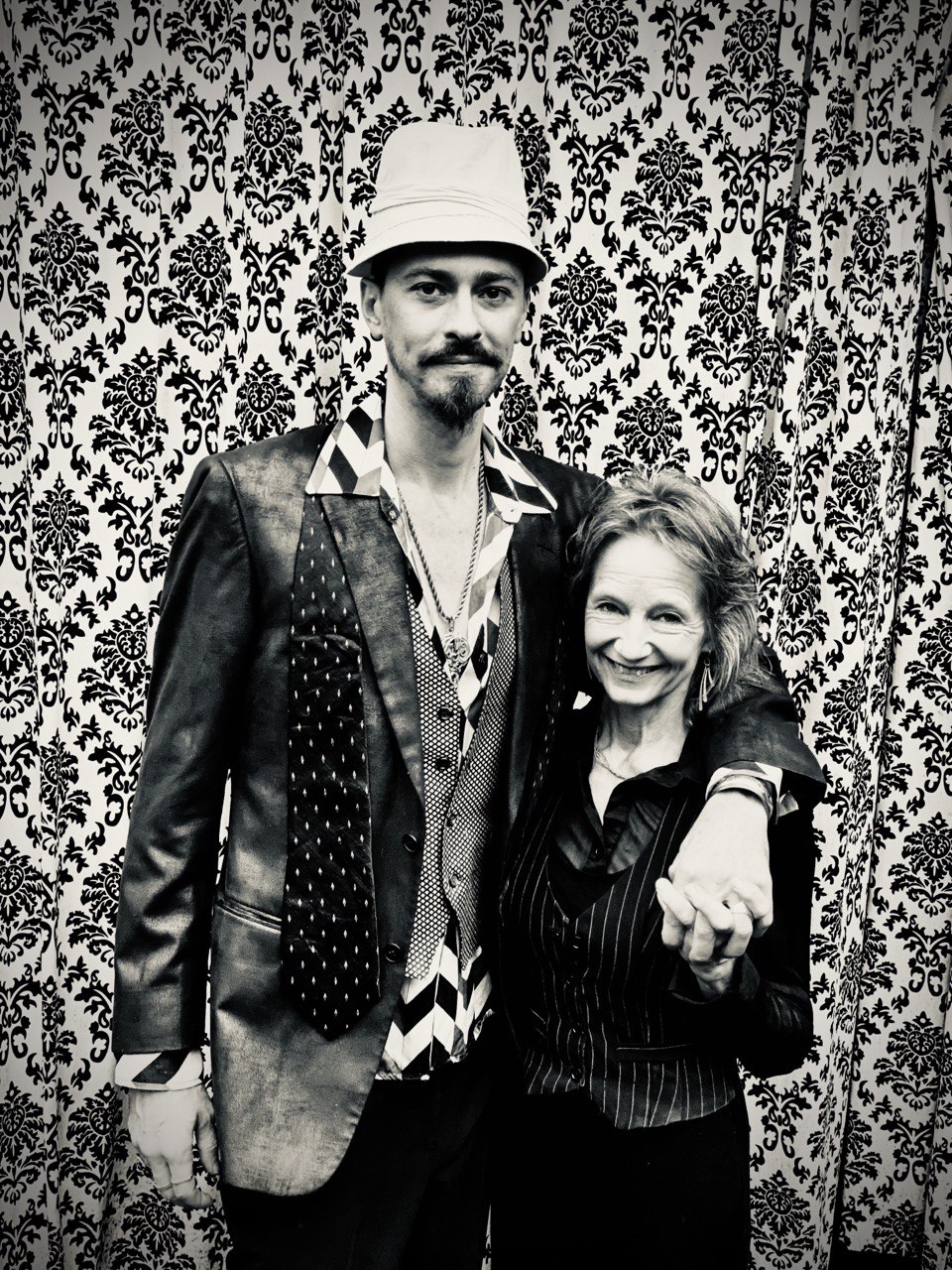

Because of our lifestyle, we were healthy and thriving - but everyone around us was sick! Not everyone in America can spend their time barefoot in the garden and sunshine, so we established our line of High Vibe Health supplements over a decade ago to fix a lot of the very serious problems facing society and to improve the general standard of day to day well being for our extended community.
We started with 35% Food Grade Hydrogen Peroxide, because it is a miracle, 100% natural solution for so many problems! Over time we added new products that are the highest quality we have found, each with real, valuable applications. We offer all natural, cost effective, functional solutions that you can't grow or get from food. We have helped tens of thousands of people through our High Vibe Health line!
Because of our lifestyle, we were healthy and thriving - but everyone around us was sick! Not everyone in America can spend their time barefoot in the garden and sunshine, so we established our line of High Vibe Health supplements over a decade ago to fix a lot of the very serious problems facing society and to improve the general standard of day to day well being for our extended community.
We started with 35% Food Grade Hydrogen Peroxide, because it is a miracle, 100% natural solution for so many problems! Over time we added new products that are the highest quality we have found, each with real, valuable applications. We offer all natural, cost effective, functional solutions that you can't grow or get from food. We have helped tens of thousands of people through our High Vibe Health line!
Food is essential for life, and the only way to be truly secure and self-existing is to have secure and reliable food resources. The most secure and sustainable way to get food is to grow it yourself. The Garden of Eden lands are blessed with a great abundance of edible and medicinal plants!
Through our own large garden and property-wide horticulture, The Garden of Eden demonstrates how to cultivate the highest quality foods with the least amount of energy, time, and money, and potentially even without using any major machinery or technology or even purchasing special materials, products, or chemicals! It's an exciting food reality that we are happy to share.
Surrounding the garden is a ring of wildcrafted and seasonal berry bushes, fruit, and nut trees, and medicinal herbs which require little to no maintenance.
We have native wild edibles like pecans, mulberries, hackberries, and lamb's quarters. Some of the medicinal plants that spot the land are yarrow, chickweed, Carolina geranium, yellow dock, feverfew, and multiple species of dandelion. There are also permaculture food plants that essentially self-perpetuate - minimal attention required! - including blackberry bushes along with fig and peach trees. We have patches of herbs, greens, and vegetables that have self-seeded around the land - some of our beloved "volunteers"!
It became painfully obvious along this journey of sustainability just how much food waste exists in the US. We started a non-profit to address this, and have since partnered with markets and grocery stores to take food waste with which we can feed chickens, goats, cats, dogs, and other animals; compost it into soil to grow more food; use to make wine, vinegars, and various other alchemies; etc. We are saving hundreds of thousands of dollars worth of food that would otherwise go to landfill and turning into valuable life essence manna.
Human inhabitants at The Garden of Eden have a few options for where to make their own nests.
The Garden of Eden building plan includes a variety of sustainable structures that range from permanent earthen buildings 100% sustainable currency free, to semi-permanent dwellings made of recycled or re-purposed materials, to tents that can be put up in an hour.
Outside, there is a geodesic dome structure, made of wood and tarps, that was brought and built by former GOE inhabitant Christian in 2011. About 16 feet in diameter and height, it provides an open and unique dwelling space inside.
In 2012, a 30 foot RV was donated to The Garden of Eden and set towards the rear of the lot in the shade of a mature pecan tree. The trailer has since been gutted, bits at a time, and the interior has been resurfaced with lovely weathered fence panels and wood flooring all received through free, sustainable, second-hand channels.
Further back on the lot there is a 1985 Chevy Suburban frame that in 2013 was gutted and buried underground up to its windows. The windows are framed in tires, and the top of the frame was buried with another foot of earth. The interior has been refurbished to accommodate a queen size bed in the former seating area, with the original deck of the rear left open and carpeted. Above and around the rear end there is a pallet structure that extends back another ten feet or so creating a little room for entry and storage for the vehicle's inhabitants. It has since been filled in.
In the spring of 2014 we erected a lovely cottage made of cob, reused pallets, salvaged tin roofing and donated carpet remnants. It essentially cost us no money, only the energy it took to build it! With our own bare hands and feet, we mixed literally a ton of cob and applied it one big muddy glob at a time. At about six pallets wide and four deep, it is cozy and earthy. It offers a more private feeling as it is nestled in a dome of branches of a large mature tree at the edge of the plot, hidden away from the sight of most angles on the lot. Our bamboo forest has since grown to essentially surround it! Our cozy cob cottage has since been expanded by the addition of a screened in front porch, which essentially doubles the livable area.
In the spring of 2014 we erected a lovely cottage made of cob, reused pallets, salvaged tin roofing and donated carpet remnants. It essentially cost us no money, only the energy it took to build it! With our own bare hands and feet, we mixed literally a ton of cob and applied it one big muddy glob at a time. At about six pallets wide and four deep, it is cozy and earthy. It offers a more private feeling as it is nestled in a dome of branches of a large mature tree at the edge of the plot, hidden away from the sight of most angles on the lot. Our bamboo forest has since grown to essentially surround it! Our cozy cob cottage has since been expanded by the addition of a screened in front porch, which essentially doubles the livable area.
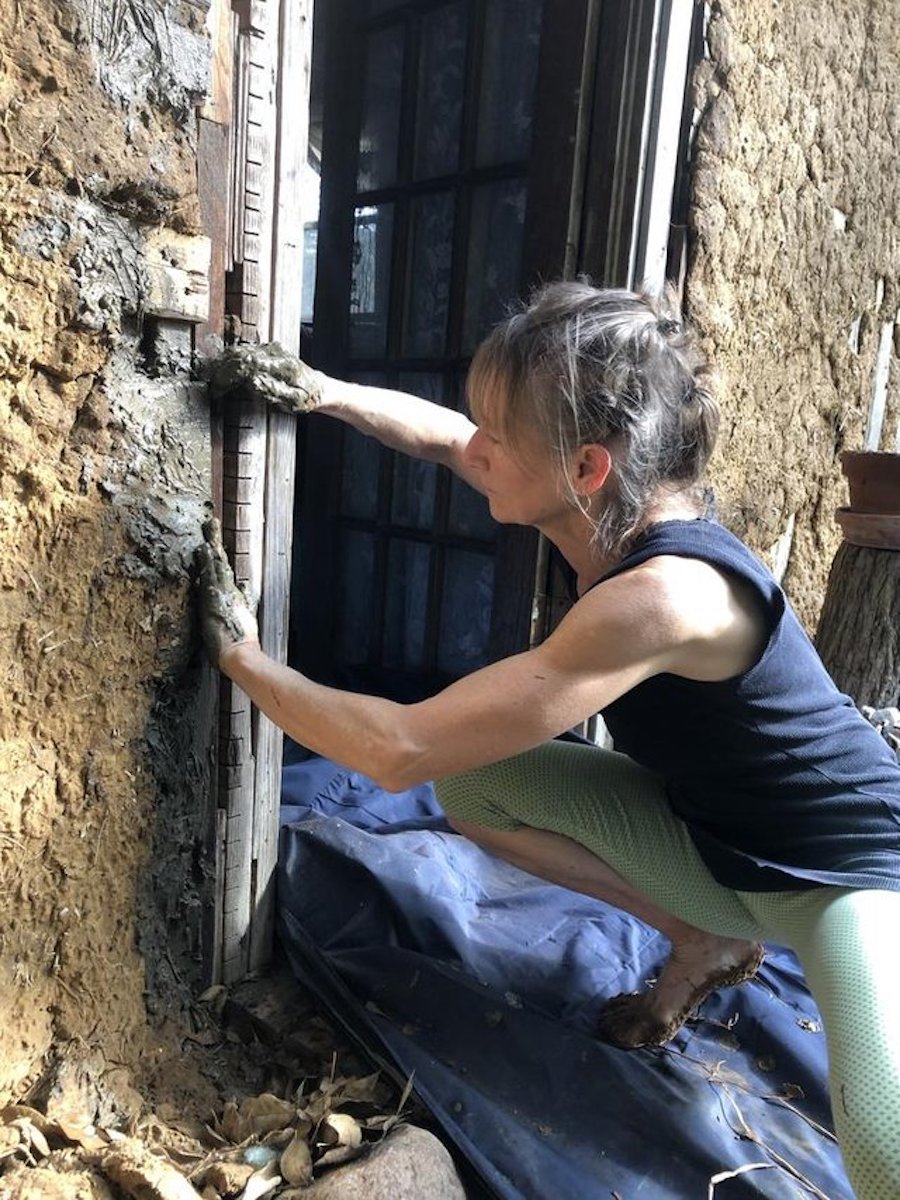
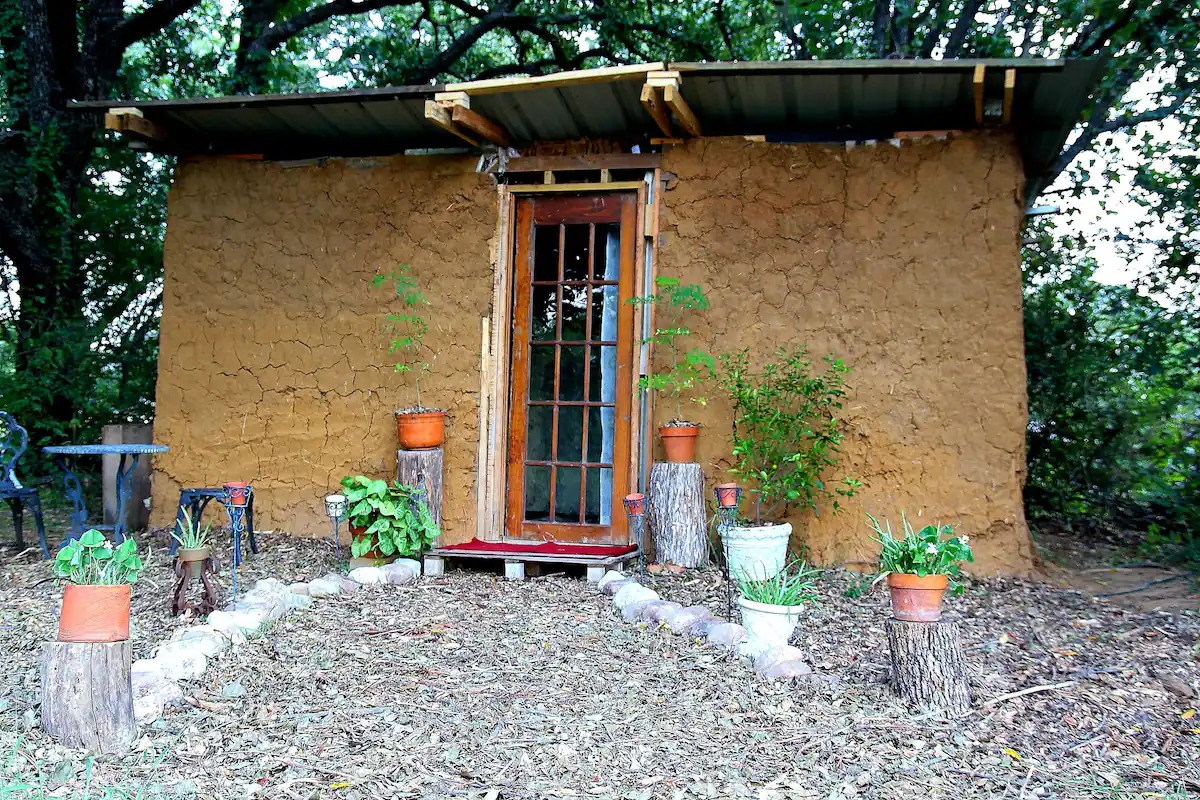
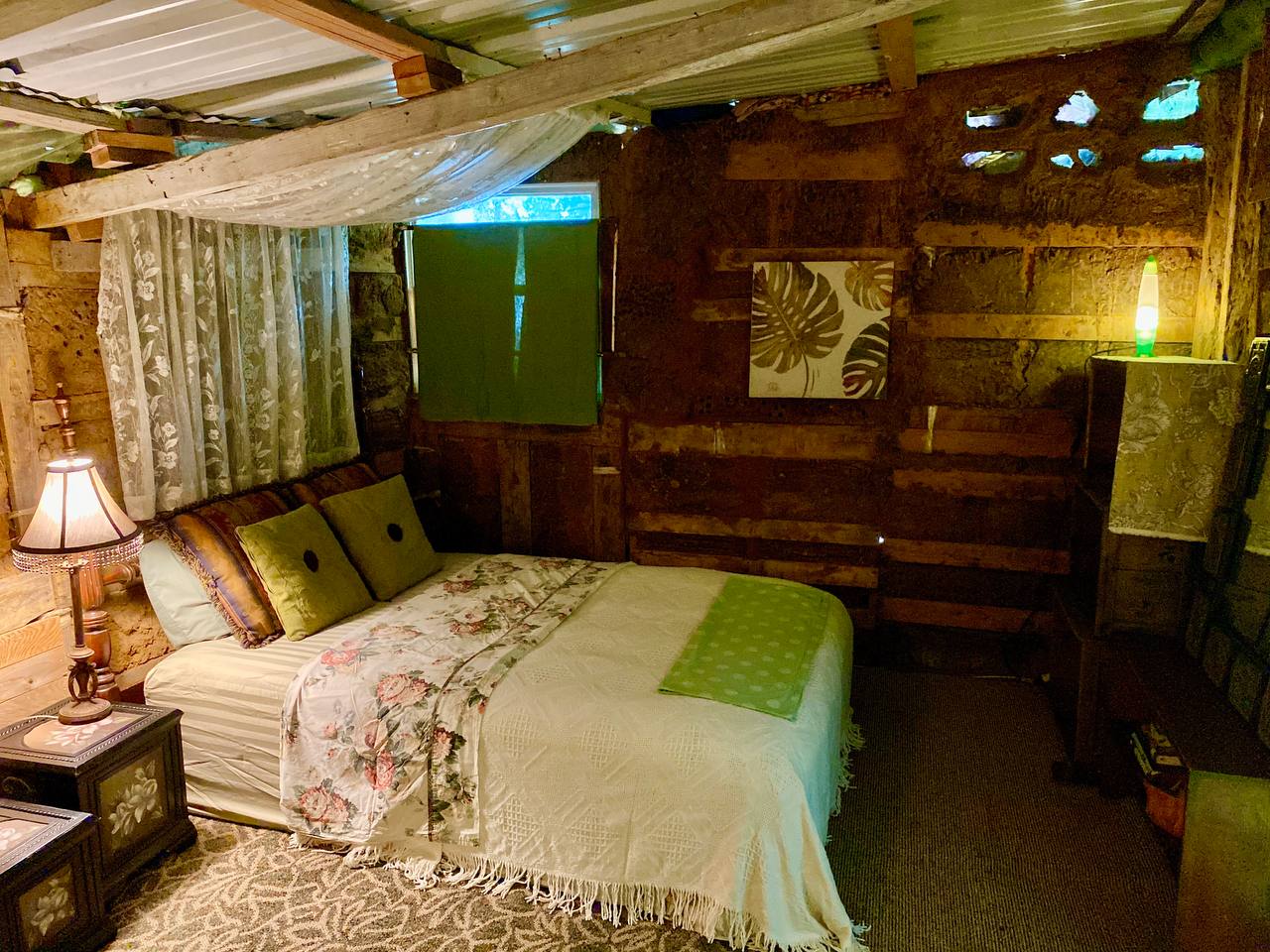
A local home improvement store donated a few dozen large wooden shipping containers to us in 2016 rather than forsake them to the landfill. To our surprise and delight, several of these were filled with completely useable materials like flooring and shelves! We used the materials, and upcycled the large containers themselves into minimalistic bedrooms just big enough for 1-2 people to rest cozy and comfortably. We nestled them under the shade of a mulberry tree, cut holes in the sides for windows and bug nets, installed shelving, and coated them in bright paints. We dub this area our Teeny Tiny Home Village.
Over the years, we have received even more donations of travel trailers which we converted into cute and cozy spaces for overnight guests and longer term volunteers. We also built ourselves an adorable bungalow with a queen-size loft bed in the bamboo forest out of entirely repurposed materials!
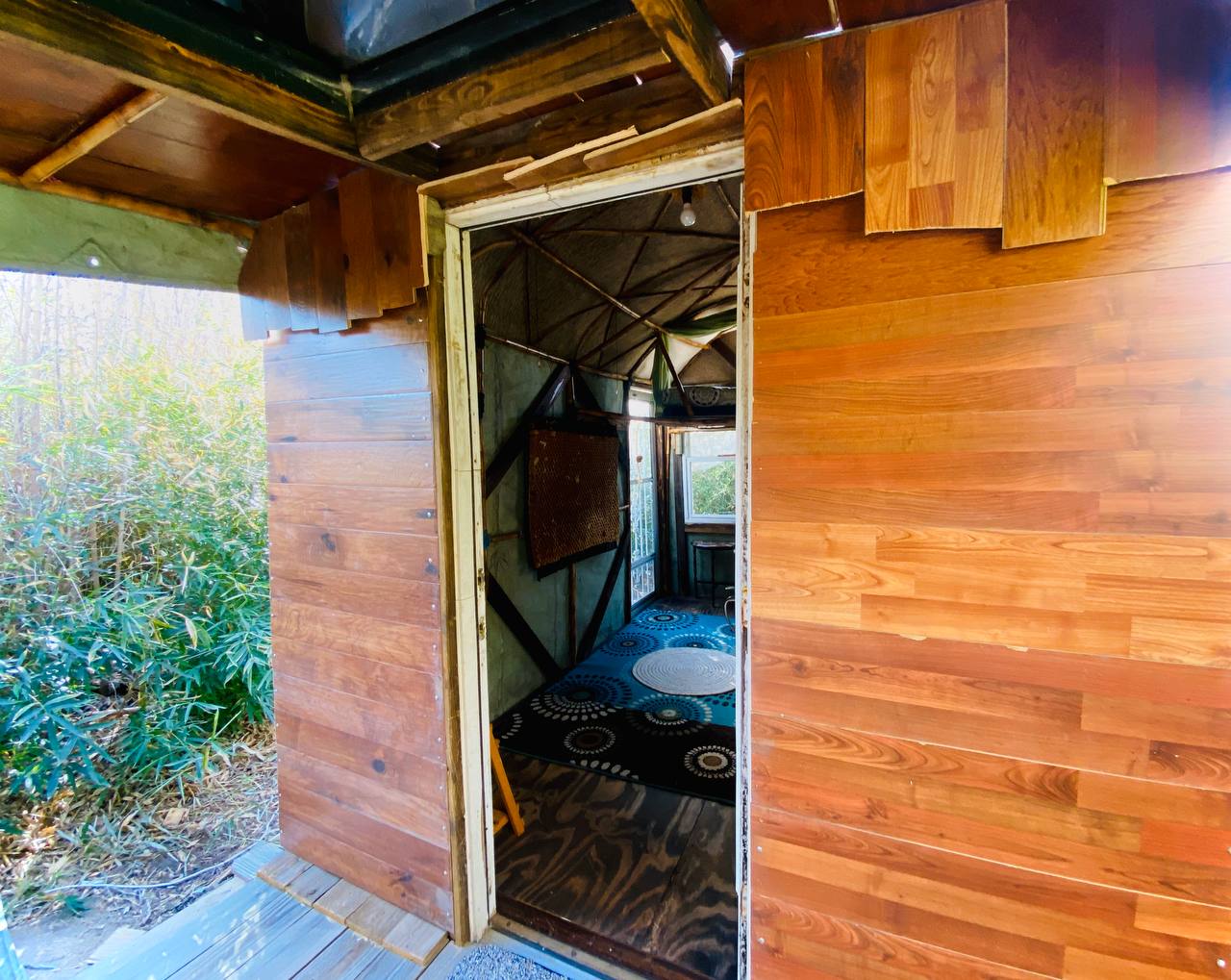

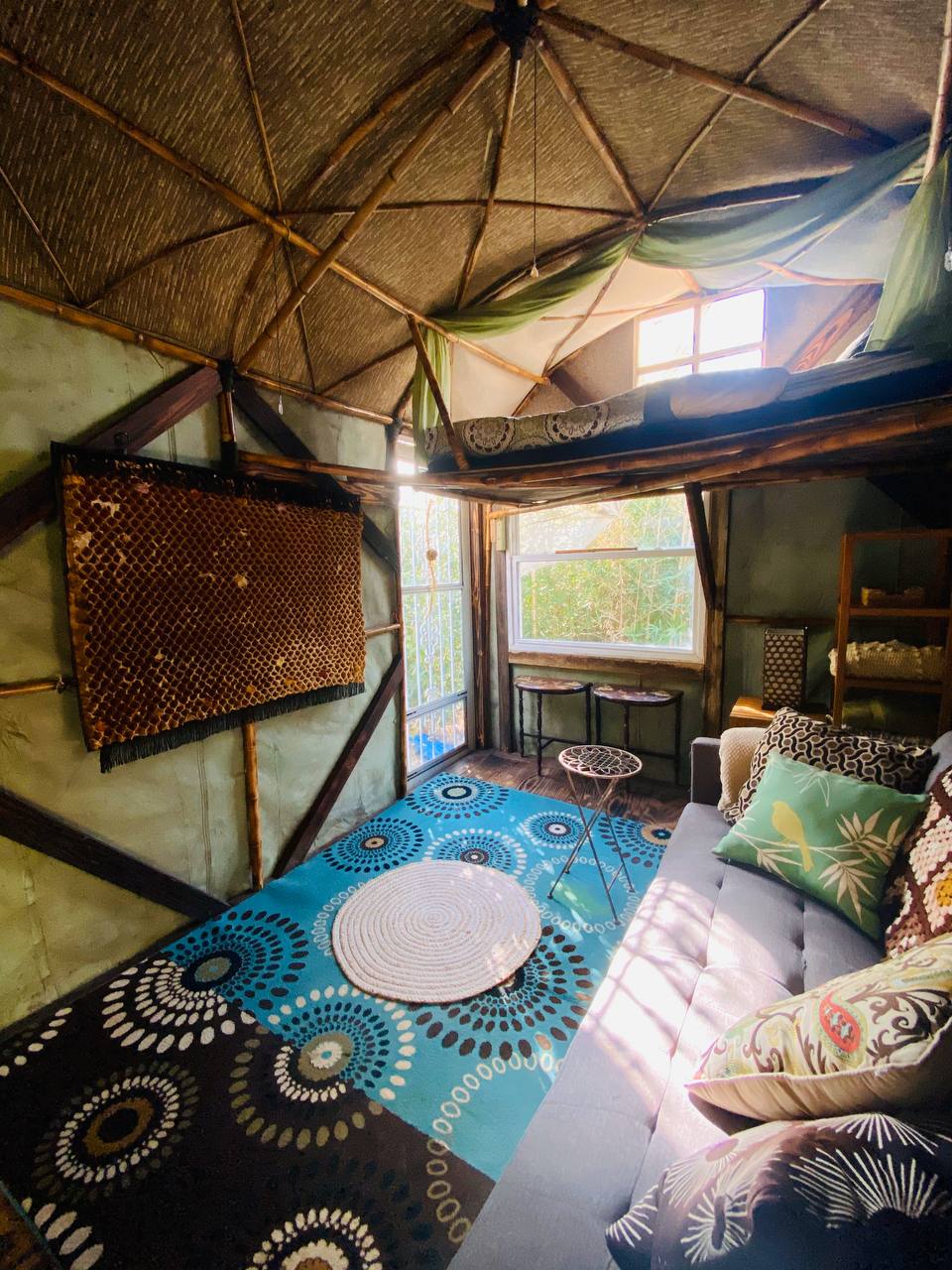
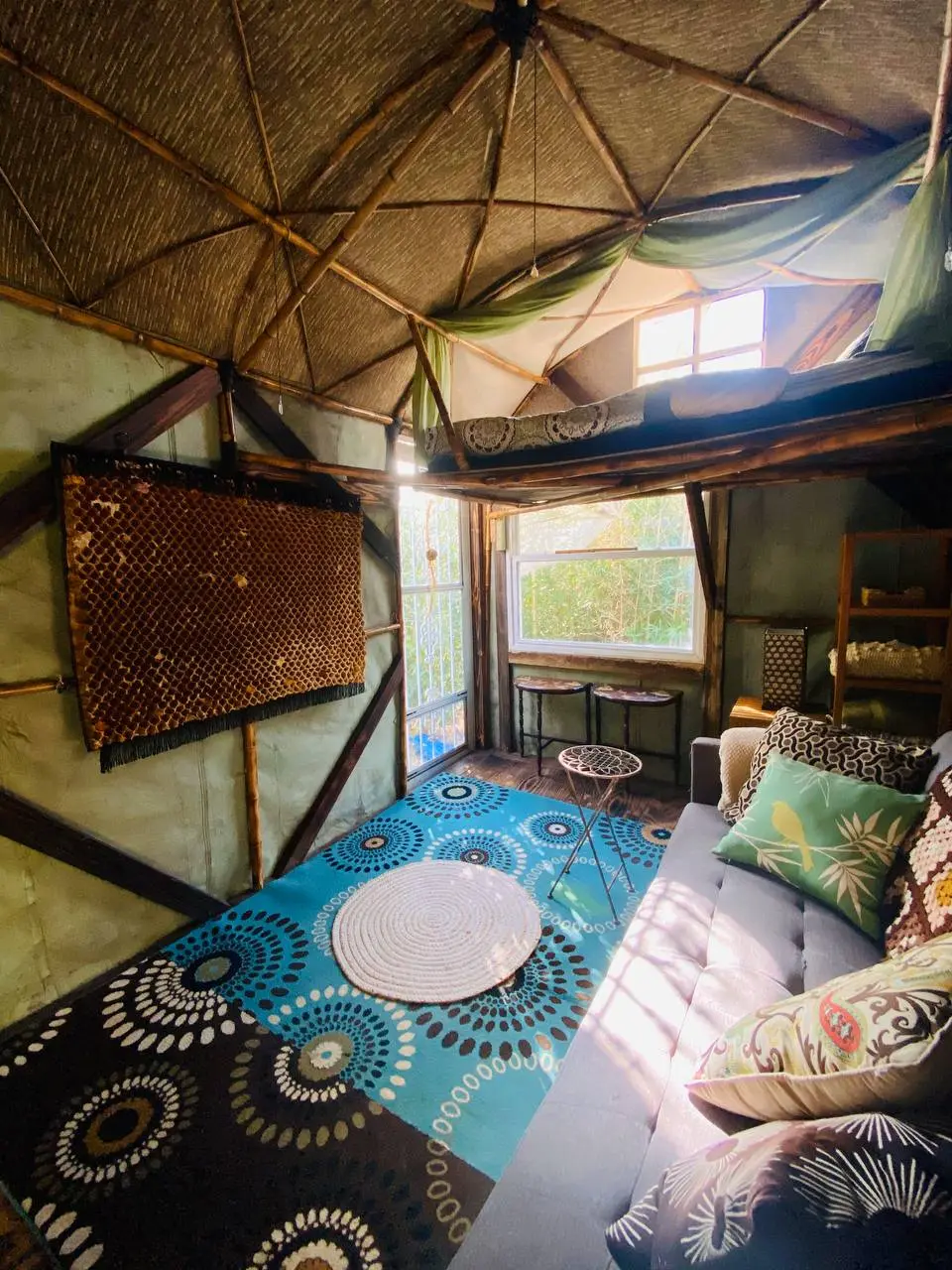
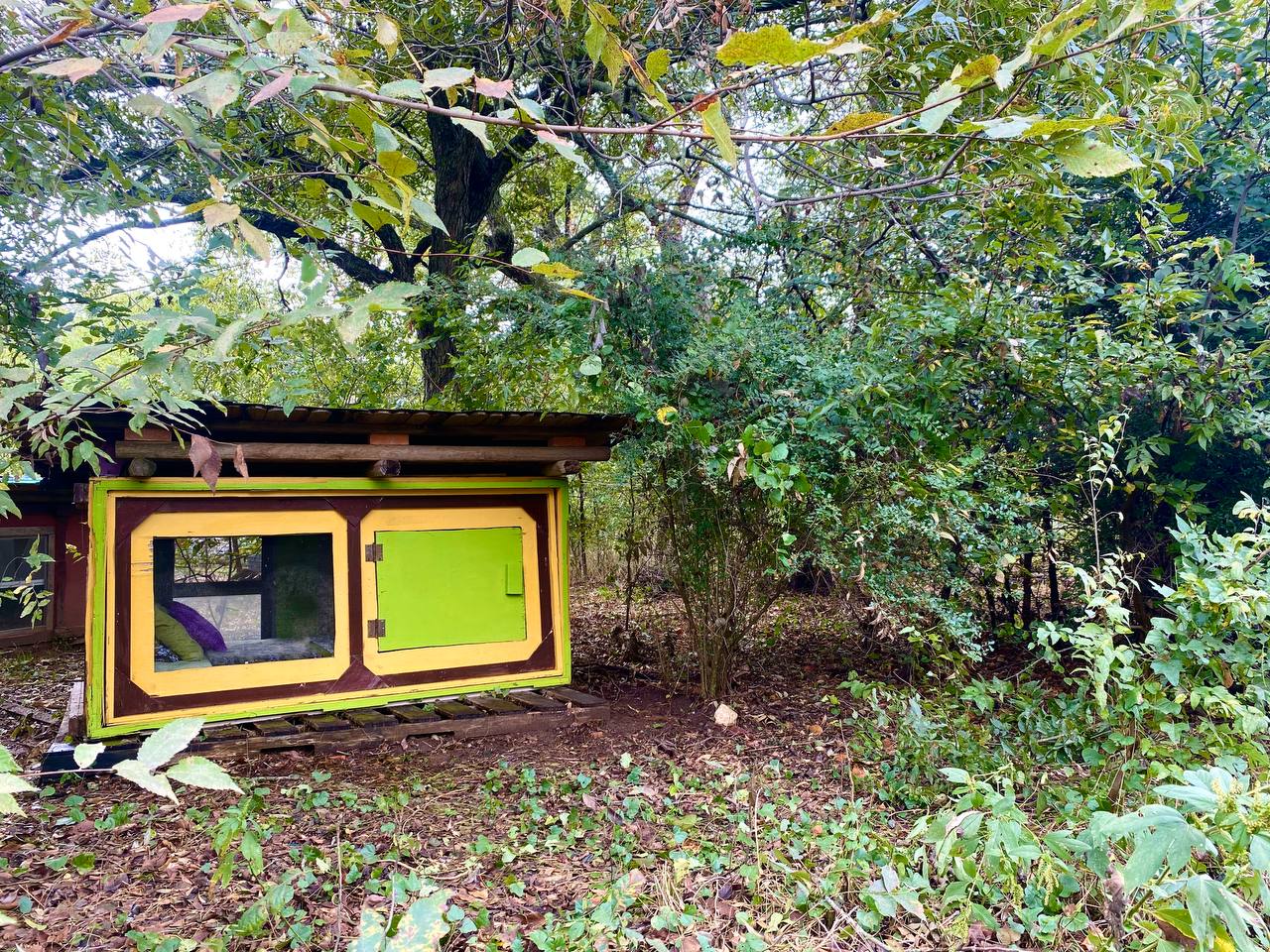

We also have several sheds built out of forsaken pallets and other materials rescued from their route to the landfill. We fabricate roofs and covers from re-purposed billboard tarps; they provide rain coverage as well as additional storage space and shade. This enhances our ability to control the indoor temperature during summer heat.
The City of Arlington has made it very difficult for us to thrive and has drained much of our energy, yet this is an important factor in why we are doing what we are doing. We are engaging lawful practices in court to get recognition for our freedom to live a sustainable life - even if it is "not up to code".
We have the resources and know how to expand very quickly with very comfortable buildings at a high degree of sustainability, but have been on hold due to the city's attempts and enforced slavery upon us. We are not scared nor are we backing down.
We are pushing forward without compliance, spending hundreds of hours using the law to prove we are free and can build our own buildings for our own way of life despite that they are not standard, run-of-the-mill, approved-by-code structures. We of course are aware of how unsustainable those buildings are, so we don't settle for living our free lives in them!
It is very important that conscious and free beings are able to choose for themselves what kind of homes they want to live in and build. The resources and know-how are worthless if a dictator is forcing compliance on the way of life. This is an essential aspect of our purpose - not just in building, but in every facet of life. We take lawful steps to gain recognition of our freedom so that not only we, but EVERYONE can live free!
As standard American solutions for the basic needs of human life support are utterly wasteful and unsustainable, The Garden of Eden does not employ standard procedures for everyday functions like cooking and restrooms. Rather, we have other systems in place that utilize what resources we have in great abundance and also alchemize what would have otherwise become waste.
We do our cooking on wood fire, either in our outdoor kitchen during warmer seasons, or inside the main house on our wood burning stove whenever it is cold enough to warrant its use for heating up our home. We have chosen this method not because burning wood is the most sustainable way to generate heat, but because given the resources available to us (which include loads of free wood that would otherwise be "trash"), it is the most sustainable choice.
We don't use central heating or air conditioning. Our bodies and minds are strong and healthy because we actually adapt to the environment, but of course Quinn provides sustainable alternatives for dealing with extremes, because it's still nice to enjoy creature comforts! Wood fire is fantastically cozy in the winter time, as are the hot rocks we heat on the wood burning stove to wrap in towels and snuggle up to when we go to bed in the cold months. In the summer time, we have a wonderfully Earth-considerate and very, very refreshing alternative:
We have an outdoor shower that runs from our well, therefore we call it the well shower! What a subtle play on words this is though, because the year-round 55 degree well water is also much, much healthier to the human organism than polluted municipal tap water used for standard indoor plumbing. It is incredibly refreshing in the summer time, where it often rises over 100 degrees for months on end out here in Texas. And it's brisk and crisp in the winter, so we choose to focus on the wellness benefits that well cold showers are well known to provide. The water runs through the stone floor right back into the soil to water nearby plants.
For dealing with our human waste, rather than polluting what limited fresh water there is and forsaking the nutrient value that remains, we compost all solid and liquid excrement, using composting toilets and a separate, long-term compost section. We use our "waste" to create new Earth, grow plants, and make food in the sacred cycle of life-death-rebirth.
As far as physical fitness goes, who needs to join an expensive gym and drive there every day when there are so many opportunities right at home to support the land and get a thorough, free, and sustainable workout?!
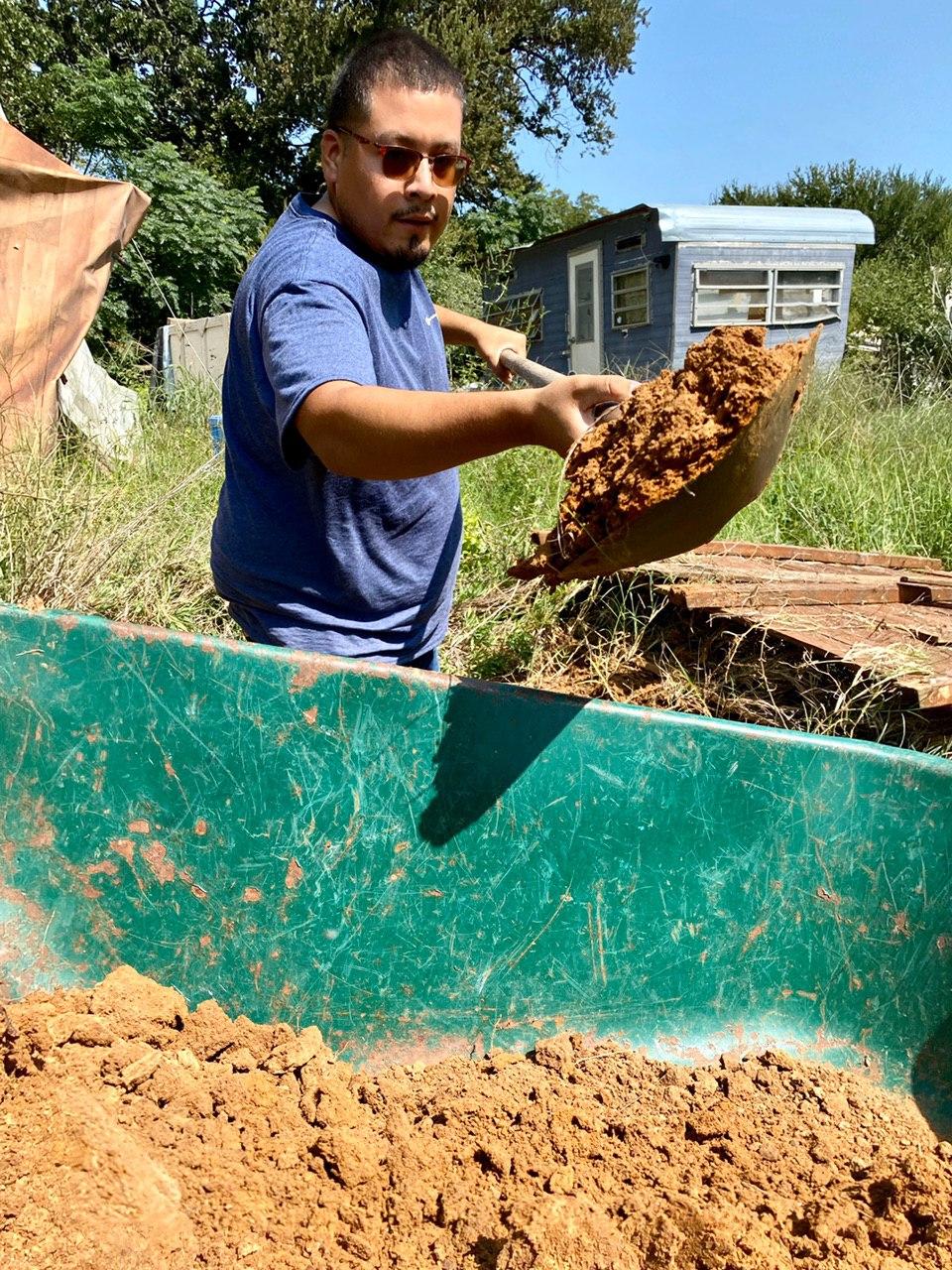
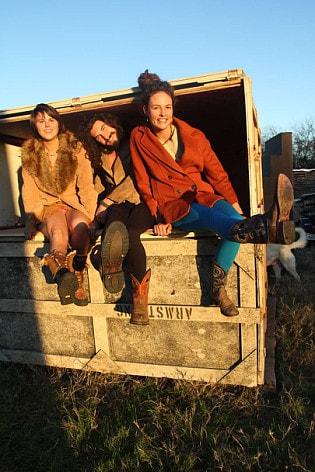
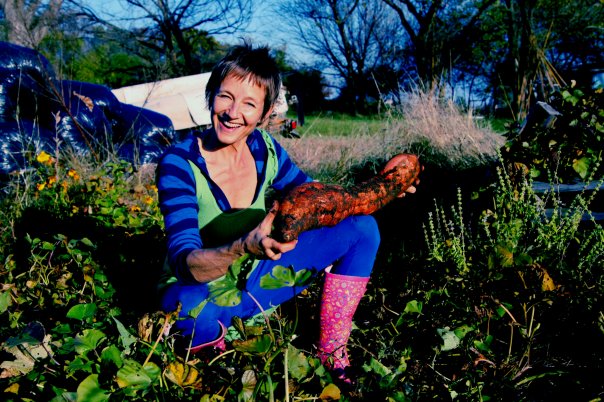
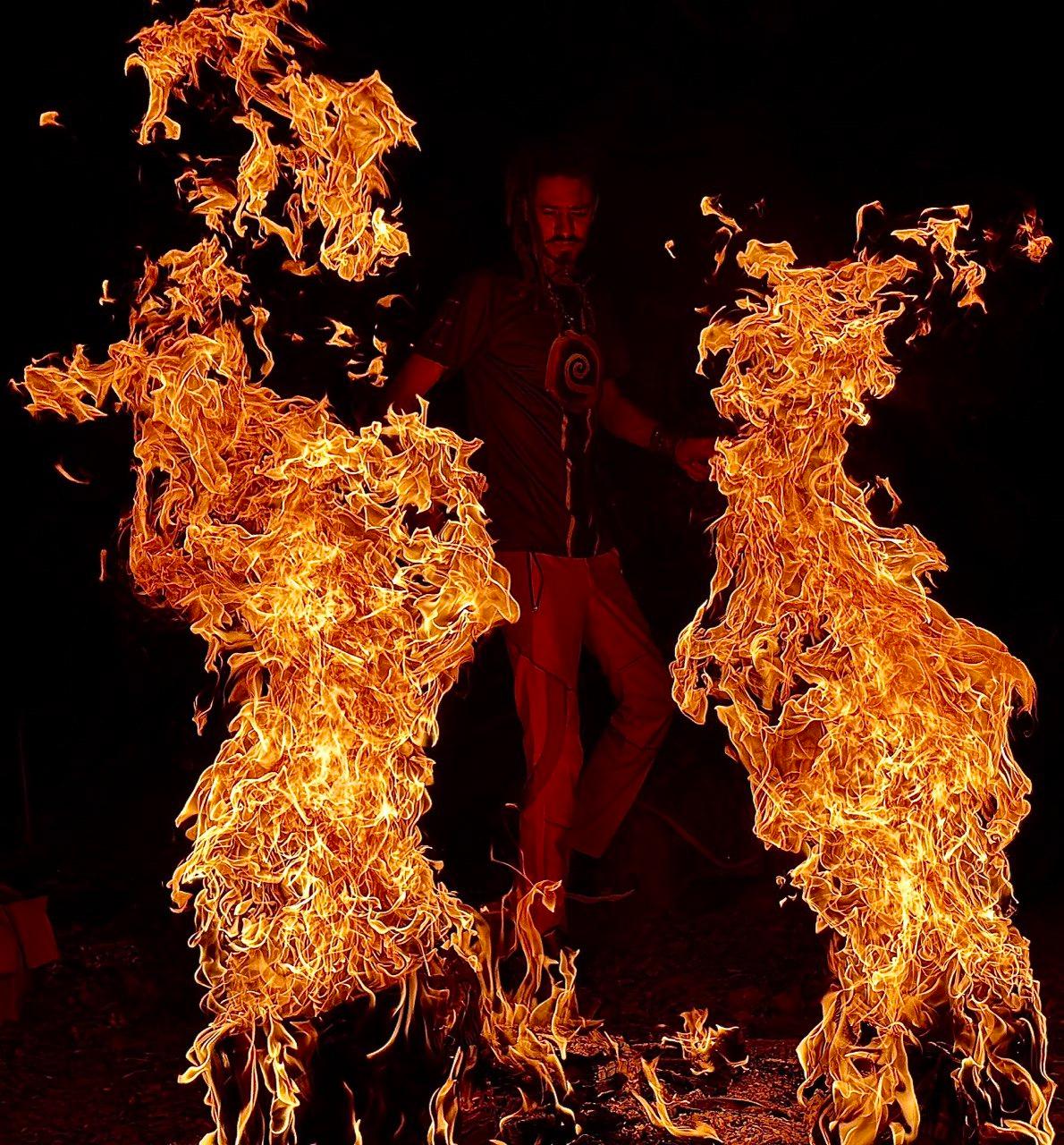
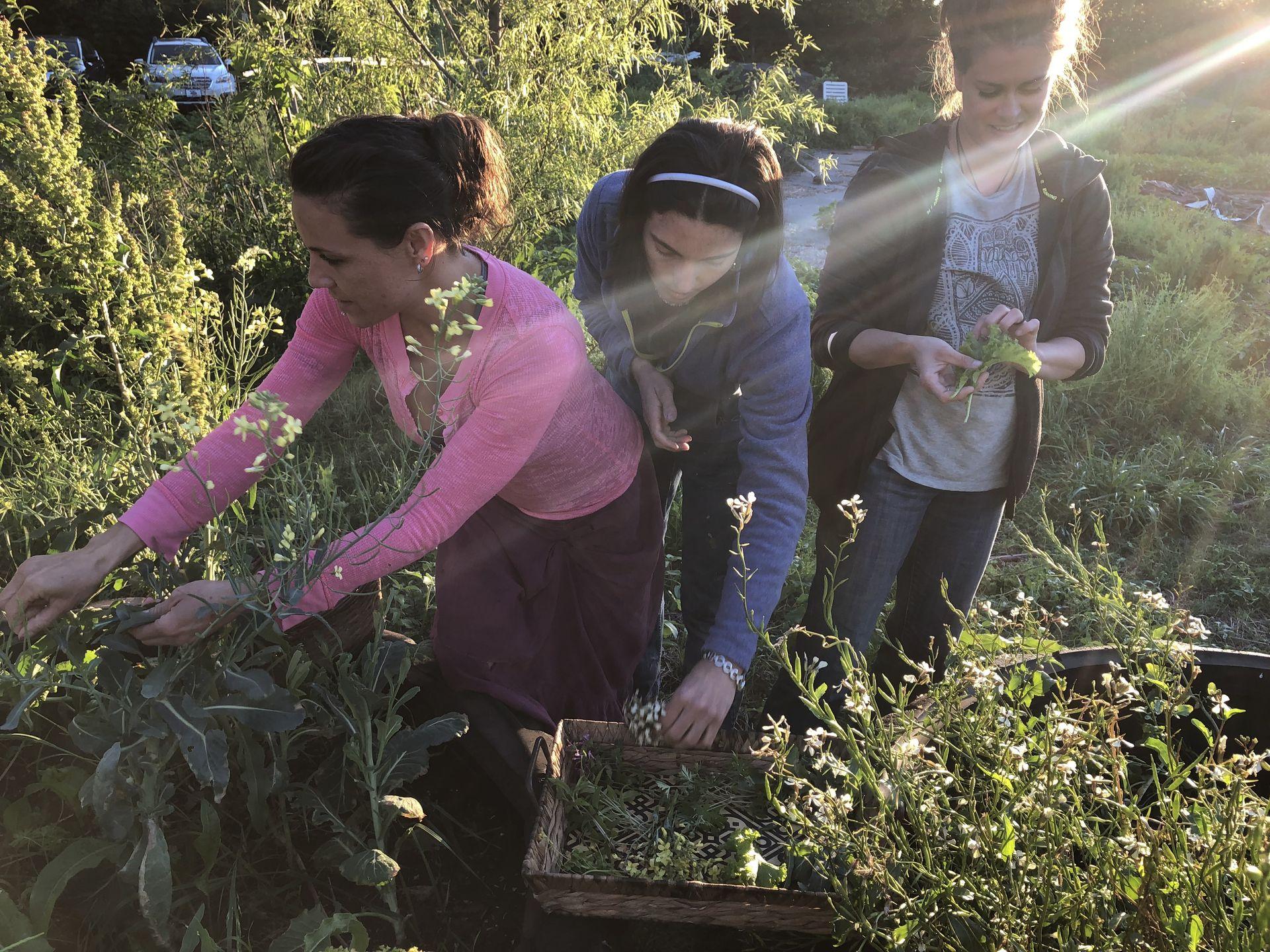
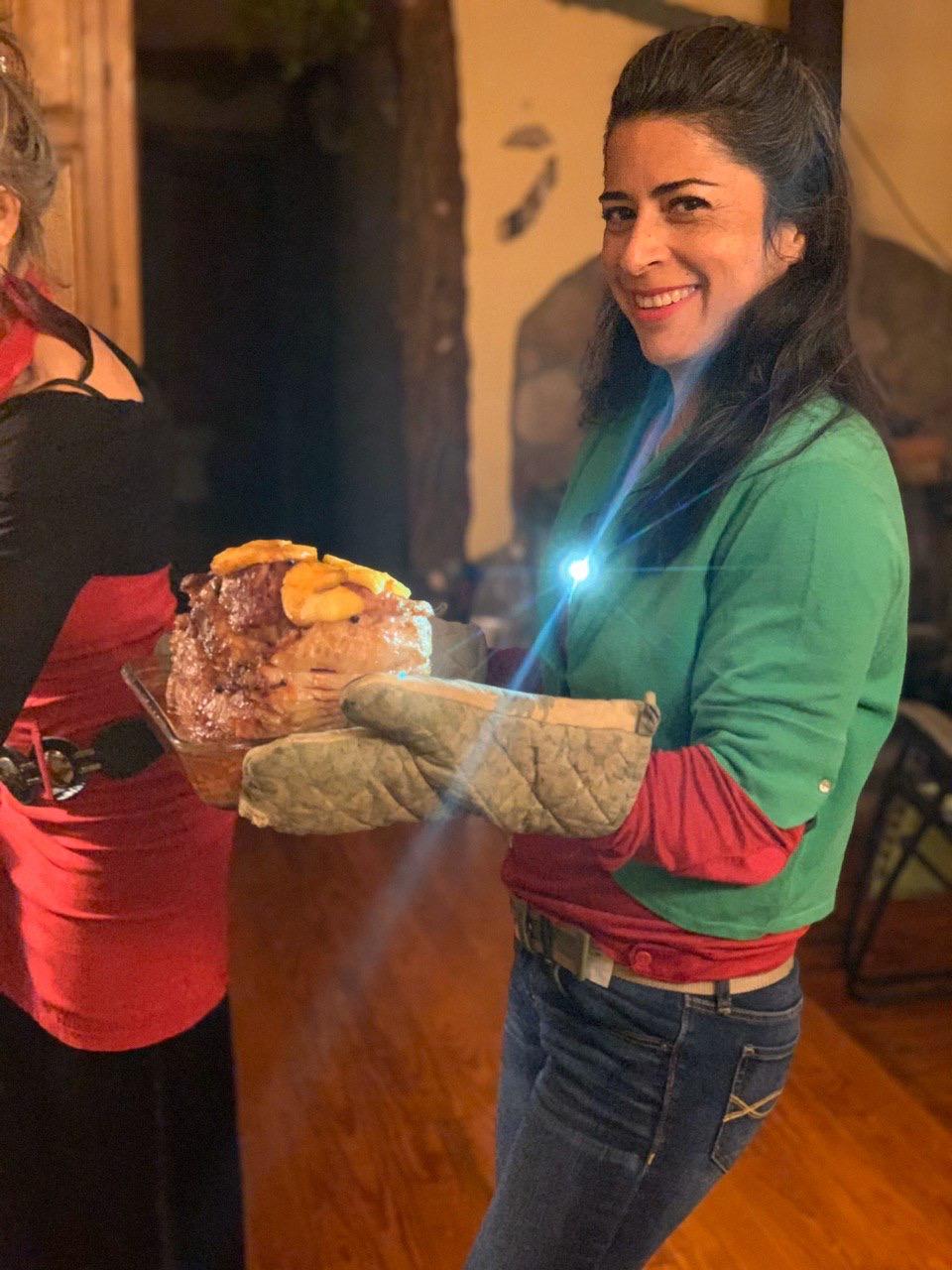
∾⊱⩫ Our People⩫⊰∾
∾⊱⩫ Our People⩫⊰∾
We are a group of individuals who have come together with the common values of Freedom, Sustainability, and Consciousness. The shared importance of these core aspects of being allows us to live as a unit, participating as individuals, and yet working with parallel purpose and mutually beneficial inspiration. It is thereby easy and natural that we achieve common goals in both tangible and intangible aspects of reality, without having to “work” or to do anything we are not truly interested in doing.
We honor the balance and relationship of Freedom and Responsibility, as that applies to each of us as individuals and as it affects group dynamics. When living connected, freely, and responsibly, it is easy and natural to see how that which benefits one also benefits the whole group and vice versa, and also how that which is to the detriment of one is also to the detriment of the whole group. It is also easy and natural to see how each person brings a unique set of perspectives, talents, abilities, and inspirations to the table; when each person is given the freedom and responsibility to flourish, the group as a whole benefits from the complementary and synergistic dynamics that naturally evolve.
Our vision for the expansion of The Garden of Eden is to allow a community to grow, as individuals who share our values and inspirations are drawn to participate and find fulfillment and purpose in investing and applying themselves to this community. Life is meant to be easy, enjoyable, and abundant in the New Paradigm, and community is a key aspect of that as it plays out among us. Human beings are social animals by nature and thrive best in environments where the social element is incorporated and honored at a foundational level. When you have a group of people living together with common values and goals, it is incredibly easy for every task and need to be met simply by everyone doing exactly what they love to do.
Through the increasing value brought by each individual, this community shall be activated to a high degree of thrival not only capable of fully supporting and sustaining all here, but of providing a rich and fulfilling experience of life. We are inspired to create new communities in other locations that are also based on the core values that are the foundation for our life here and now!


Community founder and director Quinn Eaker is a lifelong student and advocate of natural health. He is the author of Full Spectrum Health and THE BOOK: Ultimate Guide to Health Benefits & Uses of 35% Food Grade Hydrogen Peroxide, and has been featured in several award-winning documentaries including The Big Secret and Something Ain't Right.
He is quickly becoming a well-known icon for freedom, sustainability, and empowerment, having spoken on dozens of local, national, and international tv and radio shows and conferences including the Ron Paul Show, Alex Jones’ Infowars, and the Libertarian State Party Convention broadcast 2015, in which he was the Libertarian nominee for Texas legislature.
Community founder and director Quinn Eaker is a lifelong student and advocate of natural health. He is the author of Full Spectrum Health and THE BOOK: Ultimate Guide to Health Benefits & Uses of 35% Food Grade Hydrogen Peroxide, and has been featured in several award-winning documentaries including The Big Secret and Something Ain't Right.
He is quickly becoming a well-known icon for freedom, sustainability, and empowerment, having spoken on dozens of local, national, and international tv and radio shows and conferences including the Ron Paul Show, Alex Jones’ Infowars, and the Libertarian State Party Convention broadcast 2015, in which he was the Libertarian nominee for Texas legislature.
He was twice featured as the cover story of the local Dallas Observer, and he has spoken at dozens of local, regional, and international festivals and public events including the I AM Yoga, Art & Music Festival of Tulsa, OK; Blisstonia; Head for the Hills; Art Outside Festivals of TX; Bushweek Festival of Australia; Australian Unschooling Conference; Burning Man of Nevada; Rethinking Everything Conference of Dallas; Crypto-Con in San Diego; and SteemFest in Lisbon, Portugal.
Quinn is an artist of LIVING. His work IS life itself and the embodiment and manifestation of his values - freedom, authenticity, sustainability, integrity, responsibility, and family, to name a few. He lives true to his heart, his values, and his morals, with great consideration, consciousness, and conviction. He is an extraordinary man of great insight, intellect, and inspiration, and has been invited around the world to share his consciousness with others.
He was twice featured as the cover story of the local Dallas Observer, and he has spoken at dozens of local, regional, and international festivals and public events including the I AM Yoga, Art & Music Festival of Tulsa, OK; Blisstonia; Head for the Hills; Art Outside Festivals of TX; Bushweek Festival of Australia; Australian Unschooling Conference; Burning Man of Nevada; Rethinking Everything Conference of Dallas; Crypto-Con in San Diego; and SteemFest in Lisbon, Portugal.
Quinn is an artist of LIVING. His work IS life itself and the embodiment and manifestation of his values - freedom, authenticity, sustainability, integrity, responsibility, and family, to name a few. He lives true to his heart, his values, and his morals, with great consideration, consciousness, and conviction. He is an extraordinary man of great insight, intellect, and inspiration, and has been invited around the world to share his consciousness with others.


The Garden of Eden EcoVillage and all its brands and programs have been birthed from his vision, passion and insight. It is through his guiding sight and clear perception that this community and its inhabitants have grown and evolved. Through his example and leadership, a high standard of living in honor, integrity, and responsibility are the blessings and the masters of the inhabitants of this small community.
With unwavering dedication to his values, Quinn is passionately and purposefully living out his own dream of living life freely and fully with the suppressed and conditioned masses, and he willingly shares it all with anyone who is ready.
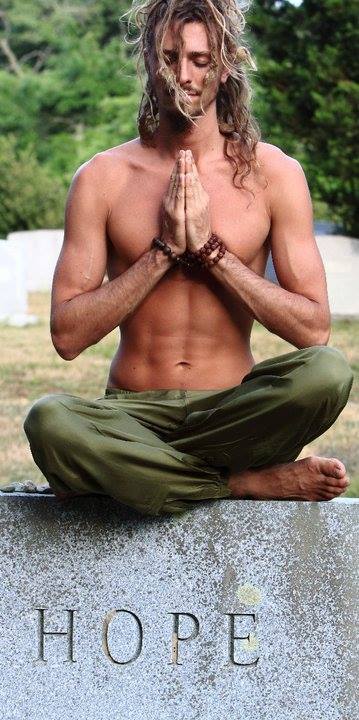

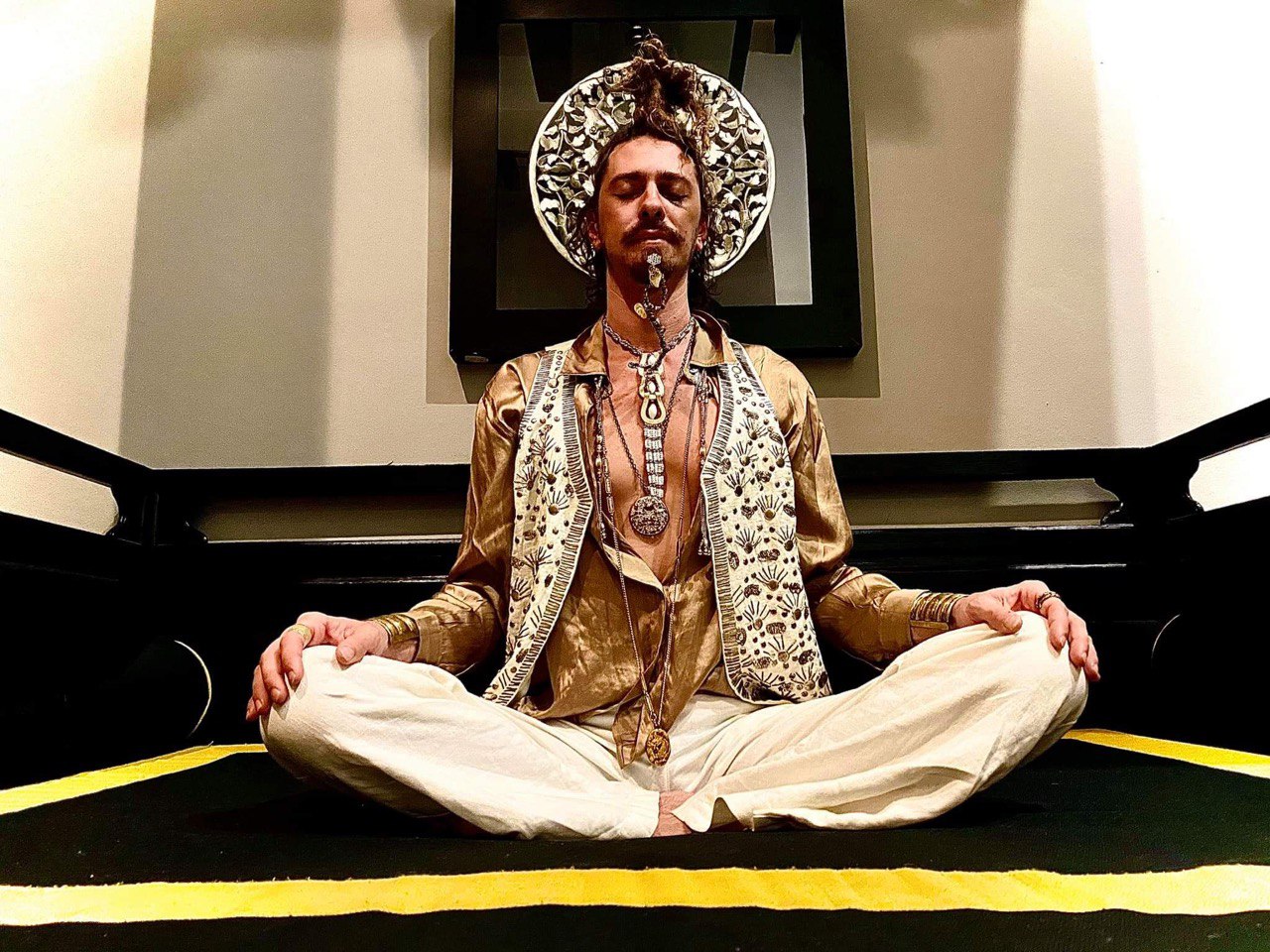

Quinn's History
As a youth, Quinn was a sickly boy, a slave to his fears, impulses, weakness, and conditioning, who found nothing in this world to admire or strive for, only disappointment and despair. There was no livelihood, no relationship, no occupation at all that appeared to have any real truth, depth, or value among all that he had seen. He wished that he would either find or make something better than everything he had witnessed so far, or to live no more.
At seventeen, he found a glimpse of hope and poured all his energy into that ray of light, channelling all of his energy into spirituality. Although he was at the time living in Hollywood and working as a model, he spent all his free time in meditation, contemplation, and study of his spirituality. He was gifted with the fulfillment of his wish, and experienced a full spiritual awakening, a moment of total oneness with all, pure beingness, pure love, pure bliss. He then spent the next 5 years primarily in meditation and self reflection, replacing his old paradigm conditioning of fear based living, and integrating this new level of spiritual awareness in its stead into every nook and cranny of his being. He gave up all relationships, jobs, and material things - everything really! - in pursuit of spiritual enlightenment. He states that he wouldn't have been able to achieve it if he hadn't let it all go.
In 2008, Quinn began speaking and consulting on a wide range of topics, but most especially sustainability, health, parenting, relationships, and business. In addition to his worldwide speaking engagements, Quinn has hosted hundreds of workshops, classes, and lectures at The Garden of Eden from 2010 until the present, and continues to offer consulting and coaching to people here and across the world.
In 2009, he and Shellie began fertilizing the soil that would become The Garden of Eden. The two plus years that they spent in intimate communion were so fulfilling that Shellie was inspired to gift to Quinn the full control and rights to the land known as The Garden of Eden so that he could continue to fulfill his dream of creating an eco-village.
He currently offers personal health consultations and coaching services through The Garden of Eden, High Vibe Health, and his own website.
www.quinneaker.com
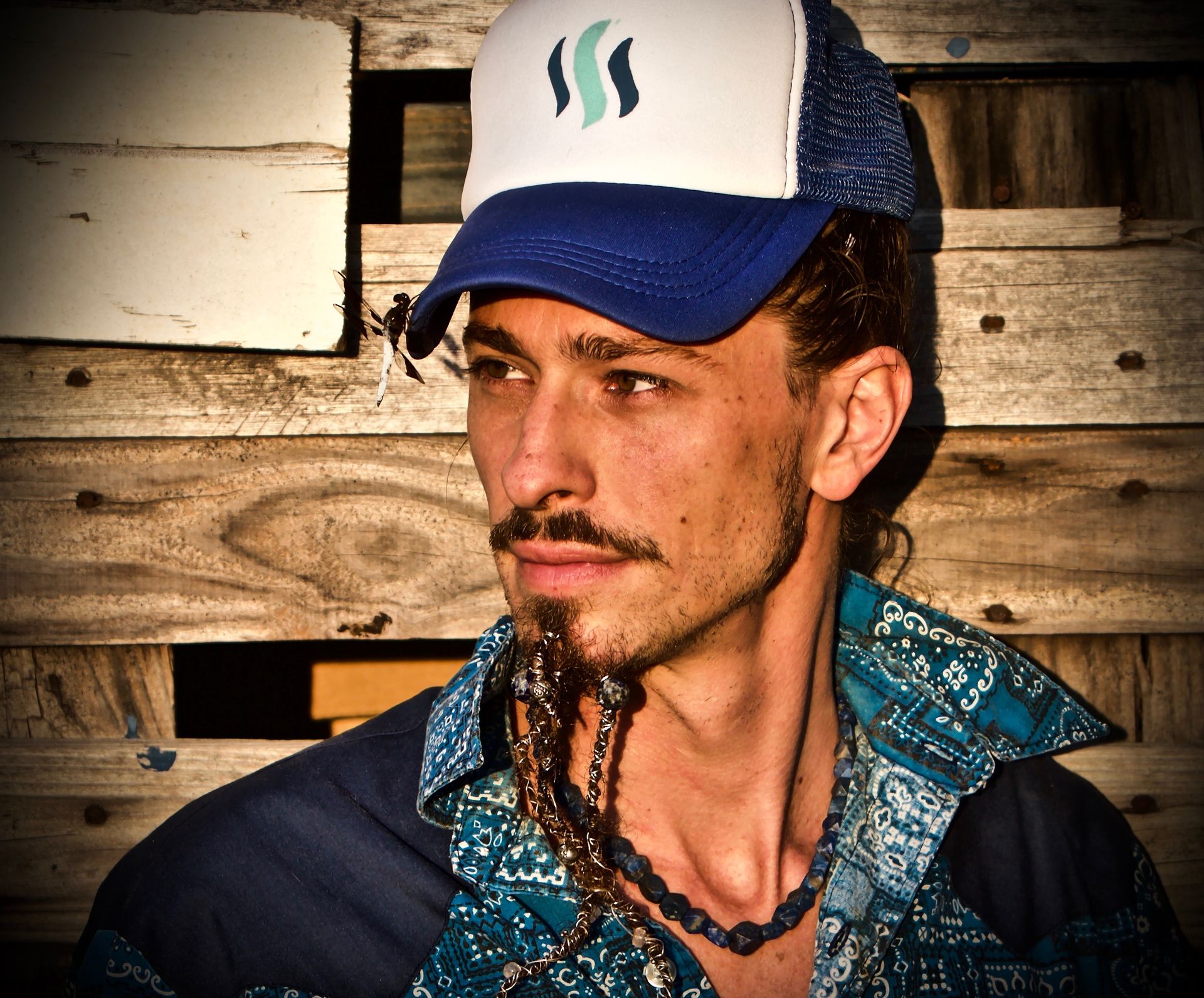
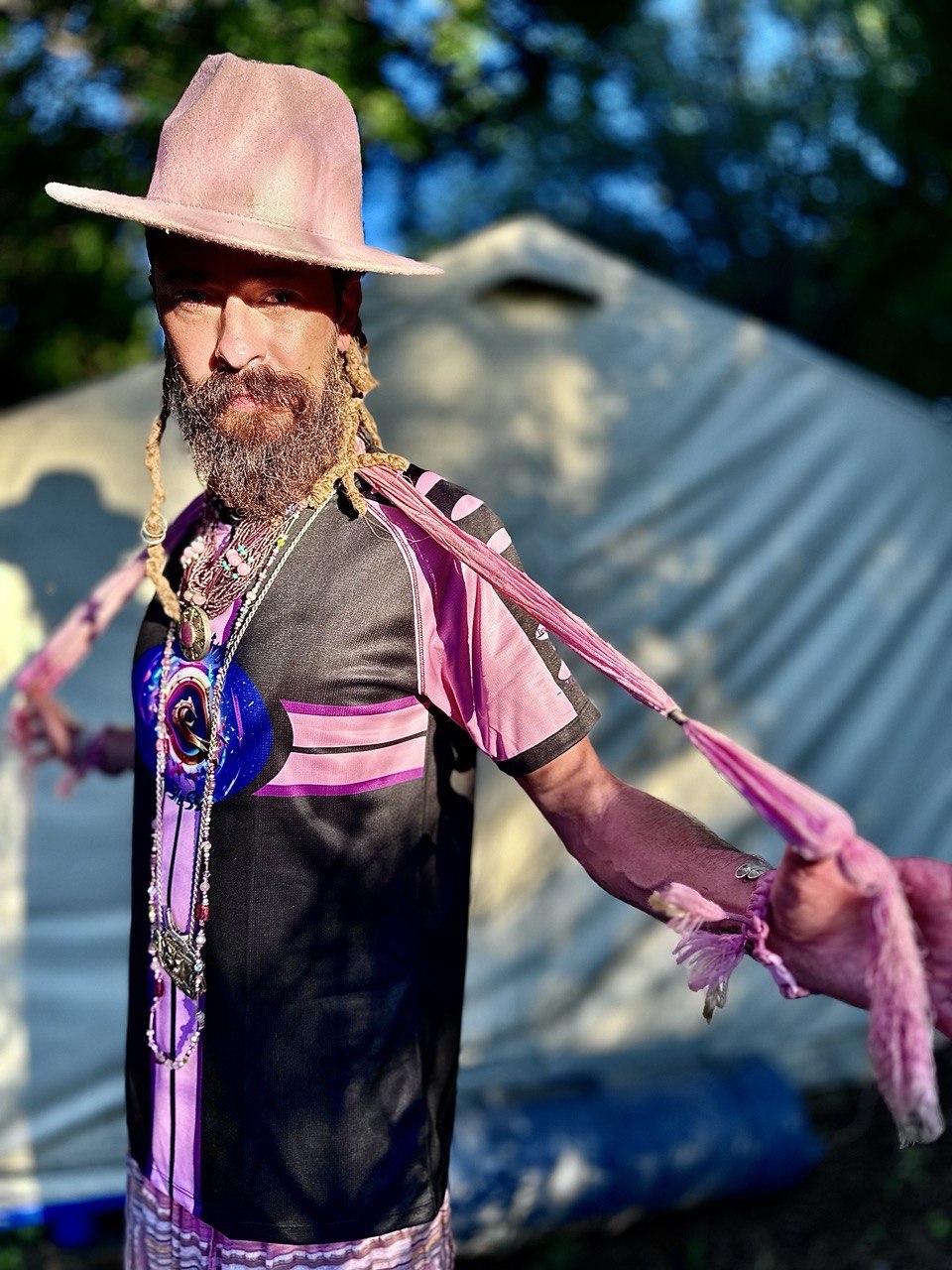

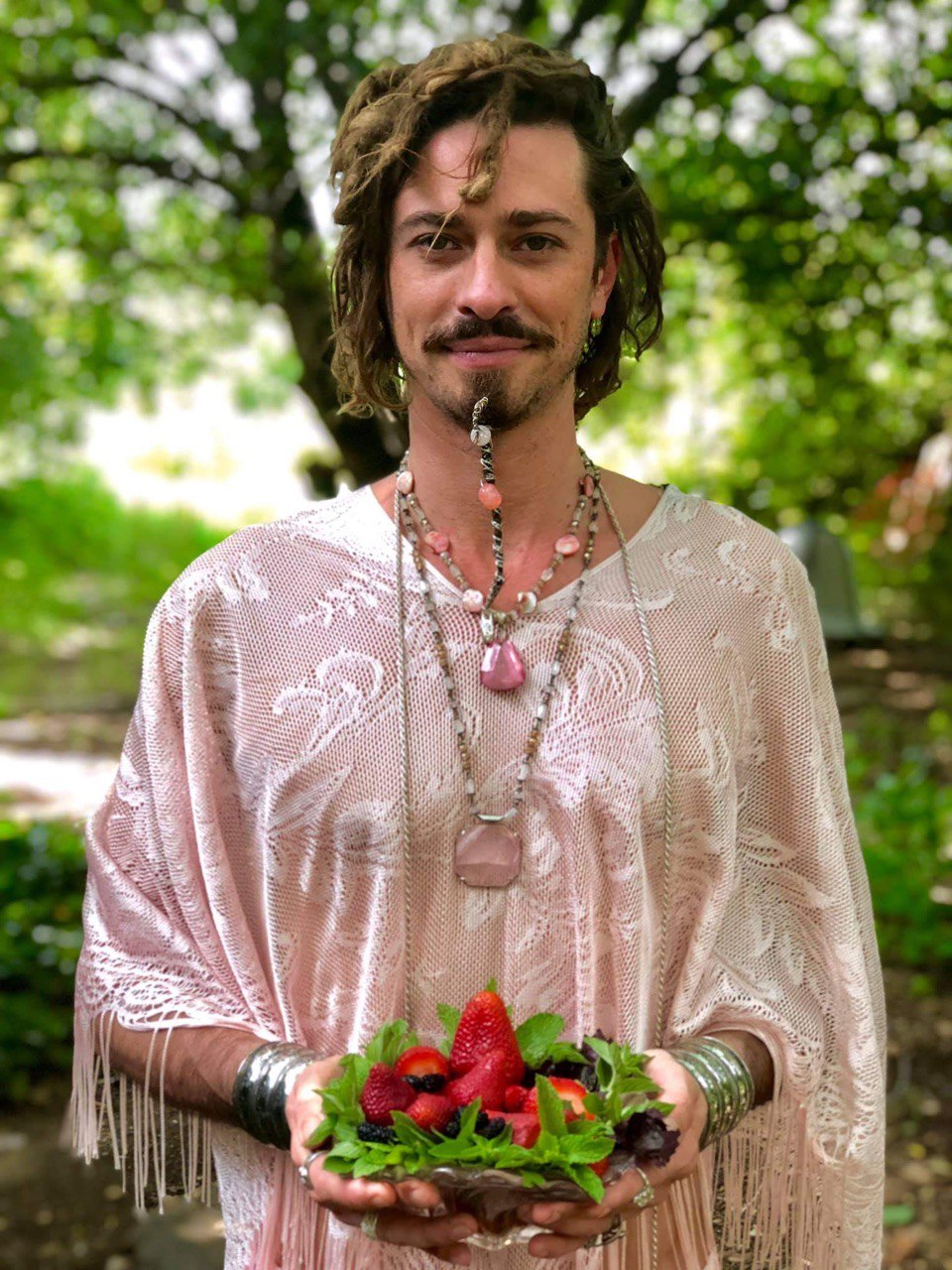




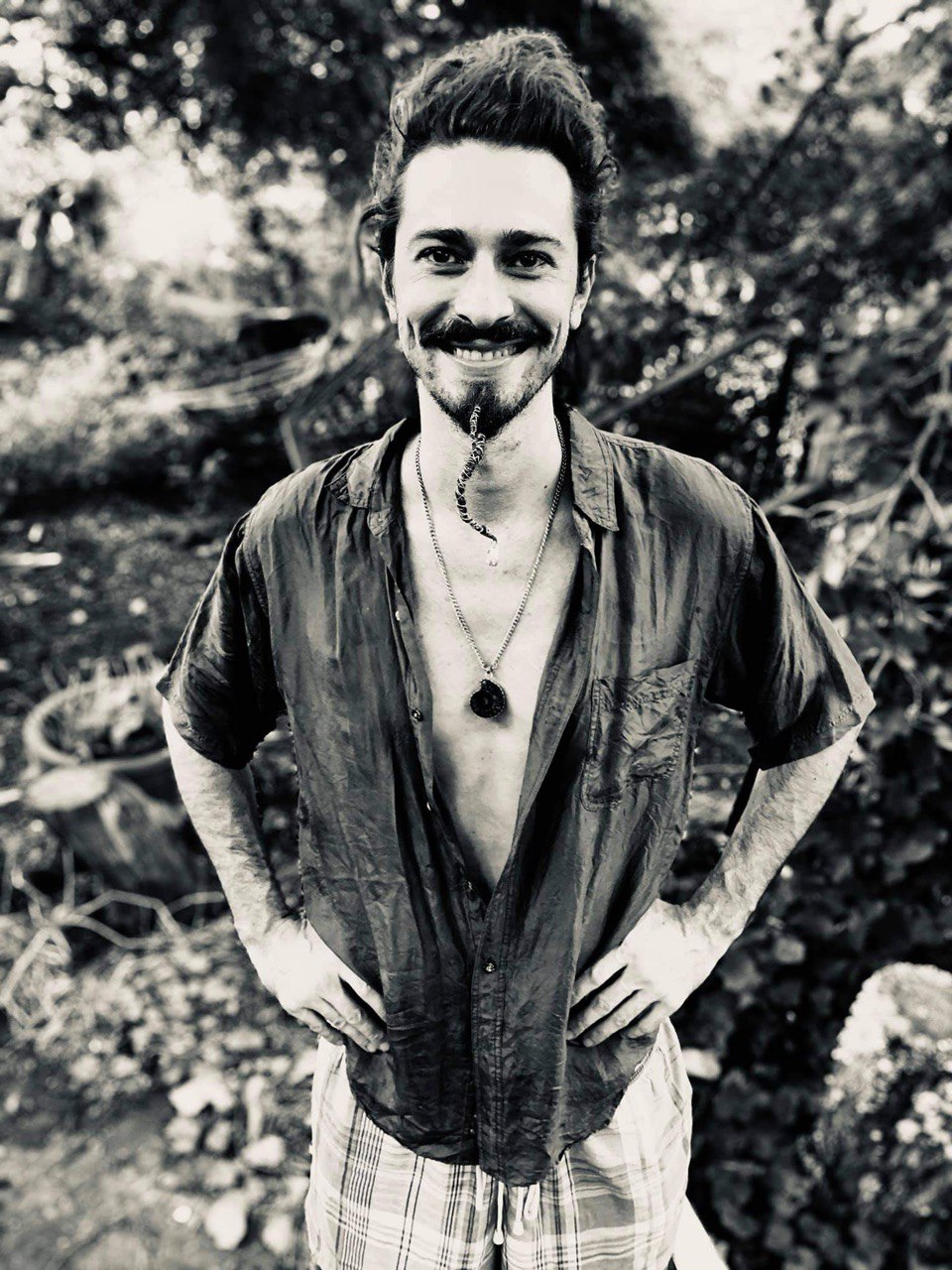
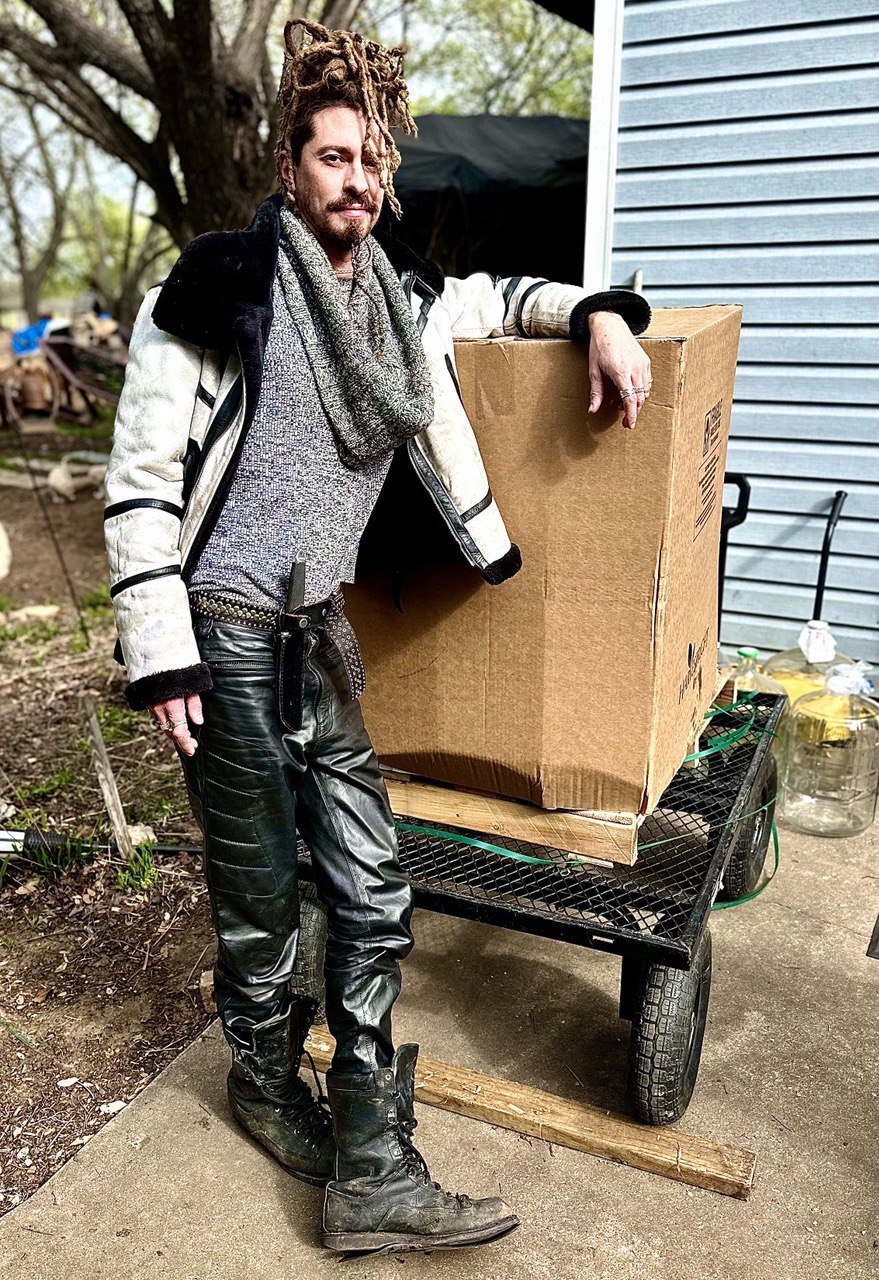



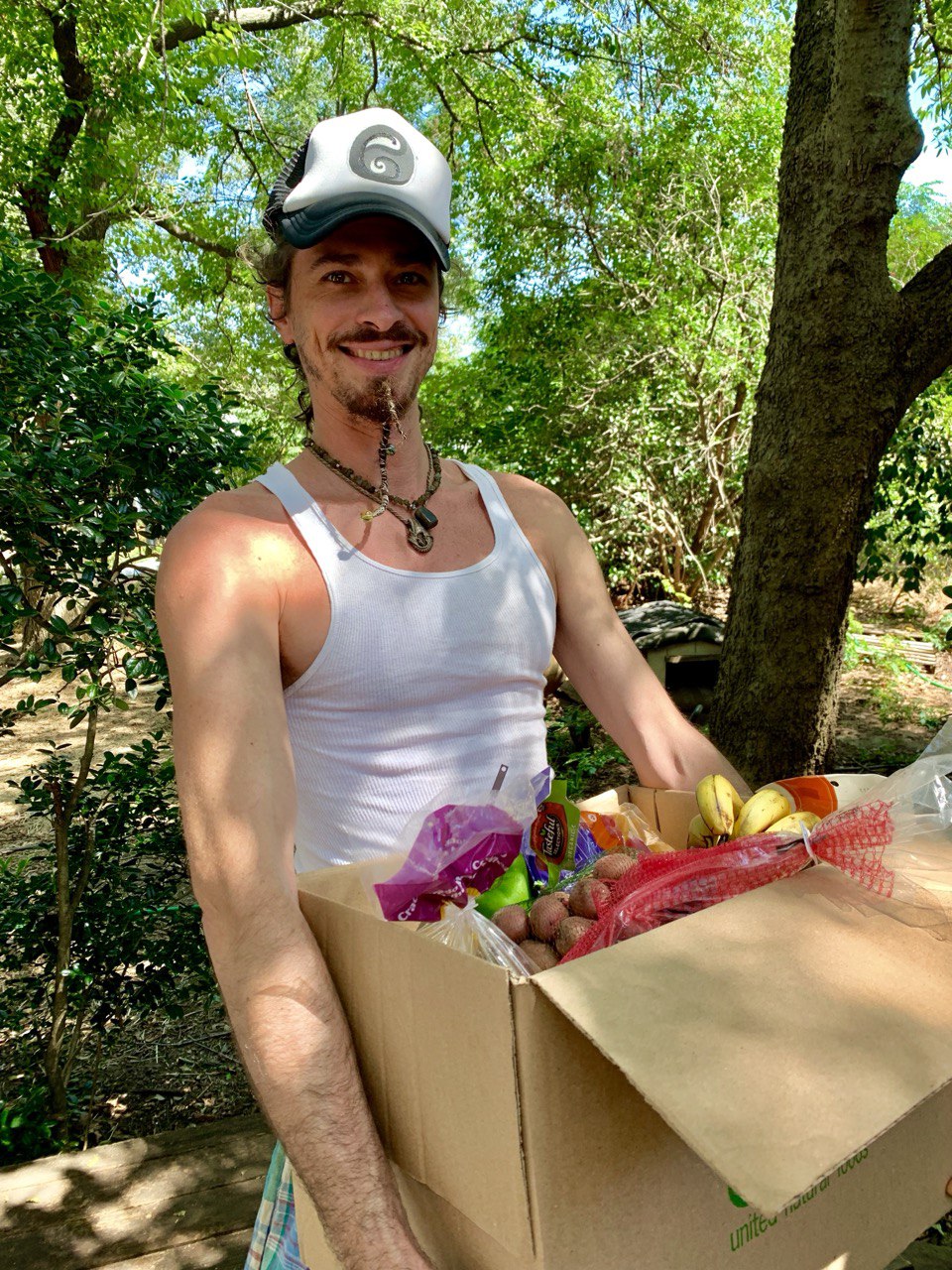

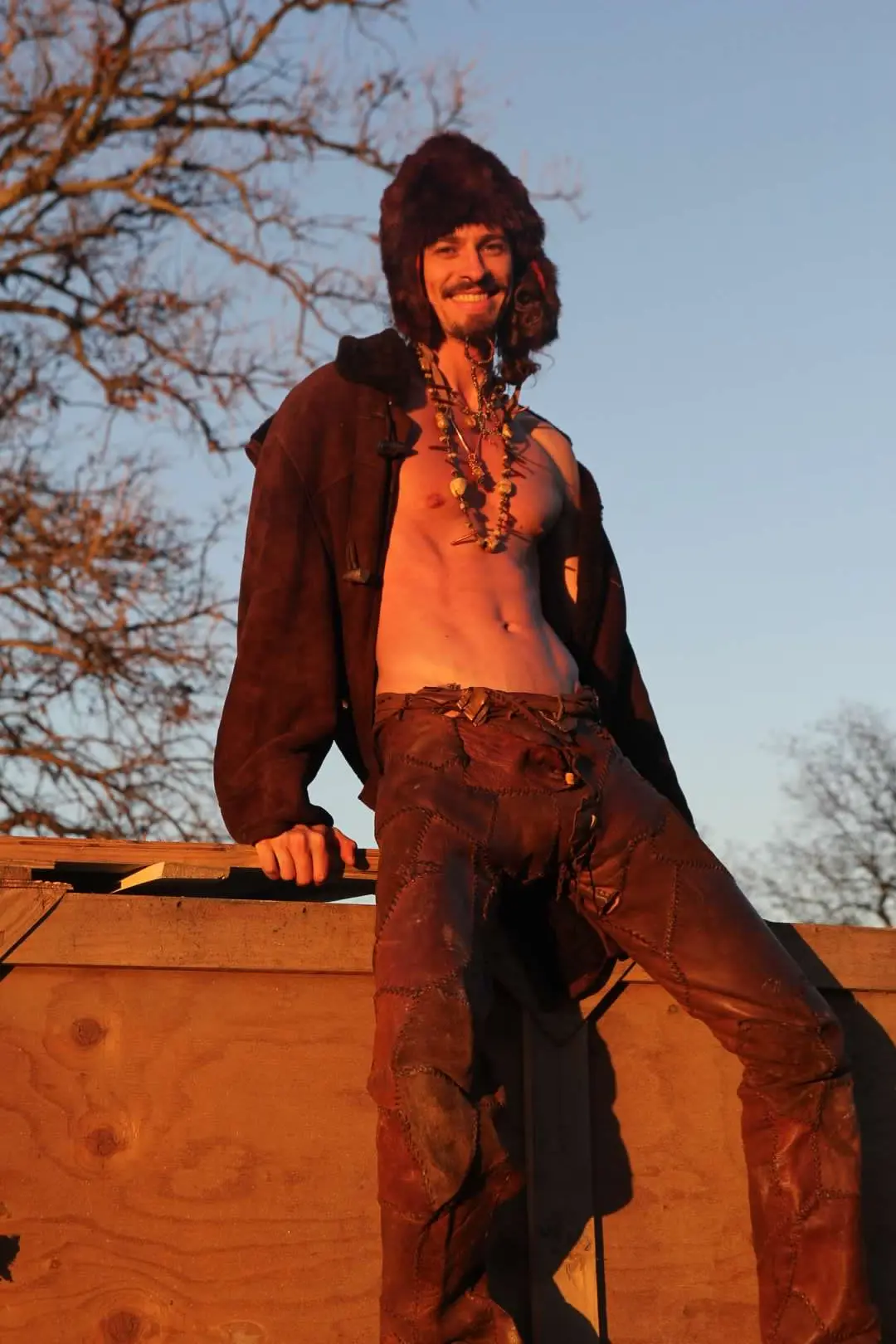

Shellie is a truly exceptional human being, an inspiration, and a leader by her example of how loving, caring, nurturing, courageous, strong, and beautiful a woman can be. Her feminine nature is ever soft and gracious, supportive, and playful.
She is vibrantly alive, seeming at times to have almost super human strength and stamina, especially considering her petite stature and sixty plus years of living in her current body! She regularly outpaces just about everyone else here, often the first to rise, the last to retire, and the most focused for the most time in between. She is likely the healthiest person of her age that you have ever met, and she does it all with no formula or rules, just tuning in to her own body and honoring her feelings. It is easy to see that her spirit is well too, as Shellie is ever delightful and gay, easy to incite to a game or a song as she works, and always ready to support anyone who asks from their heart.
Shellie is a truly exceptional human being, an inspiration and a leader by her example of how loving, caring, nurturing, courageous, strong, and beautiful a woman can be. Her feminine nature is ever soft and gracious, supportive and playful.
She is vibrantly alive, seeming at times to have almost super human strength and stamina, especially considering her petite stature and sixty plus years of living in her current body! She regularly outpaces just about everyone else here, often the first to rise, the last to retire, and the most focused for the most time in between. She is likely the healthiest person of her age that you have ever met, and she does it all with no formula or rules, just tuning in to her own body and honoring her feelings. It is easy to see that her spirit is well too, as Shellie is ever delightful and gay, easy to incite to a game or a song as she works, and always ready to support anyone who asks from their heart.
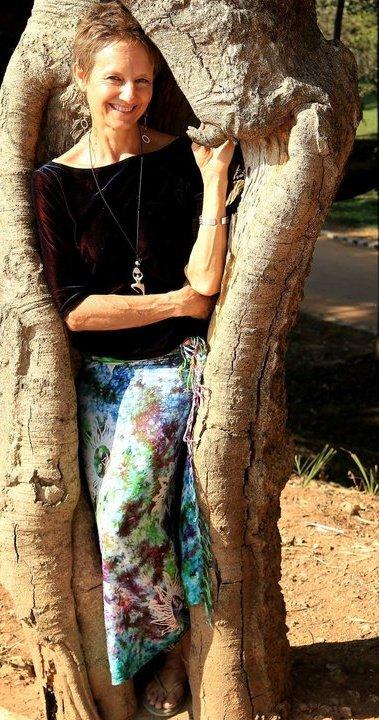
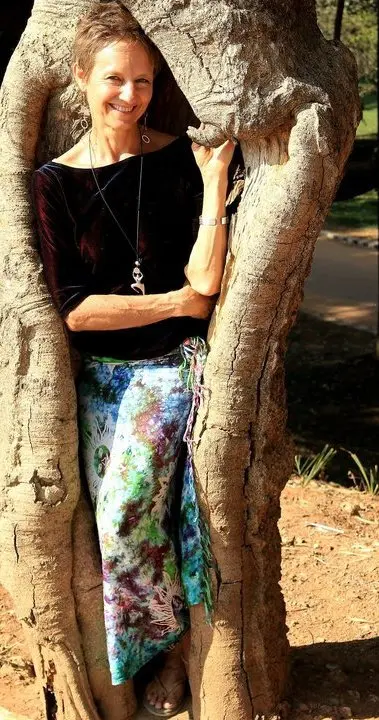
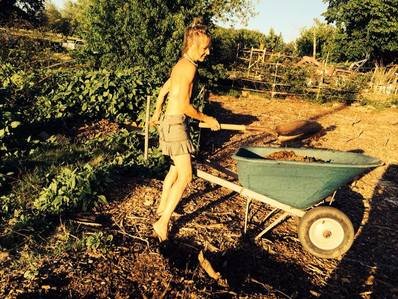

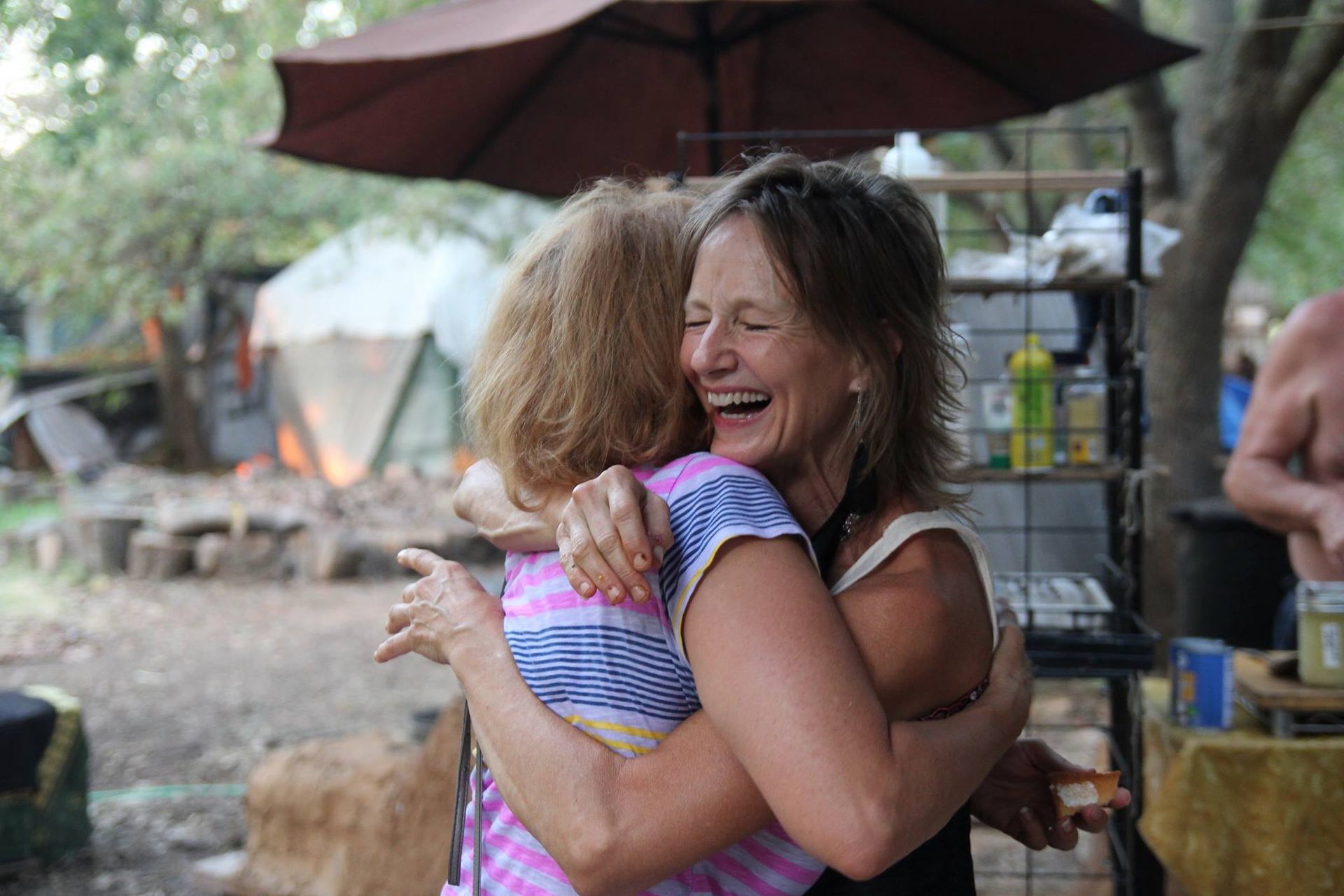

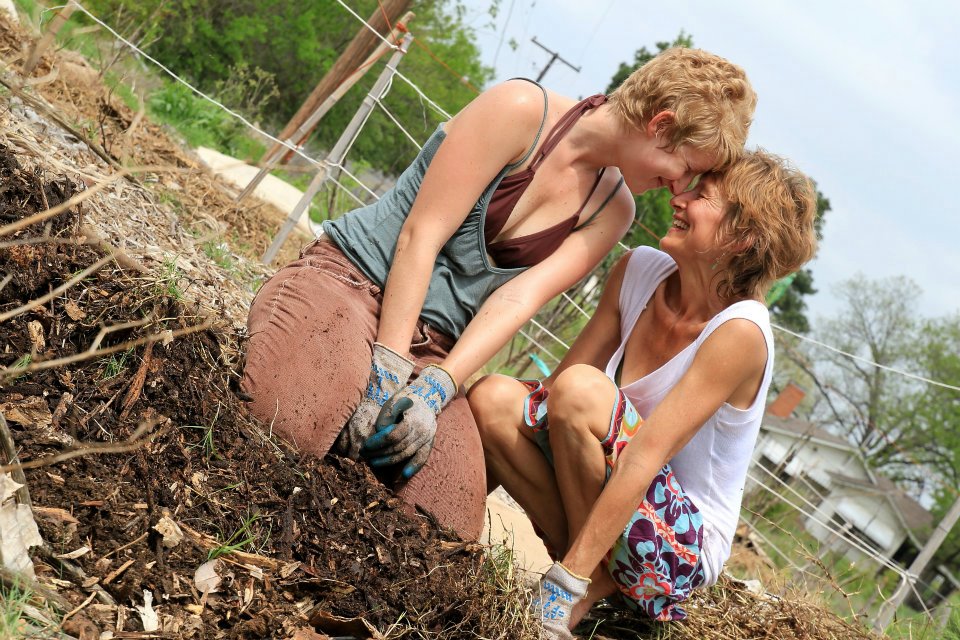
Shellie IS an artist, through and through. Viewing life through her artist's eye, every nook and cranny of reality offers an opportunity to recognize beauty, and potentially capture it on camera too. Her photographs are just a glimpse into the unique filter of beauty that she is able to apply to life, as she is a master of finding beauty in anything.
With her daily investment of energy and attention, Shellie is handcrafting her own paradise on earth, one masterpiece at a time. From the food she prepares, to the shed she organizes, to the henna art she draws on someone's body, everything Shellie makes is beautiful. Her magic is apparent all over The Garden of Eden, from the artistic trellises, to the grapevine covered outdoor shower, to the lovely way she styles herself.
A radiant beam of light and ever love, Shellie is easy to feel good around. Her very nature is naturally supportive and playful, making her an easy conversationalist and a great listener. And in truth, Shellie is always listening with her heart. As an intuitive and deeply soulful being, Shellie feels her feelings deeply and passionately, and her path is daily guided by her feelings.
A radiant beam of light and ever love, Shellie is easy to feel good around. Her very nature is naturally supportive and playful, making her an easy conversationalist and a great listener. And in truth, Shellie is always listening with her heart. As an intuitive and deeply soulful being, Shellie feels her feelings deeply and passionately, and her path is daily guided by her feelings.
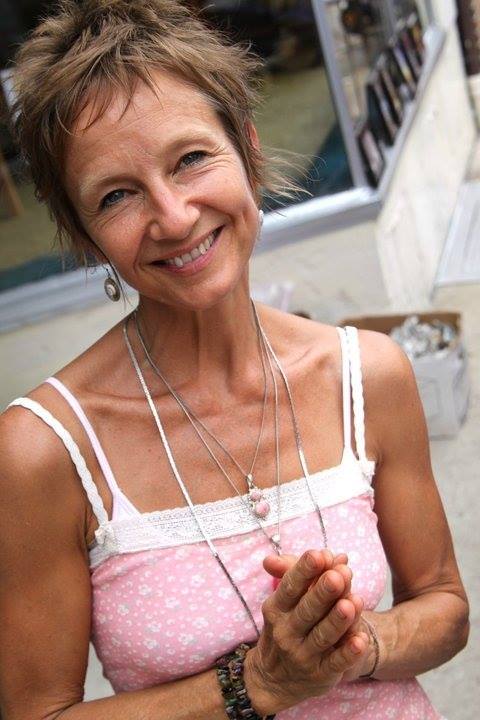

A Lion of a Lamb
Her courageousness of heart has allowed her to walk a road less traveled, as she has consistently chosen to do what she feels is the path of love, even against the grain of society's values and norms. Despite her traditional, structured upbringing, she chose to unschool her two children, with little support from family or mainstream culture. She also boldly donated her home and her land to be The Garden of Eden, inspired by the clarity and vibrance of Quinn's vision and his daily embodiment of values they both share. She has stood up to the City of Arlington in her rights to her property, and continues to battle for her freedom in the courts.
This tall glass of water is a delightful and quirky blend of urban funk and eastern bliss, with a dash of librarian (thanks to her mama).
Sara has a wide skill set, adept in photography, writing, and editing. She likes to get down to biznass and gets shit done fast - it often seems like magic that she has already accomplished her task and moved on to the next one before others are halfway through the first.
Sara is a fun and grounded teacher of yoga, as well as a Reiki master. She is also an artist of freestyle poetry flow, able to come up with enlightening and witty rhymes off the cuff, with a special skill for cussing with style.
She has an easy yet focused nature and a great sense of humor. Her work on our newsletters and blogs are evident of her comical abilities, and often have the Eden Knights rolling in tears when reviewing her drafts.
Her hobbies include money makin', money money makin', super disco disco breakin', and carrying Shellie on her shoulders.
This tall glass of water is a delightful and quirky blend of urban funk and eastern bliss, with a dash of librarian (thanks to her mama).
Sara has a wide skill set, adept in photography, writing, and editing. She likes to get down to biznass and gets shit done fast - it often seems like magic that she has already accomplished her task and moved on to the next one before others are halfway through the first.
Sara is a fun and grounded teacher of yoga, as well as a Reiki master. She is also an artist of freestyle poetry flow, able to come up with enlightening and witty rhymes off the cuff, with a special skill for cussing with style.
She has an easy yet focused nature and a great sense of humor. Her work on our newsletters and blogs are evident of her comical abilities, and often have the Eden Knights rolling in tears when reviewing her drafts.
Her hobbies include money makin', money money makin', super disco disco breakin', and carrying Shellie on her shoulders.
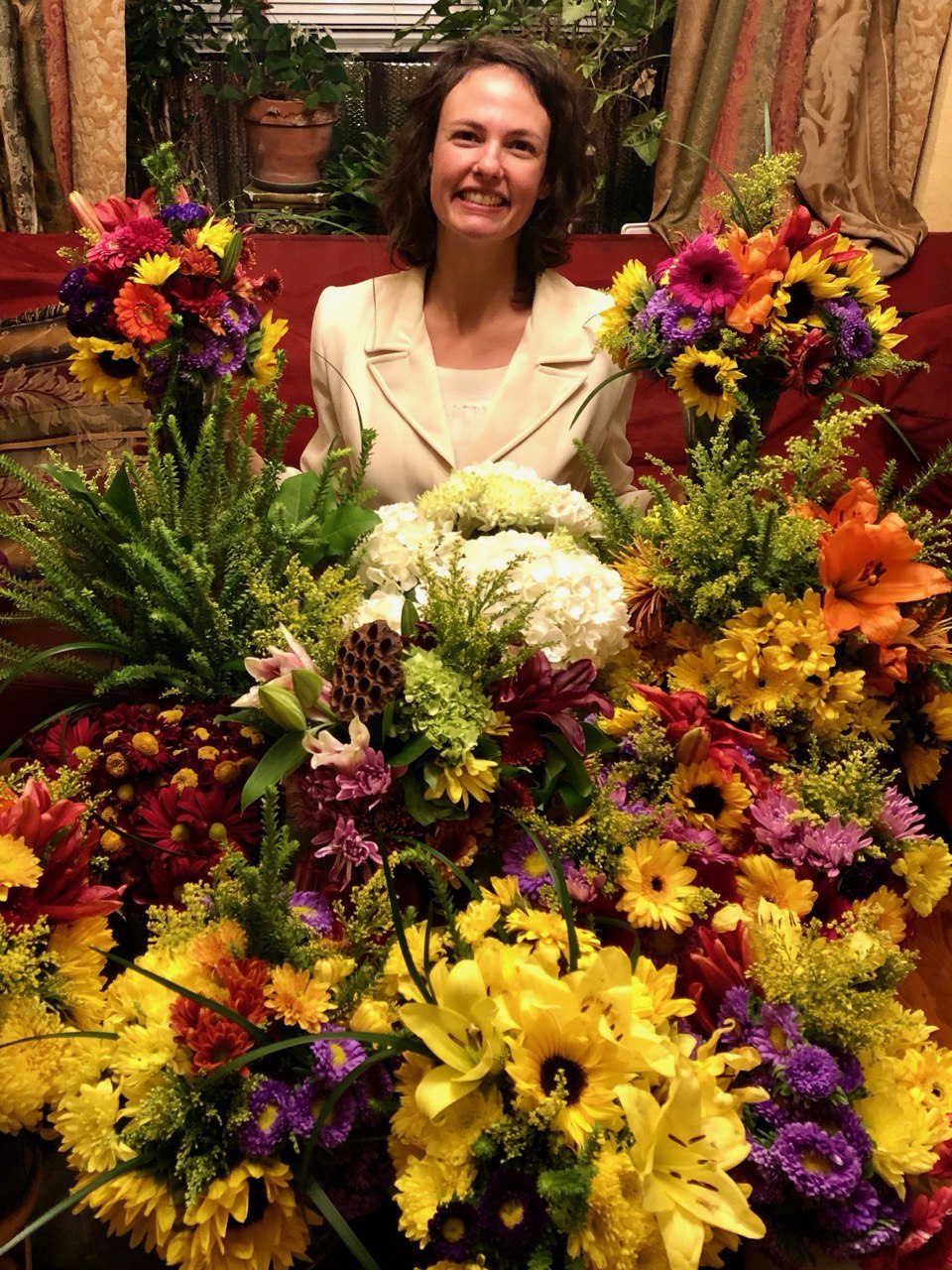

While the individuals named above make up the steady beating heart of The Garden of Eden, we also have an extended "family" that is ever growing, changing, and evolving!
The collective dynamic of the community is influenced by each individual who is present, and is therefore constantly shifting and changing as people come, go, and evolve while here.
We have participants who come through on their journeys for various lengths of time, staying from a few hours to a few days to a few months or even years, all contributing their own unique gifts and abilities to our cause while learning about our way of life.
We also have many locally-based friends and neighbors who come to participate in life with us here on a regular basis, dear friends and family who are interested, inspired, and in love with The Garden of Eden.
While the individuals named above make up the steady beating heart of The Garden of Eden, we also have an extended "family" that is ever growing, changing, and evolving!
The collective dynamic of the community is influenced by each individual who is present, and is therefore constantly shifting and changing as people come, go, and evolve while here.
We have participants who come through on their journeys for various lengths of time, staying from a few hours to a few days to a few months or even years, all contributing their own unique gifts and abilities to our cause while learning about our way of life.
We also have many locally-based friends and neighbors who come to participate in life with us here on a regular basis, dear friends and family who are interested, inspired, and in love with The Garden of Eden.
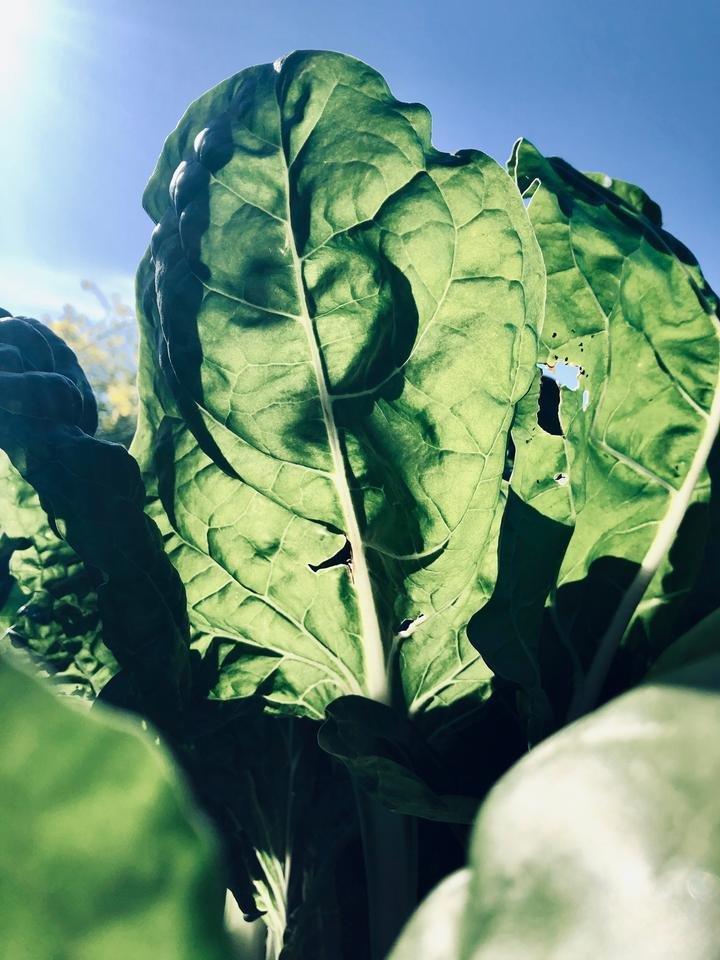
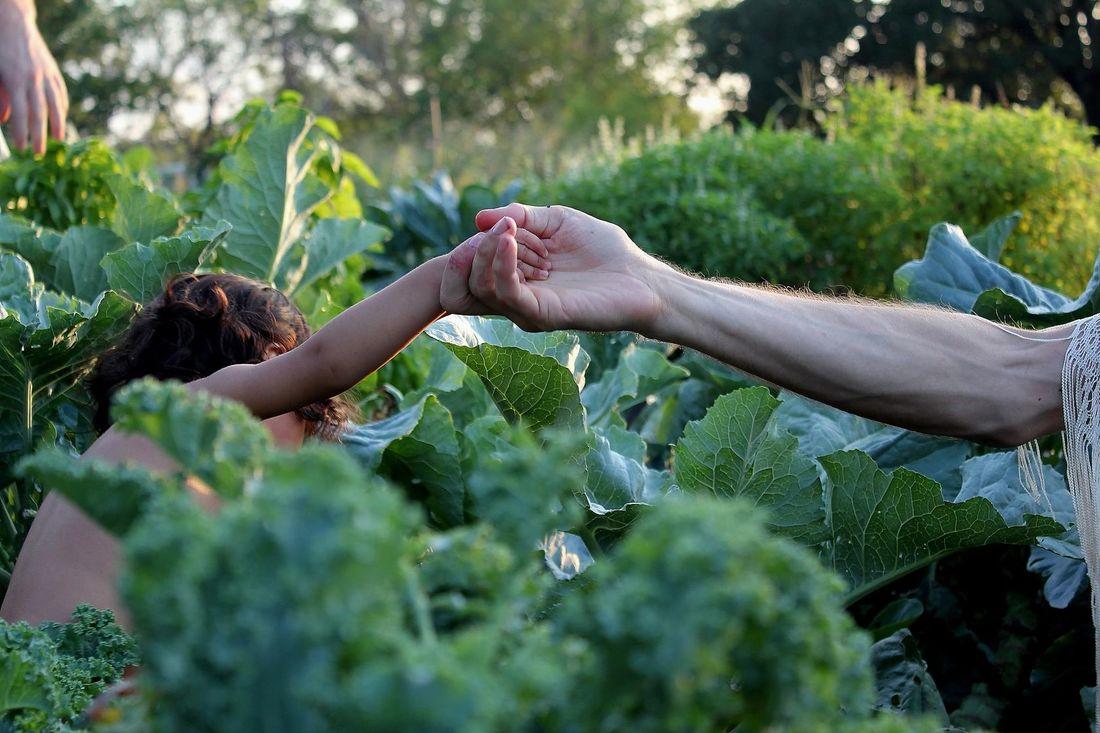
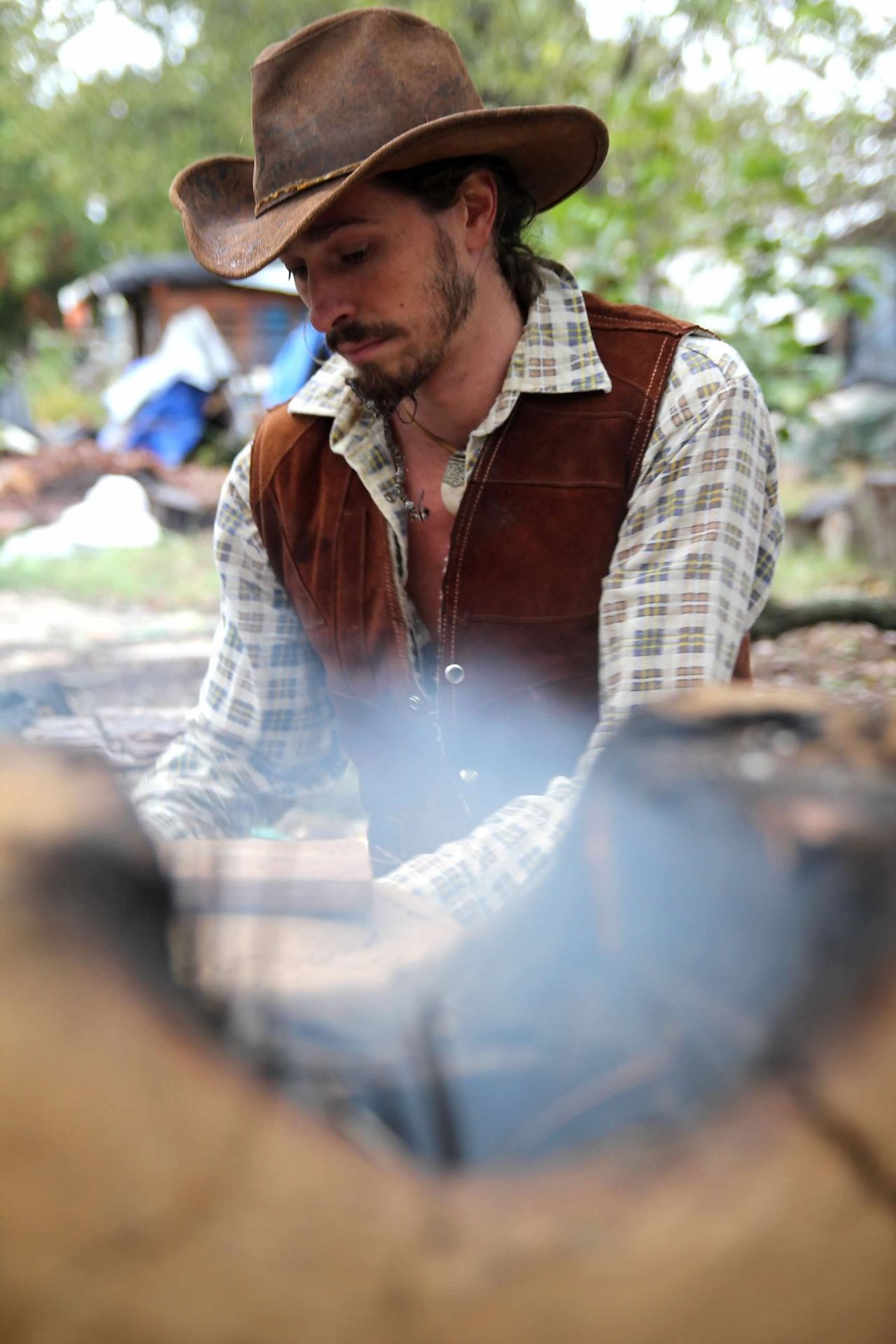
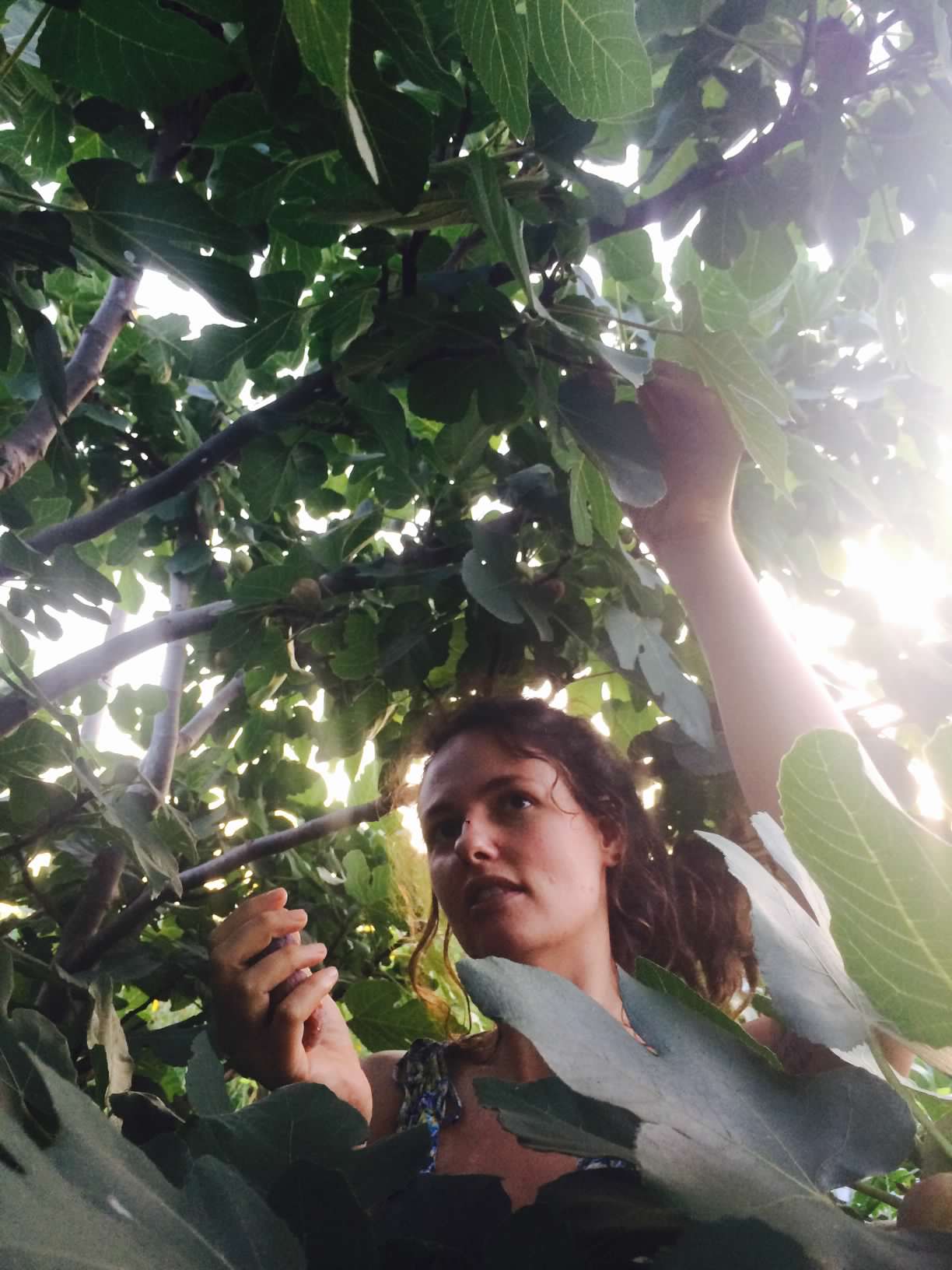
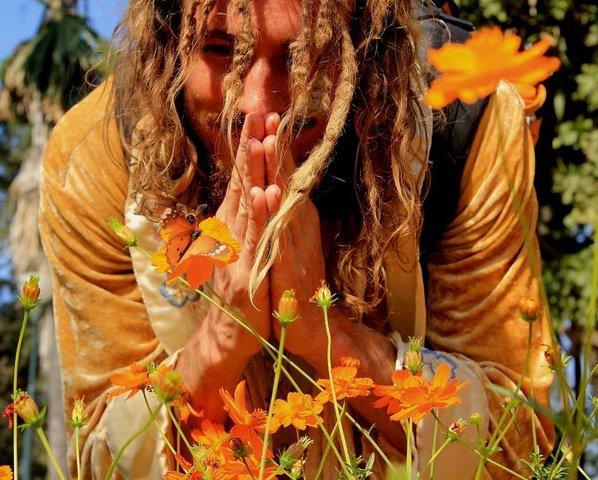
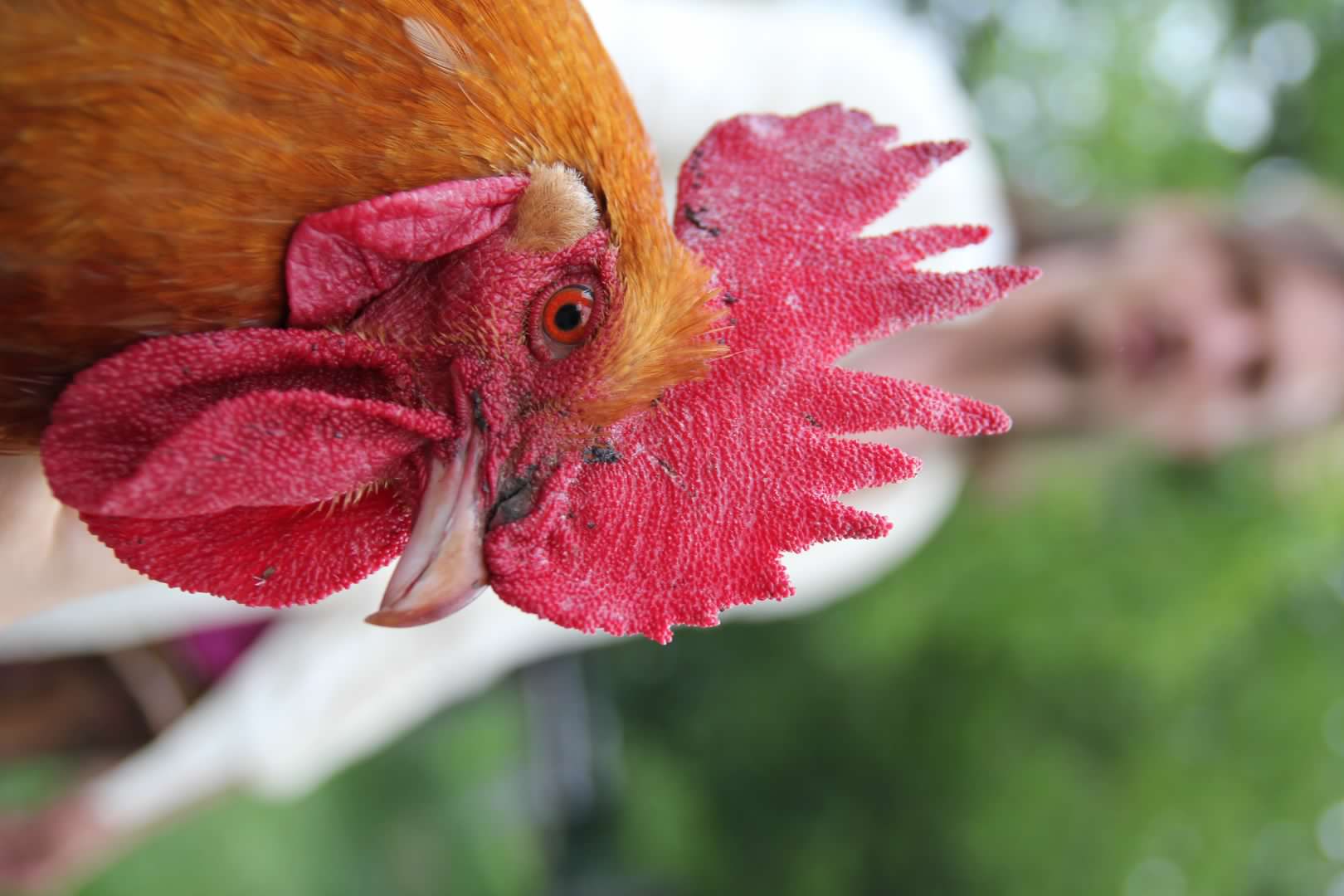
∾⊱⩫ Our Purpose⩫⊰∾
∾⊱⩫ Our Purpose⩫⊰∾
We share our living example of a thriving sustainable community, because when others see it, they KNOW that it is possible!
The Garden of Eden in Arlington, Texas, is the first of what we hope will be a tidal wave of sustainable eco-villages to spring up all around the world, providing sustainable solutions for food production, housing, commerce, and community to many joyful and grateful people.
Here, we are creating an evolving model for sustainable, responsible, enjoyable living that encompasses all the necessities of life - and many of the niceties too!
Based on this model, The Garden of Eden can be recreated and adapted for the many different environments and cultures that exist all around the world.
The widespread and global rise of sustainable eco-villages has the potential to usher in an entirely new paradigm of living, where humans are THRIVING in harmony with nature and one another.
Yet this reality shall exist only when we as INDIVIDUALS, en masse, are ready and willing to take full responsibility for aligning with such a reality at the depths of our very being.
That means truly loving ourselves, truly loving our planet, and truly loving one another.
From that place of true love, all decisions made will be made for the benefit of all.
We have all heard of the carbon footprint - a metric of how much carbon is added to the atmosphere as a result of a person's consumption.
We are proud to declare that The Garden of Eden has a negative carbon footprint and an overall positive environmental impact!
Quinn has traveled the world, visiting every continent but Antarctica, and seen a myriad of lifestyles and environments along the way.
Yet even the indigenous people living on the land in their traditional ways are not having as much of a positive impact on the environment as is The Garden of Eden! People living on the land may "break even" with the Earth, giving back everything they take, in a way that can be processed and recycled by the ecosystem.
Yet because the GOE is removing waste and utilizing trash to produce usable resources that support life, our environmental impact is actually better than zero.
Unlike almost all organizations or organisms that we have ever heard of, The GOE has the net effect of actually ADDING LIFE SUPPORT to the Earth's system as a whole.
For example, each year, The Garden of Eden gives away tens of thousands of meals for FREE!
These meals are given to homeless and hungry people within our own local community and further expansive metroplex outreach throughout the year.
We give groceries and meals to single mothers and their children, and take food to the local firemen on a regular basis.
These meals also feed our own inhabitants and volunteers who are daily applying their life and energy to sustainable living. These meals are also shared with those who attend GOE events, the vast majority of which also include free, all you can eat feasts!
Unlike almost all organizations or organisms that we have ever heard of, The GOE has the net effect of actually ADDING LIFE SUPPORT to the Earth's system as a whole.
For example, each year, The Garden of Eden gives away tens of thousands of meals for FREE!
These meals are given to homeless and hungry people within our own local community and further expansive metroplex outreach throughout the year.
We give groceries and meals to single mothers and their children, and take food to the local firemen on a regular basis.
These meals also feed our own inhabitants and volunteers who are daily applying their life and energy to sustainable living. These meals are also shared with those who attend GOE events, the vast majority of which also include free, all you can eat feasts!
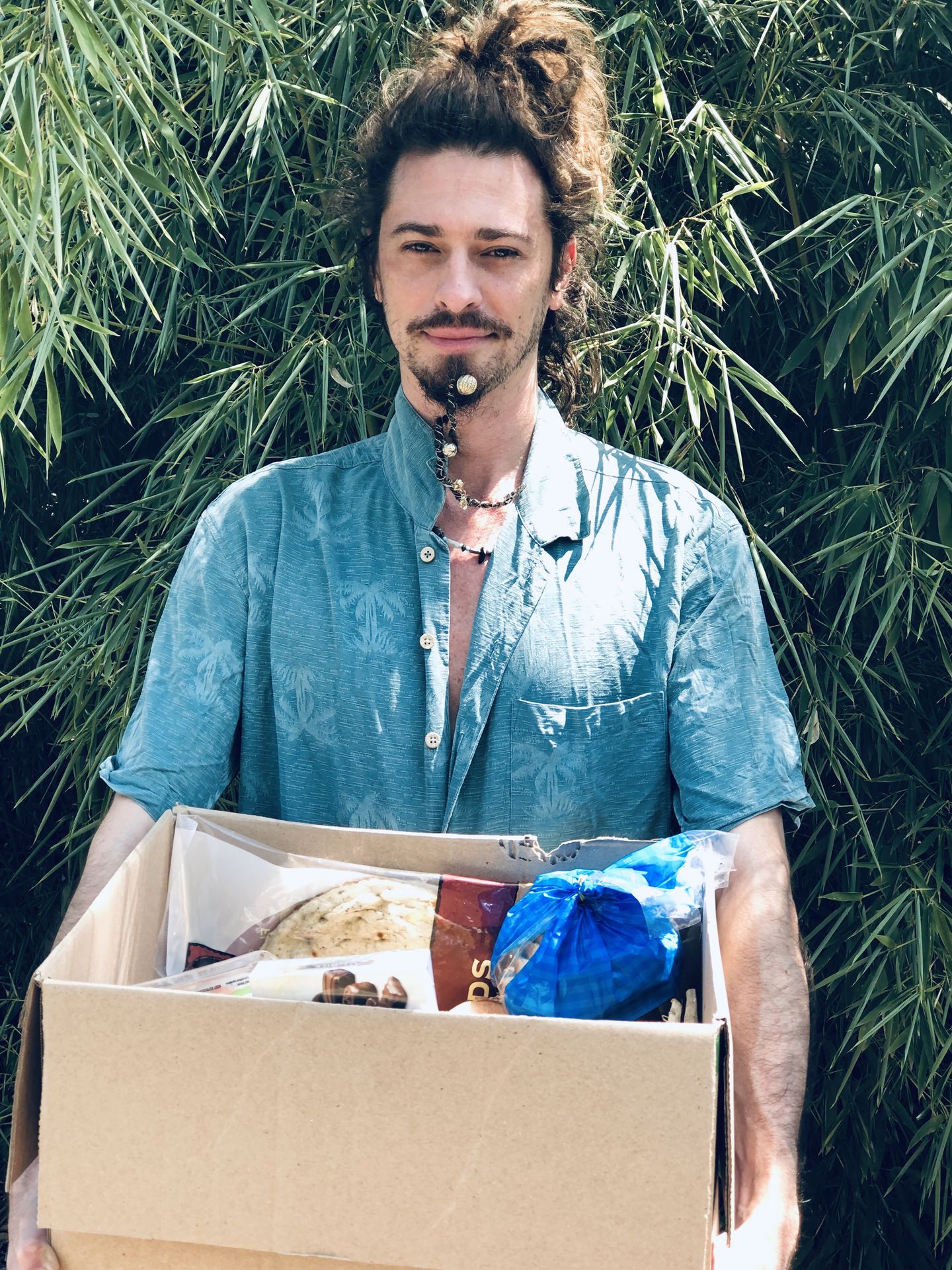

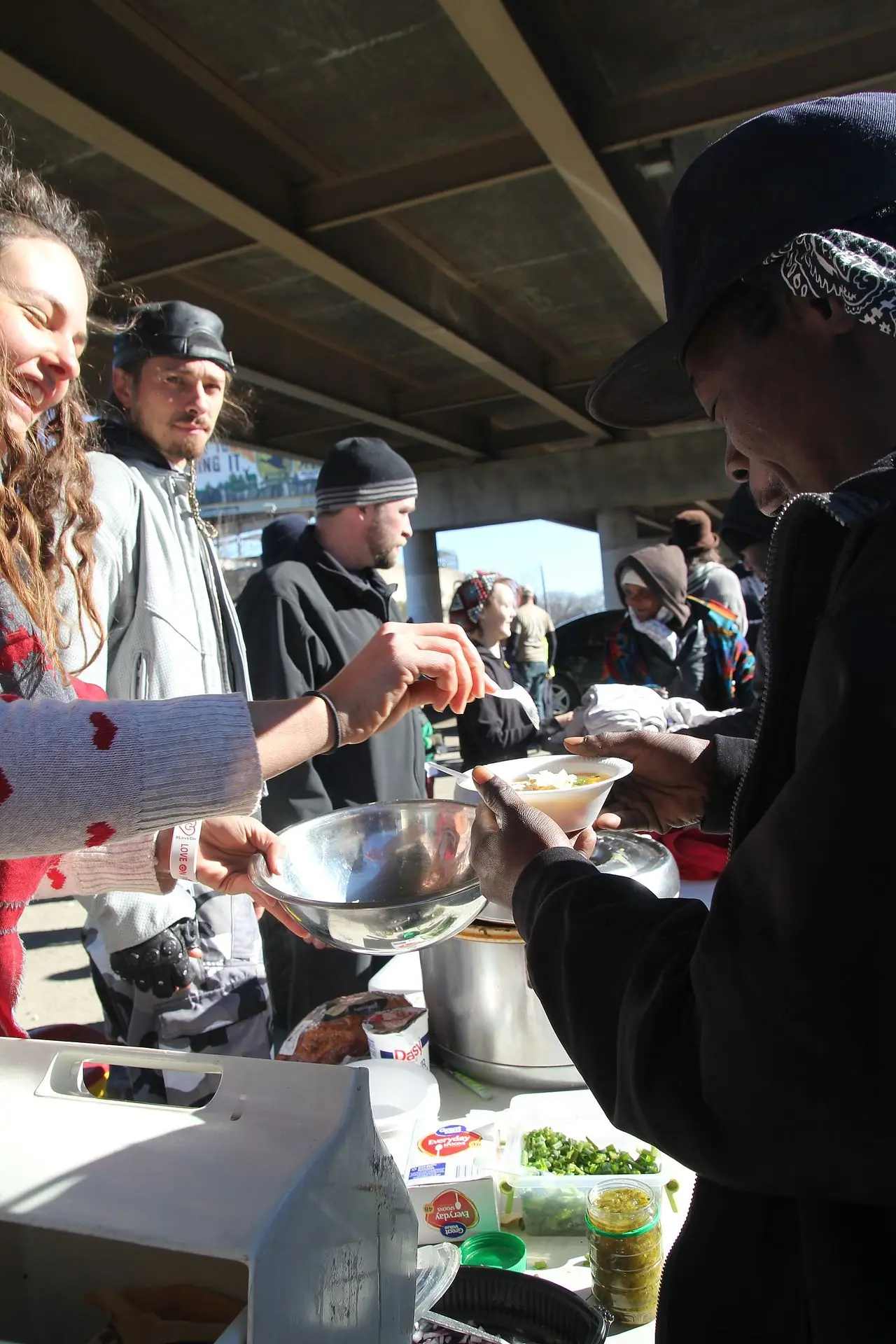
Ultimately, the most sustainable practice is to simplify. The bottom line is that we just use way less!
We use much less water, electricity, natural gas, and ALL resources than a typical American household. Rather, we have found alternate methods of achieving the necessary functions of having a healthy body, functional house, and a happy life.
We use less gas to fuel our cars because we are not running all over town every day. We use baking soda to wash our hair and many things needing washing, vinegar to wash the windows and floors, newspaper or phone book paper to wipe after we go or greasy spills, the fresh air to dry our clothes, the sun to dehydrate our food and heat our water - the list goes on and on!
We wash our clothes, bodies, dishes, etc. using the minimum amount of soap and water needed to get the clean. We wash our clothes and bodies only when they actually need it, rather than habitually washing "just because", for stress relief, or out of routine.
We keep separate sets of clothes for getting dirty during tasks like gardening outside, and for keeping clean such as when we have dinner together at night. We wear our clean clothes only inside the house, and this reduces the amount of house cleaning and laundry that is necessary.
Many, many little adjustments like this add up to create a big difference in the amount of resources we use as a community. This not only saves money and environmental damage, but it also saves us the energy of having to do all that extra washing. It also makes us stronger, healthier, and tougher too!
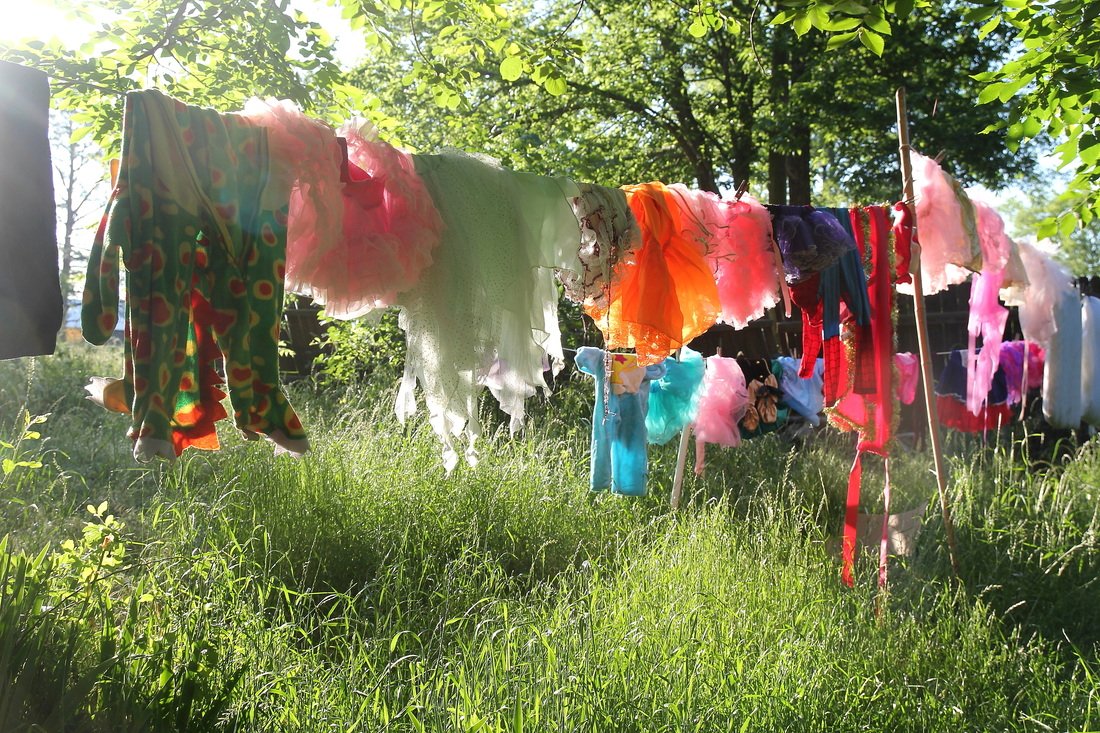

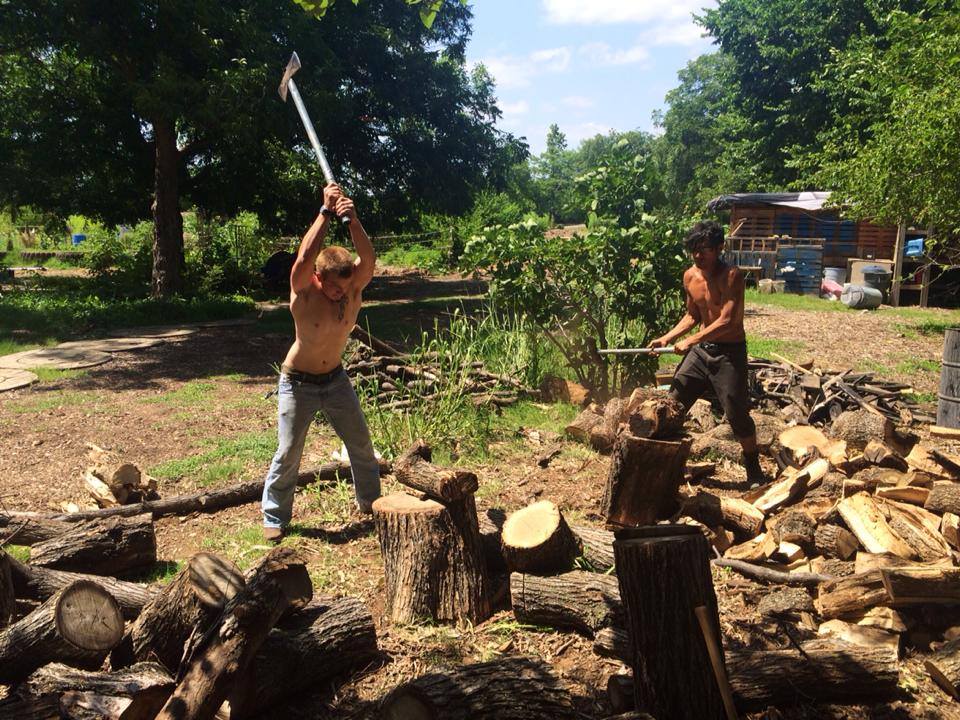

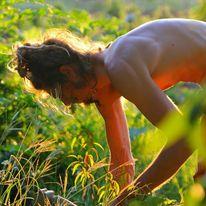
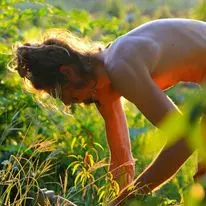
Sustainable Habits
We use alternative solutions that utilize free and/or renewable resources to do everyday things.
For example, rather than using an electric or gas burning stove, we do our cooking using forsaken wood that would otherwise be in the trash. In warm weather, we use our outdoor kitchen with the cob rocket stoves and cob oven. In cold weather, we use the heat of the wood burning stove that heats our living area, which would be burning scrap wood whether we were cooking or not. We also heat all our water for showers and cleaning simultaneously with heating the house and cooking food. This makes it an extra-efficient use of the wood, and a great alternative to gas or electricity.
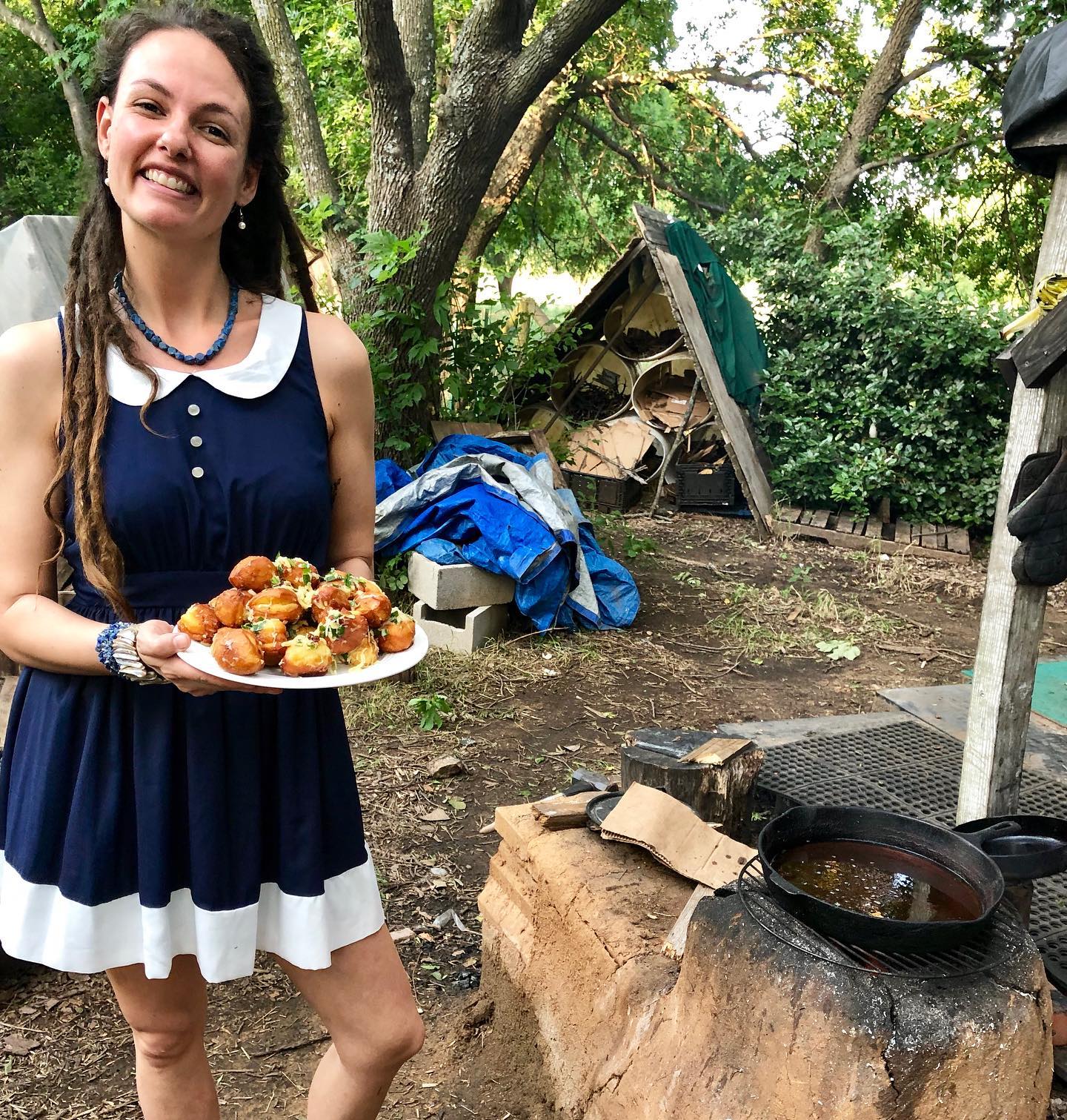

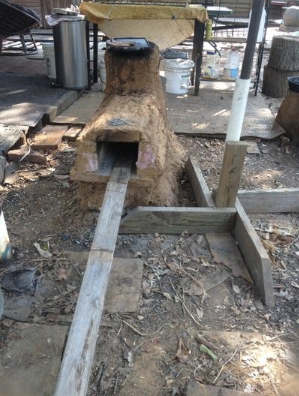

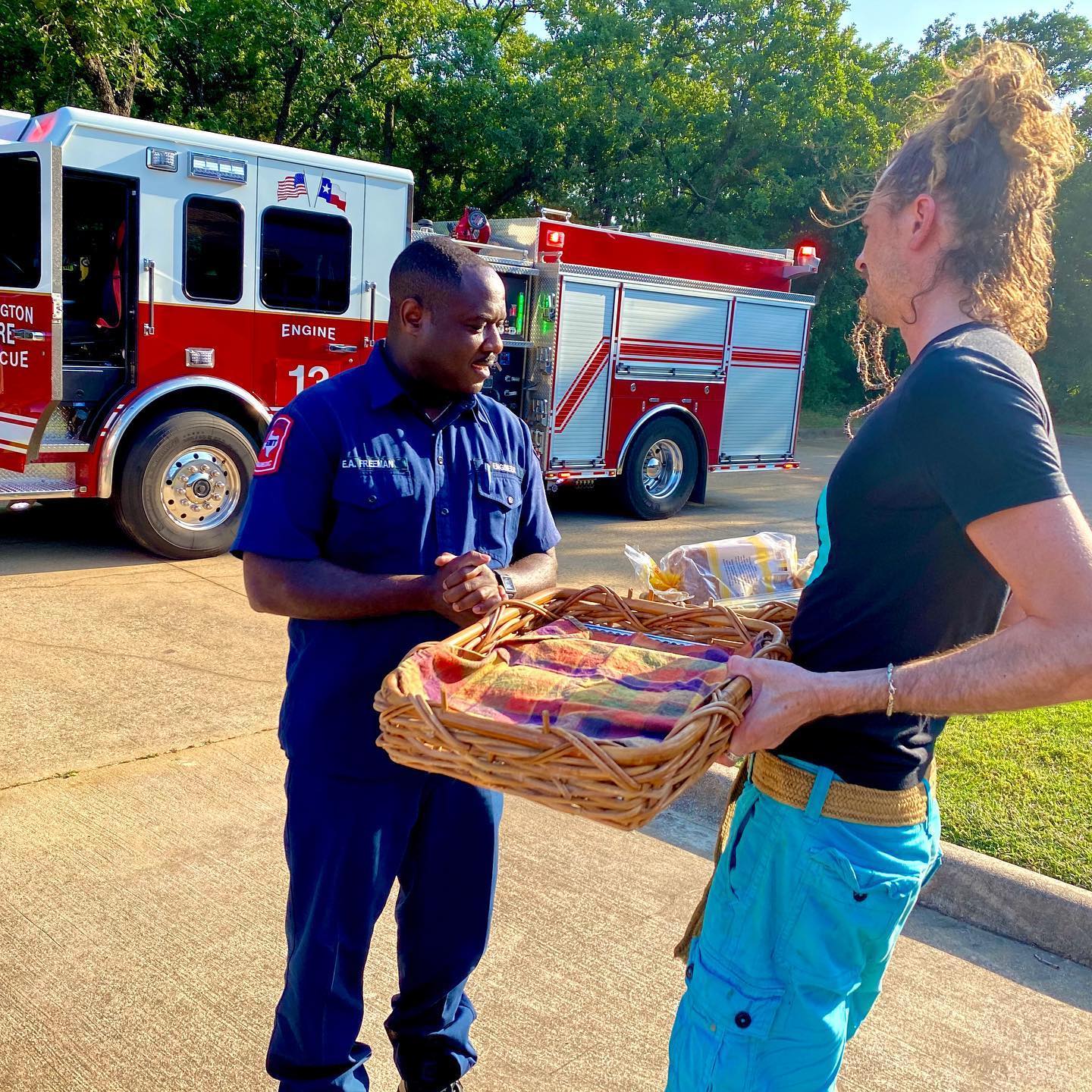

We take beautiful and refreshing outdoor showers that uses water supplied from our well in the summers. In winter, we shower indoors in water heated by the wood-burning stove that also heats our common room.
We make a joke that if we did follow a religion, it would be to turn off the lights! Since sustainability is important to us it is a natural part of the flow of our day to be conscious of what electricity we are using, and if we leave the room, we turn off the lights or fan or computer or whatever is not going to be used while we are out. If no one needs a light to see something important, they are off. We mostly use sunlight to illuminate our rooms through open blinds and portable solar lights to brighten spaces at night, which we consciously set outside to charge up in the day time.
We purchase just about NOTHING from stores - no purchase means no financial support for their unsustainable ways. If there is something we just absolutely can't get around having for some technology or construction project, we will trade for it or we get it donated through our non-profit.
We make one with the elements. We do not rely on conventional heating or air conditioning to regulate our environments. If it is chilly, we wear more clothes. If it is sweltering, we wear much less, and douse our hot bodies in a 55 degree well shower if and when we get too hot.
We are conservative and purposeful about our travel; if we do go out in an automobile, it is for a purpose that serves our greater purpose of living and sharing sustainability. We don't go out cruising to clear our heads, or just to get away, or to put the children asleep. If we do go out, it is with the purpose of making the world a more sustainable and life-supporting place such as facilitating a festival, conference, or catering an event with WAY more delicious and sustainable food than that which is available anywhere else, or feeding the homeless or firemen. When we choose to make a trip to a festival or a market, we are doing so with the purpose of spreading awareness, sharing perspective, and changing people's lives for the better. And even then, we do so in the most efficient and sustainable way we know how. The minimal amount of pollution created by the vehicle is counter-balanced by the good we do for the world - like picking up a donation worth thousands of dollars of food to share with people in need, or salvaging forsaken materials from the landfill cycle.
We consolidate tasks on our trips out, and we get as many things done in one trip as possible, choosing locations that are as close as possible to achieve our purpose in going out. We always pick up something that enriches the GOE vortex when out. If running to the bank or the post office, at very least, the driver also stops by somewhere to pick up some cardboard or sawdust that would have otherwise been trash. Those are then used in our garden and composting toilets, respectively, and then become compost which becomes soil which becomes food. We aim that no one ever comes back empty handed!
We grow lots of our own food! Our irrigations system does not rely on water processed, supplied, or polluted by a municipality; we pay only for the electricity to pump the water up through our well. We use NO processed or commercial fertilizers, only our own rich and nutritious compost.
We compost everything organic - paper, cardboard, food, pee, and poo. It all becomes soil and then enriches our land, which enriches our food, which enriches our bodies, which we use to further the cause of living and sharing sustainability.
Trash to Treasure
New Paradigm sustainability means using whatever is abundantly available and renewable.
Because we live in a busy metroplex that is constantly generating waste, "trash" is our most abundant resource, and unfortunately it is essentially renewing itself. Fortunately, The Garden of Eden alchemizes that trash into treasure in many forms.
We take the many, MANY usable resources that were headed to the landfill (where they would sit and unfortunately not decompose for hundreds of years), and we put that trash to sustainable use benefiting thousands.
We salvage a vast amount of resources from the trash - literally TONS! Every year, the GOE saves hundreds of thousands of pounds of forsaken matter that would otherwise pile up in a toxic landfill. We do this either by getting it before it is thrown away or even sometimes right after. A quick peek behind the dumpster gate or into a pile of stuff on the curb has proven a worthwhile gander many a time for the Eden Knights.
We have tree trimming companies that dump whole truck loads of wood chips on our land (rather than pay to dump at the landfill!), and landscaping companies that dump whole truck loads of leaves or other organic matter. We use these redeemed materials to increase the health of our garden.
We have a dear friend who owns a fencing company; any time he tears down a fence, he would normally have to pay to unload the wood panels at the dump. Instead, he donates the used fence panels to us, and we then use them to build structures or burn them as fuel in our rocket stoves thereby alchemizing waste into free meals! We even have people who save their trash and bring it to us instead of throwing it away.
Discarded pallets are used to build structures and create vertical gardens. Coffee grounds and forsaken food is given to animals or composted, thereby creating Earth rather than polluting it. Other materials are re-imagined and repurposed from their usually limited "original intent" - and since they are no longer serving their original purpose when that "one and only" use is used up, they are discarded and thrown out as worthless. Do you understand that this is a limitation on human imagination and ingenuity, and keeps people enslaved to the endless cycle of consumerism and destruction?!
The "problem" is in consciousness, so the solution lies there too. Truly there is more than enough of everything! THAT is the new paradigm!
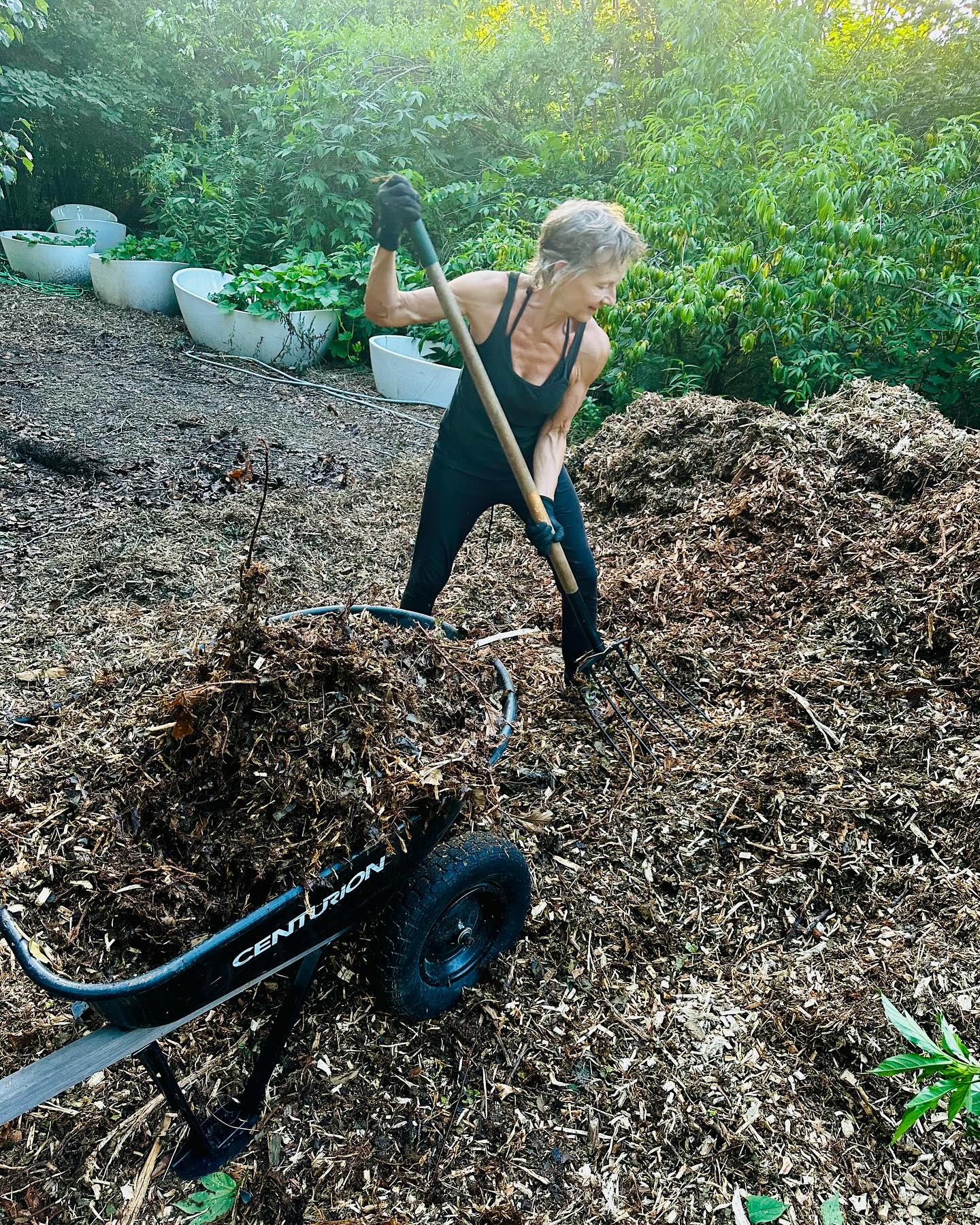

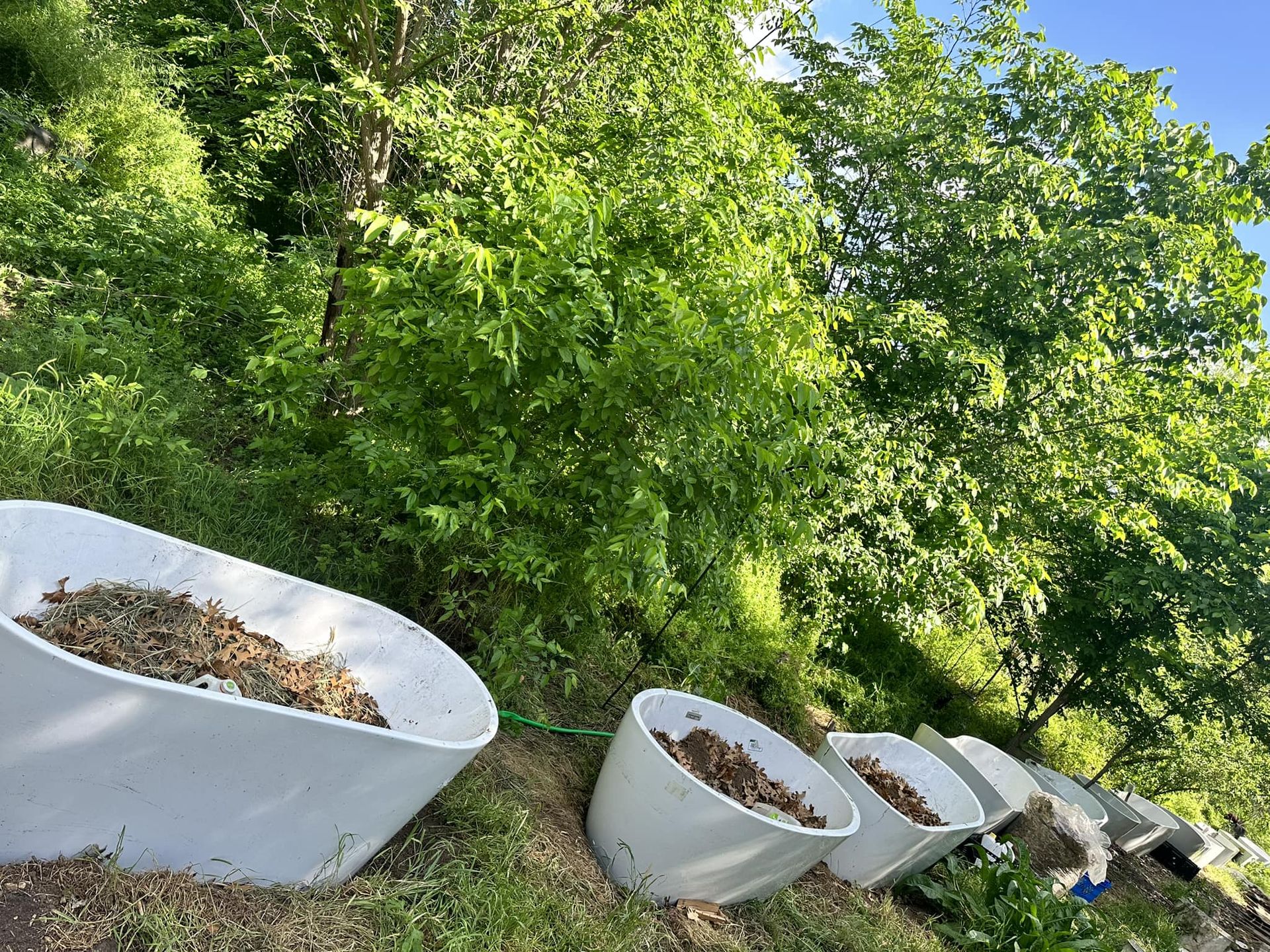

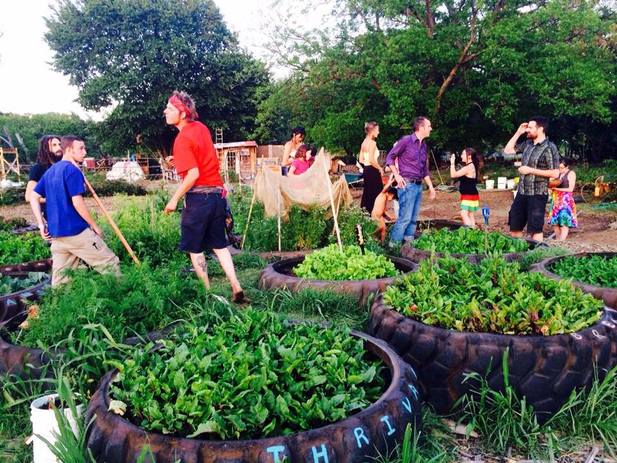


Ripples of Sustainability
As a community, we are living in such a way that we have a positive environmental impact, and we are also inspiring thousands of people each year to make changes in their lives that reduce their negative environmental impact as well!
Tens of thousands of people across our social media platforms tune in daily to the shifts that we have made within ourselves and in our daily lives that make us more sustainable and responsible.
We have attended many festivals where we are connecting with hundreds or thousands of others who are interested in our way of life and searching for the means and methods to make beneficial impressions on our living planet. The connections and impressions we make at those large public events often have a truly profound impact on the people we touch, who are forever changed and enlightened by their experience with us.
After the SWAT Raid of 2013, hundreds of online, TV, and print articles and videos were published about us, reaching literally hundreds of thousands of people, all of whom became aware that we exist as a beyond organic farm and sustainable community.
We received waves of letters and e-mails from people all over the world telling us how they were both inspired by our way of life and by the way we handled the City of Arlington's demands with peaceful non-compliance.
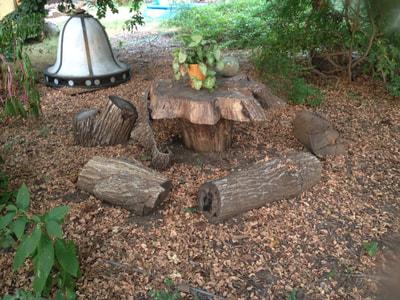
Sustainability everywhere!
Everywhere you look around the GOE grounds, sustainability is apparent.
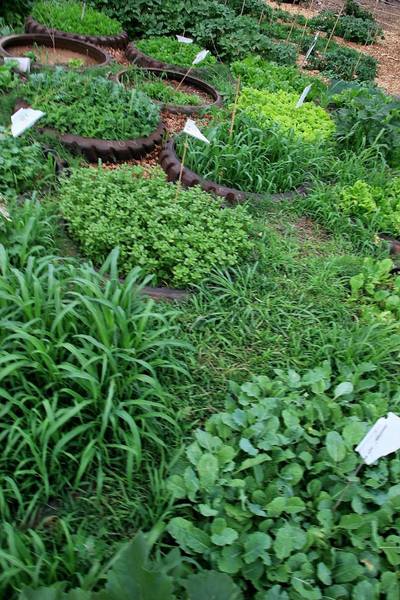
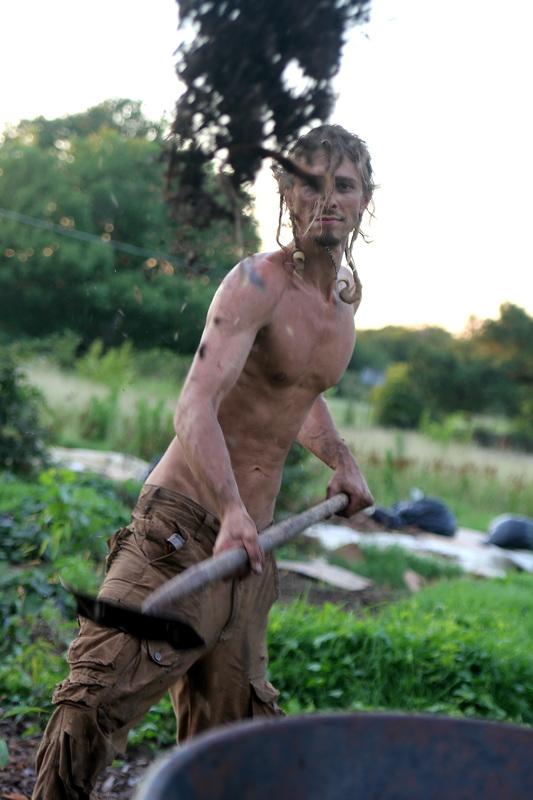
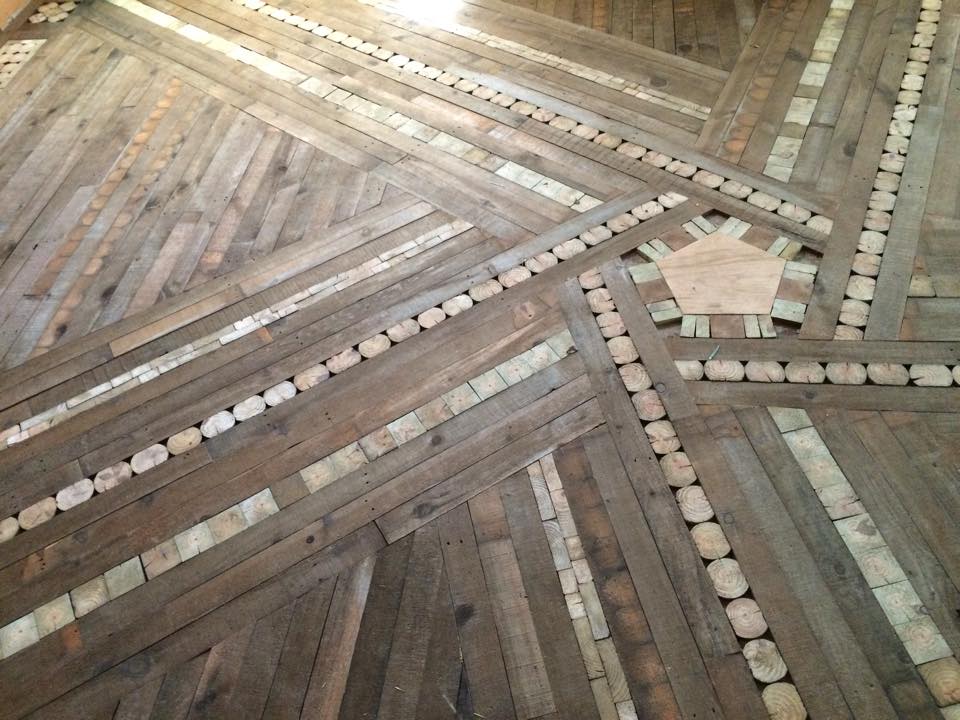
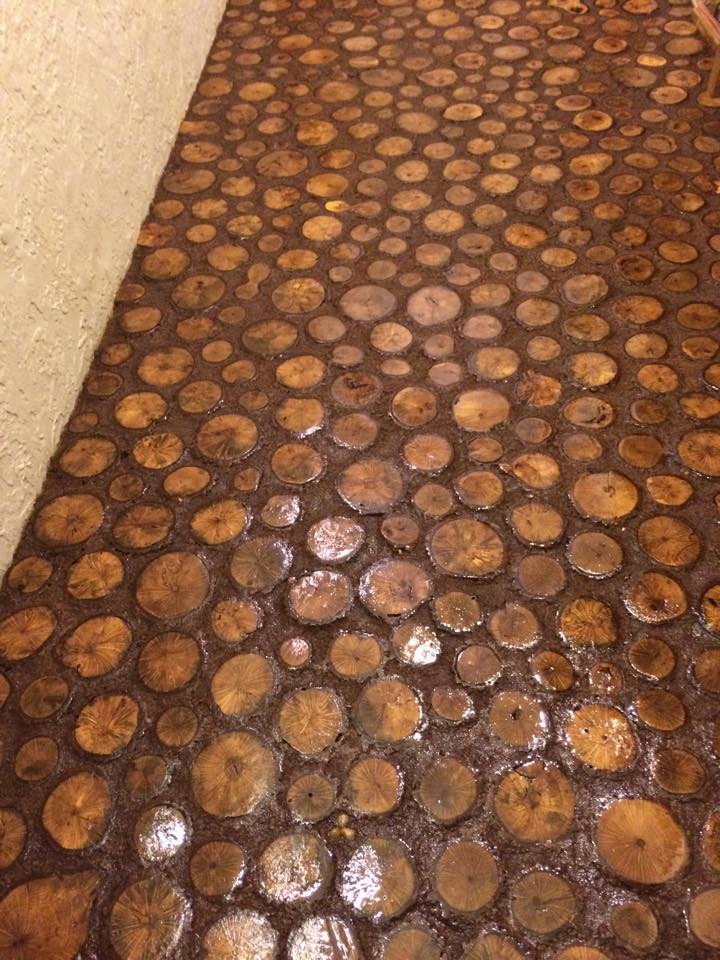
The Isness of Business
Today’s money-centered, consumer culture can make it difficult to see just how easy and abundant life really is. Here in The Garden of Eden, we prove that it is easy to make a living by providing and sourcing essentials for yourself and also by trading services and goods for money to use in trade throughout the world. This can be done in an enjoyable, fulfilling, and abundant way without having to sacrifice or compromise what is important to you!
Today’s money-centered, consumer culture can make it difficult to see just how easy and abundant life really is. Here in The Garden of Eden, we prove that it is easy to make a living by providing and sourcing essentials for yourself and also by trading services and goods for money to use in trade throughout the world. This can be done in an enjoyable, fulfilling, and abundant way without having to sacrifice or compromise what is important to you!
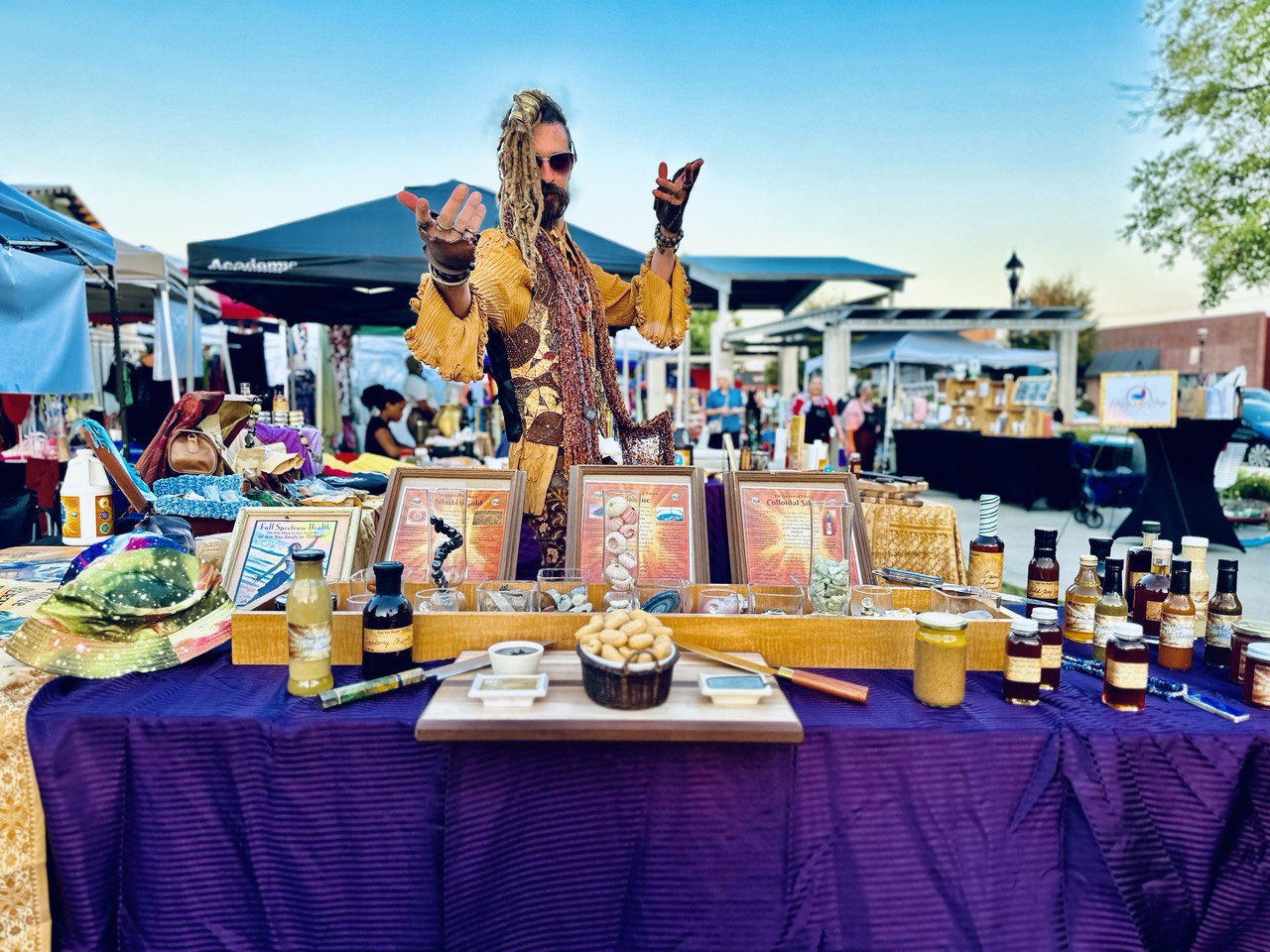

There is more than enough of everything, and when one is truly connected and inspired, it is easy to make something out of virtually nothing. We are masters of alchemizing “trash” into treasure. We want to show you how easy and enjoyable this is for us, and to help you find a similar groove based on your own personality, preferences, passion, and purpose.
We are not a business (we are a private club), nor do we sell items in a commercial capacity. We simply trade valuable services and resources of great health and beauty and because it is easy and convenient for many they simply donate money as the contributory trade, while others instead trade their own goods or services. What is important is that a valuable exchange is taking place between all involved. The more valuable the good or service, the more valuable the good or service of trade must be. Some people have more assets or more highly valued skills than others, but EVERYONE has something to share - and with honorable diligence, there are plenty of the essentials for everyone.
We are now engaged in a wide variety of enterprises that reflect our own true inspirations and personal passions, offering a wide range of goods and services. Each of our outlets is a natural extension of who we are and requires no “work” at all, since we are all doing the things we love to do and would do anyway, regardless of financial exchange! However, that does not mean that money cannot factor in as the added benefit of receiving compensation for our gifts, which then provides flexibility in procuring other goods and services.
We are now engaged in a wide variety of enterprises that reflect our own true inspirations and personal passions, offering a wide range of goods and services. Each of our outlets is a natural extension of who we are and requires no “work” at all, since we are all doing the things we love to do and would do anyway, regardless of financial exchange! However, that does not mean that money cannot factor in as the added benefit of receiving compensation for our gifts, which then provides flexibility in procuring other goods and services.
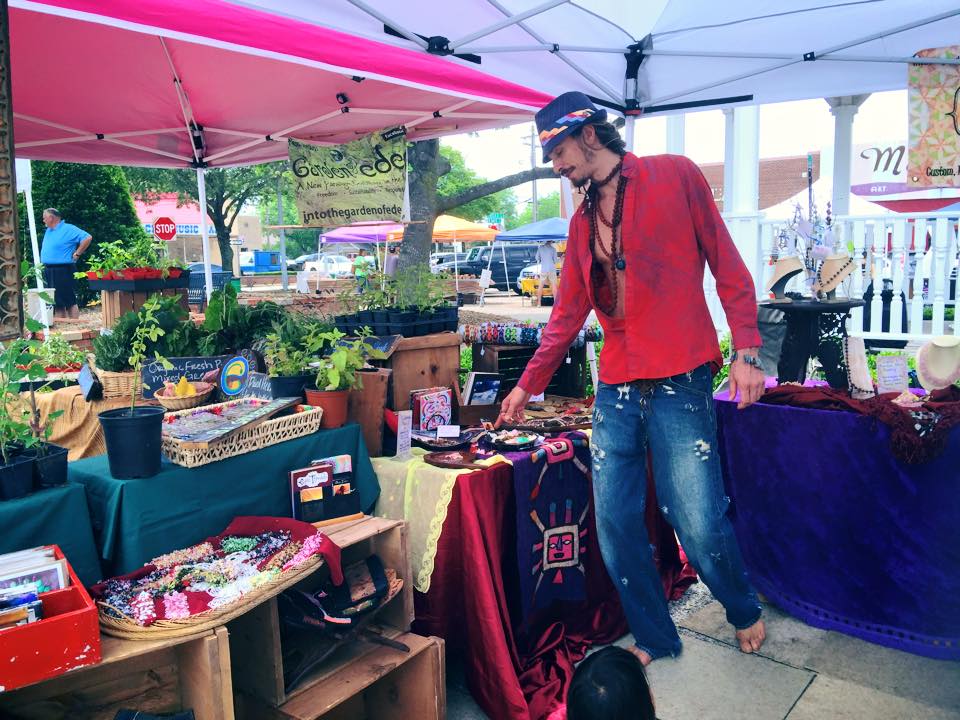

All proceeds in the forms of money, goods, services, and time/energy that is given to The Garden of Eden through donation or other exchange goes directly to support our outreach programs, the creation of sustainable communities capable of feeding and housing people for free for the rest of their lives, and sharing new paradigm possibilities!
Life CAN be easy, abundant, and enjoyable! Living in conscious connection with self, with life-force Source energy and in tune with nature/life itself, life can be lived sustainably and joyfully. We share how!
Because of Quinn's consciousness of sustainability, those who live and thrive at The Garden of Eden are doing so with the use of a minimal amount of financial resources.
The vast majority of the monetary resources that come through here can therefore be invested in sustainable realities that have the potential to serve and support people for a lifetime.
Quinn is deeply committed to his values and purpose. Freedom and sustainability are top priorities in every decision he makes, and these are reflected in the standards and operations of The Garden of Eden.
In general, all resources received or generated through any project that Quinn is a part of are invested in new paradigm realities such as eco-villages, sustainable food production, feeding the hungry, and the sharing of the new paradigm perspective.
He is a master alchemist of material resources, turning "shit to gold". And yet rather than turning "shit" to actual gold - which you can't eat , drink, or live in! - Quinn takes resources that may seem like mere trash or worthless dirt and, through his conscious alchemy, transforms those base resources into exponentially expanding realities that provide real support for life!
Every dollar that Quinn or the GOE receives is invested in something that creates more usable life-supporting resources, thus demonstrating the New Paradigm principle of natural abundance.
We invite you to invest your resources consciously, responsibly, and generously!Thank YOU for supporting sustainable free living!
Shop Goods
Feed the People
As mentioned, we use a great deal of our abundance to Feed the People. There's more than enough of everything, and we are happy to share! Our Feed the People program takes many forms:
We have a long-standing offer that anyone can contact us and we will provide a free box of groceries to them or someone they know - no questions asked. There are no qualifications or requirements to do so, no income level criteria, no particular religion one must followed, etc. You simply have to let us know that you need or want food, or know someone who does, and we will share what we have at the time!
We provide food for single mothers on a regular basis, because that is a most important job that should not have any additional stress of wondering where your children's next meal will come from. We are very grateful to share, to lift that strain so a mother can be more present with her children, and to provide nourishment for children to be healthy and happy and free!
We organize events in which we hand out food to homeless populations in the metroplex area. We do this not only because these are people in need when in reality there is plenty to go around, but also to bring awareness to the fact that it is actually "unlawful" in parts of this country to hand someone a sandwich without complying with a bunch of regulations, permits, and taxes - whereas for the cost of a single fighter jet, this country could take care of the whole homeless population for an entire year! It's a matter of priorities, values, and consciousness.
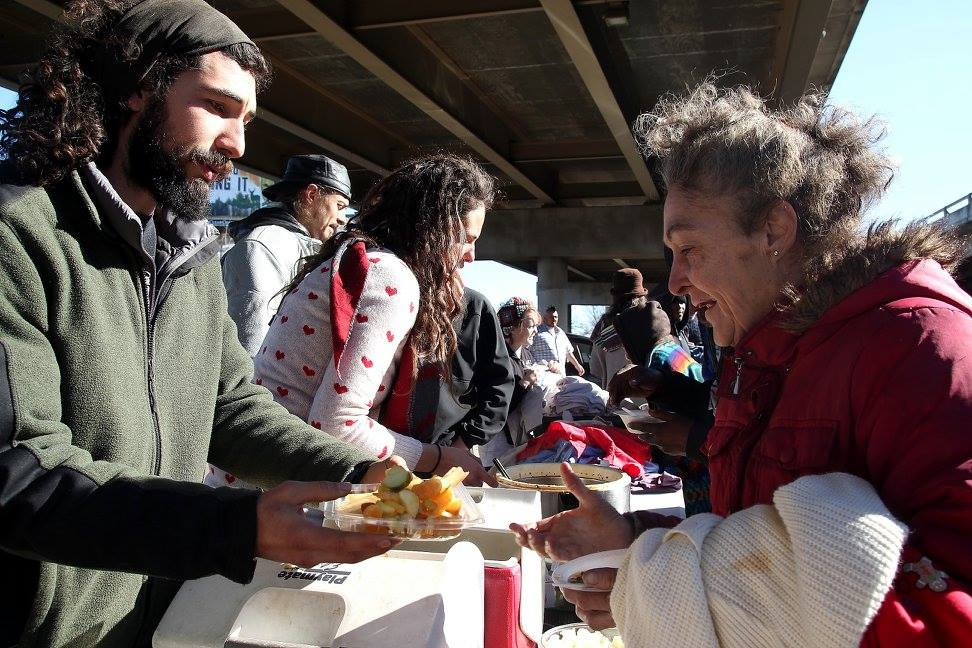
We organize events in which we hand out food to homeless populations in the metroplex area. We do this not only because these are people in need when in reality there is plenty to go around, but also to bring awareness to the fact that it is actually "unlawful" in parts of this country to hand someone a sandwich without complying with a bunch of regulations, permits, and taxes - whereas for the cost of a single fighter jet, this country could take care of the whole homeless population for an entire year! It's a matter of priorities, values, and consciousness.

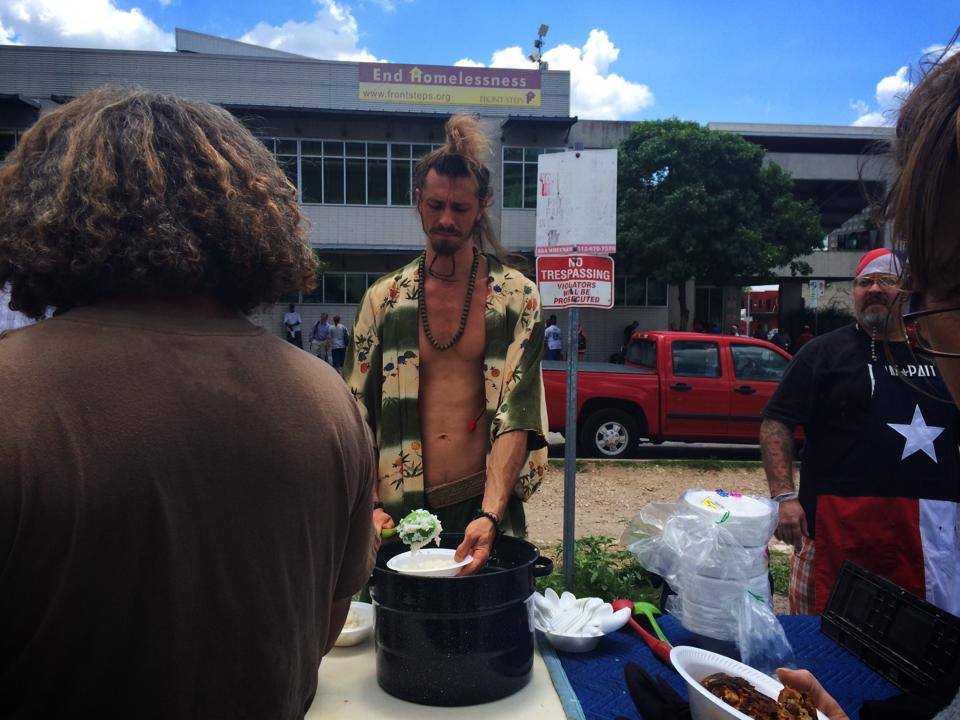

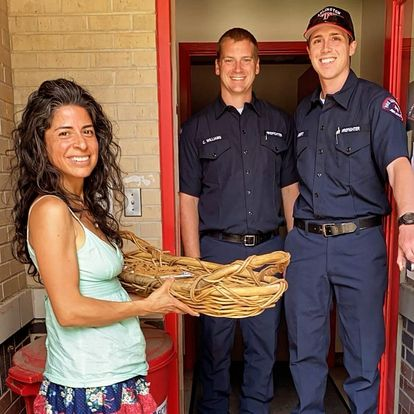

We also graciously take food to the firemen, as they are true heroes and pillars of the extended community. Whether we are making them a homemade dinner or gifting them a set of our hot sauces, we aim to stop by a fire station with a basket of homemade goodies in thanks for their service every time we go out.
We also graciously take food to the firemen, as they are true heroes and pillars of the extended community. Whether we are making them a homemade dinner or gifting them a set of our hot sauces, we aim to stop by a fire station with a basket of homemade goodies in thanks for their service every time we go out.
Animal Rescue
We care about ALL life, not just humans. We do our best to support our fellow man as well as the Earth, plants, and animals.
We regularly rescue stray, abandoned, and forsaken dogs and cats, and find new homes for dozens of such creatures each year. We have the space for them to be safe, but it takes a lot of resources and manpower to provide for so many!
Whether you want to adopt a dog or cat, help us rehome them, or provide support through other means, your support of our animal outreach program is greatly appreciated - by us and by them!
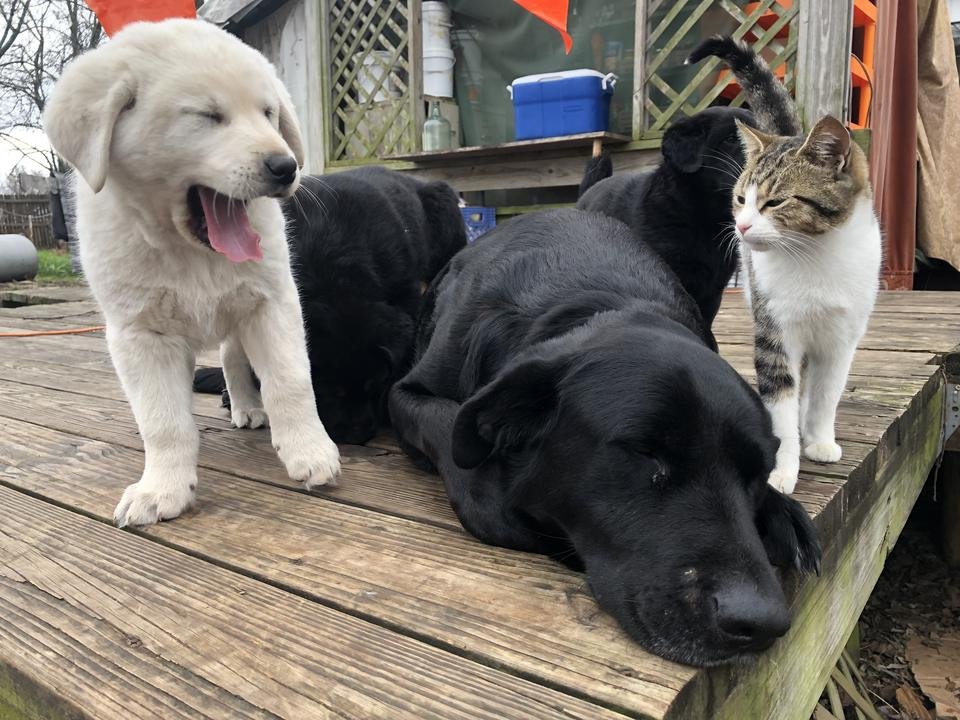
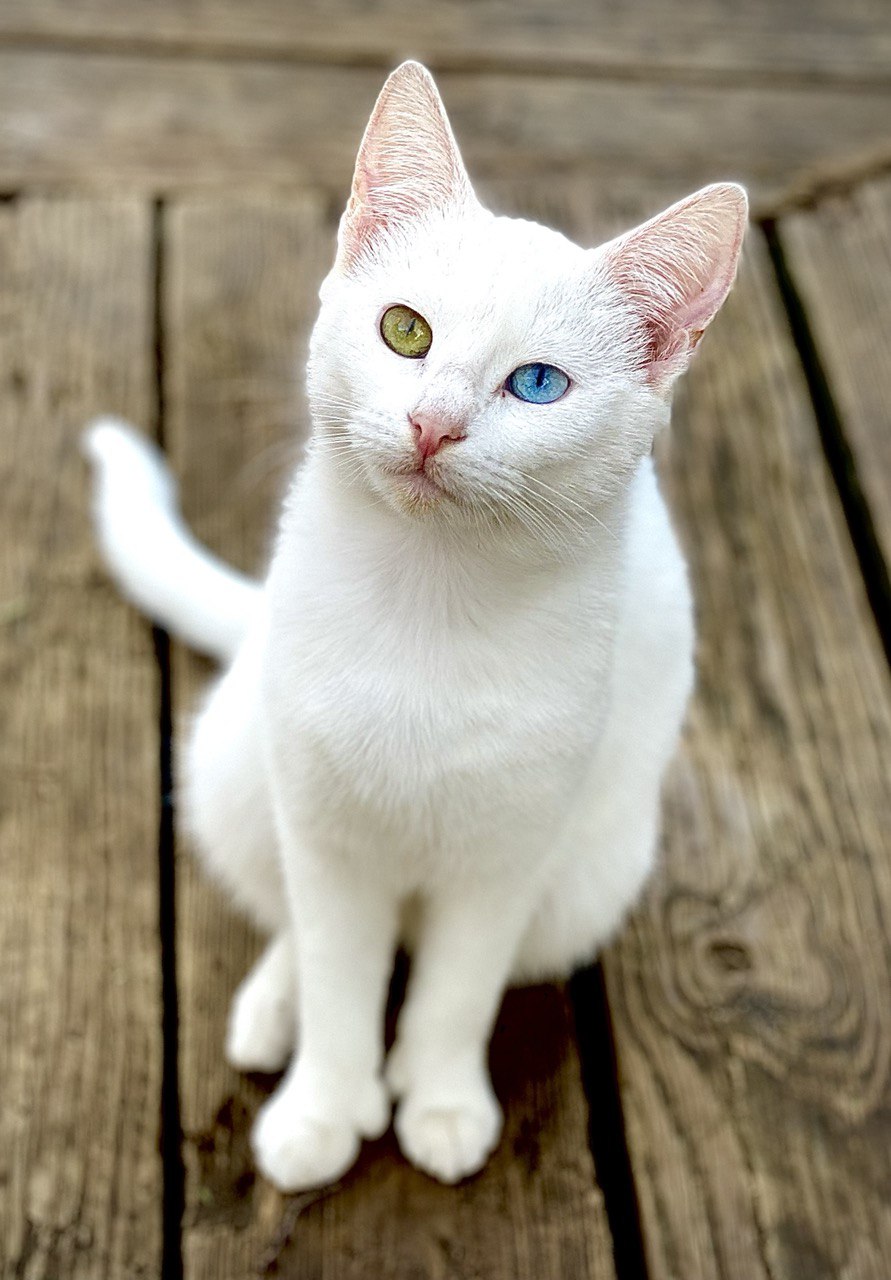



Health has been Quinn's daily passion for almost 25 years, and remains a foundational principle in this community. Our lifestyles are structured in such a way that thriving health is practically built in for us, but not everyone has the luxury of walking barefoot in the garden, basking in the warm glow of sunshine, eating fresh whole foods, drinking clean water, breathing fresh air, limiting stressful activities, and engaging wholesome physical activity each day.
We live solutions, so we began offering the same High Vibe Health supplements we regularly rely on to our extended community across the world over a decade ago.
We have since published extensive educational materials, websites, and books, and gone to hundreds of fairs, festivals, conferences, markets, summits, and events to spread the word, provide the means, and encourage one and all to lead happy and healthy lives!
Please check out the line of High Vibe Health supplements and free information we provide from the Supplements tab here on our website. You can also check out our dedicated website at www.HighVibeHealthSupplements.com.
Additionally, Quinn has authored 2 books on health (Full Spectrum Health and THE BOOK: Ultimate Guide to Health Benefits & Uses of 35% Food Grade Hydrogen Peroxide), with projects currently underway to publish books on each of our supplements in the future.
He also offers consultations and coaching services if and when you need extra insight, motivation, and accountability from a master of solutions to engage your own full spectrum life of THRIVAL!
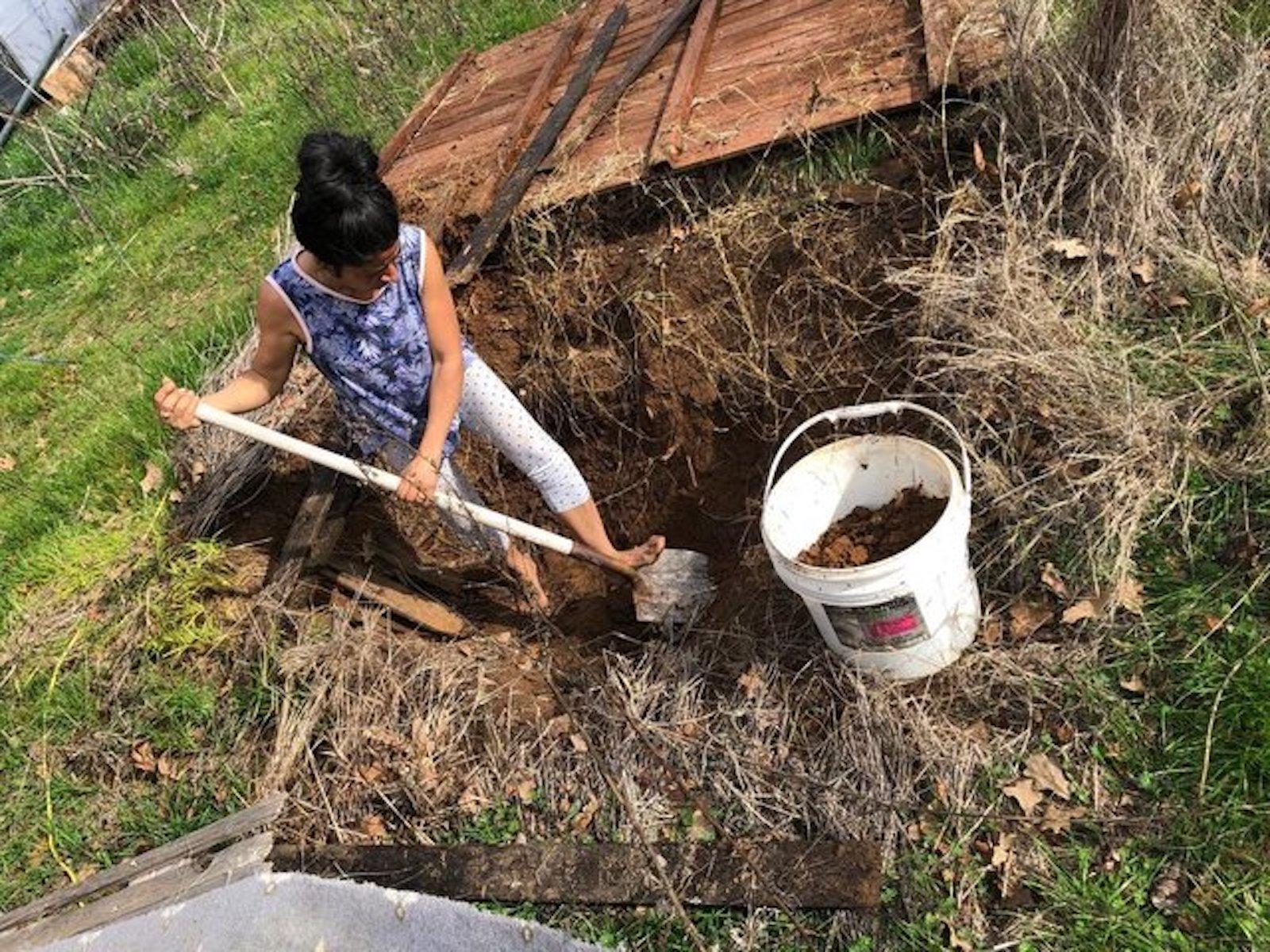

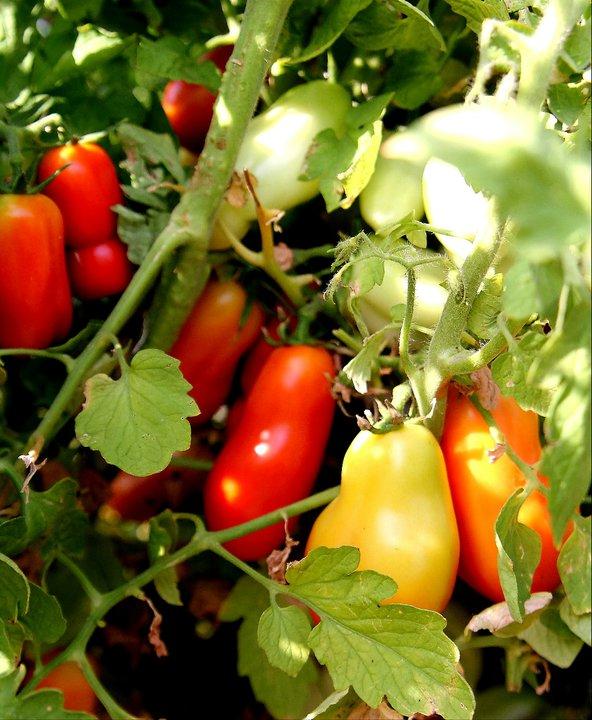
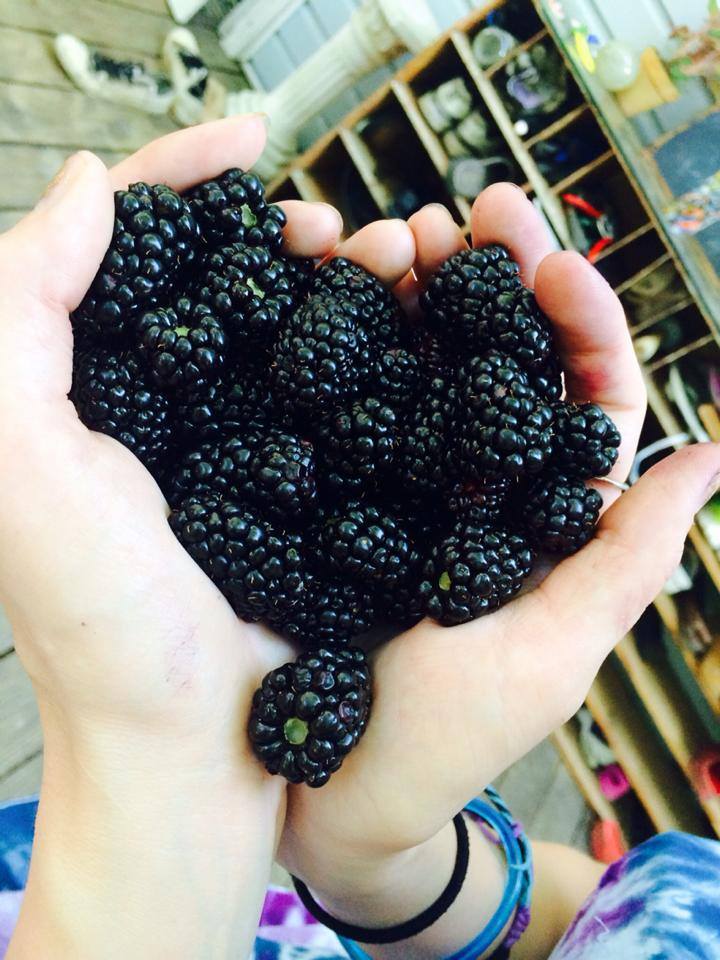
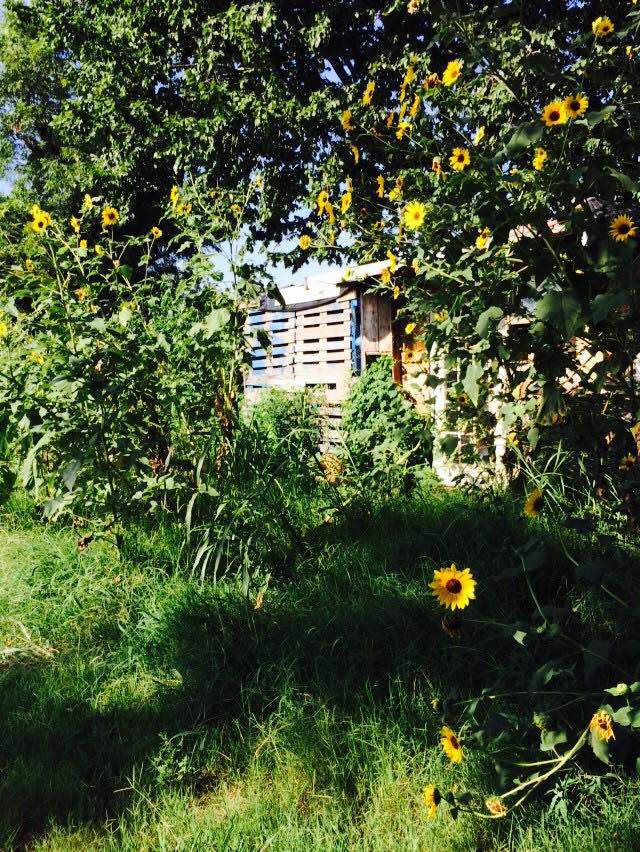
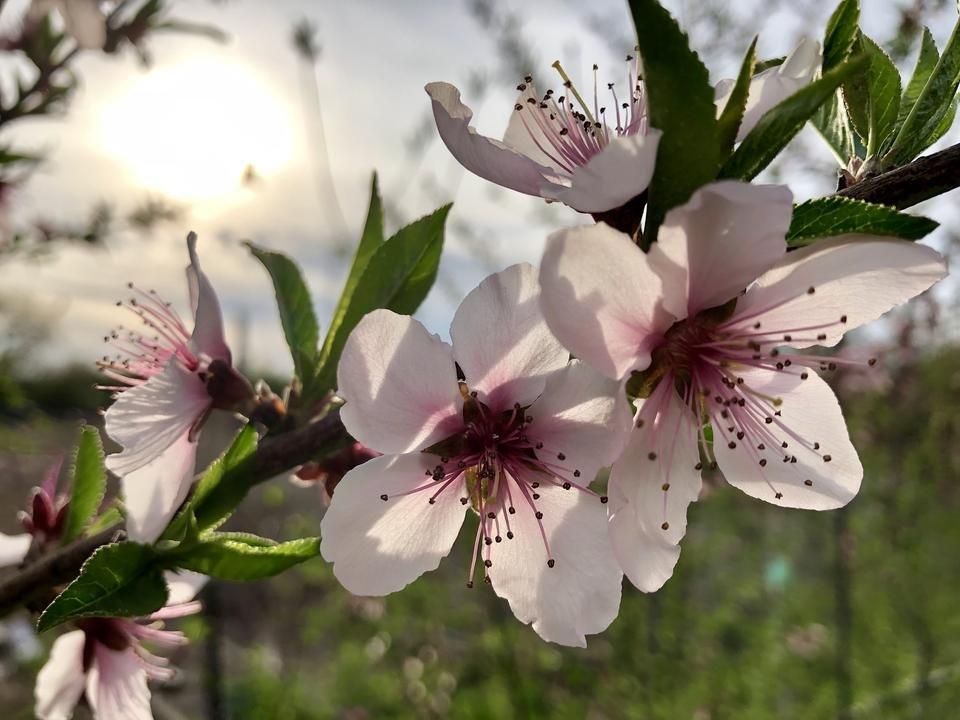
Now that you know a little more about us, do you want to experience The Garden of Eden for yourself?
We invite you to come over & play with us for a day, a week, a month, or longer! Get a taste of our sustainable lifestyle and get inspiration for living the life of your dreams.
We are a members-only private club, so your journey here starts by completing the process for Membership. You can explore various options for Volunteering or Visiting!
